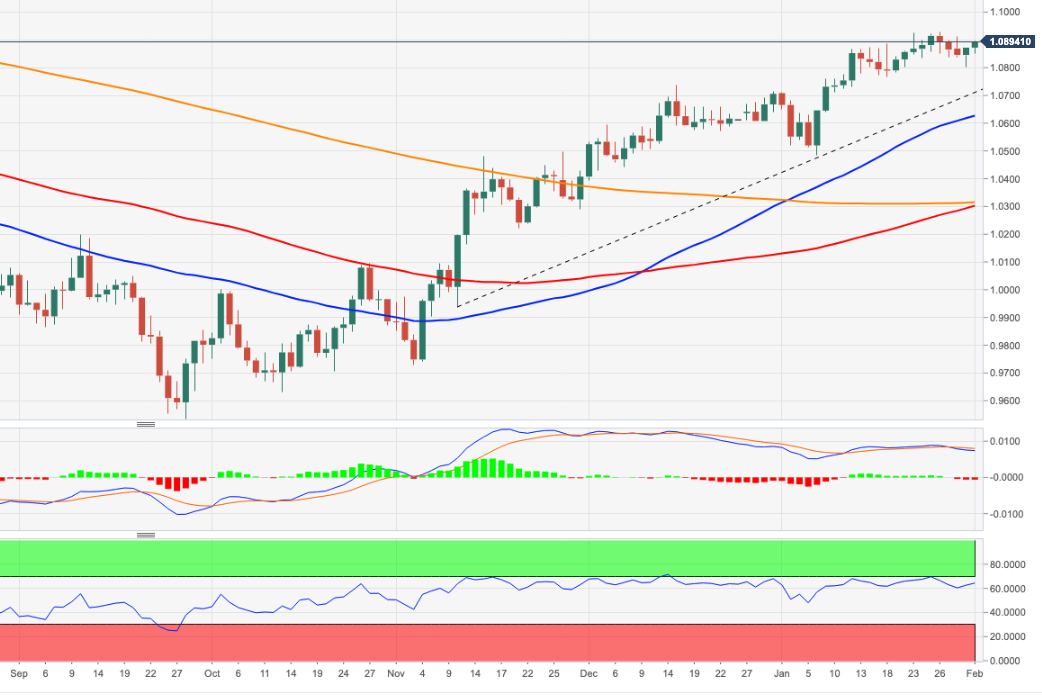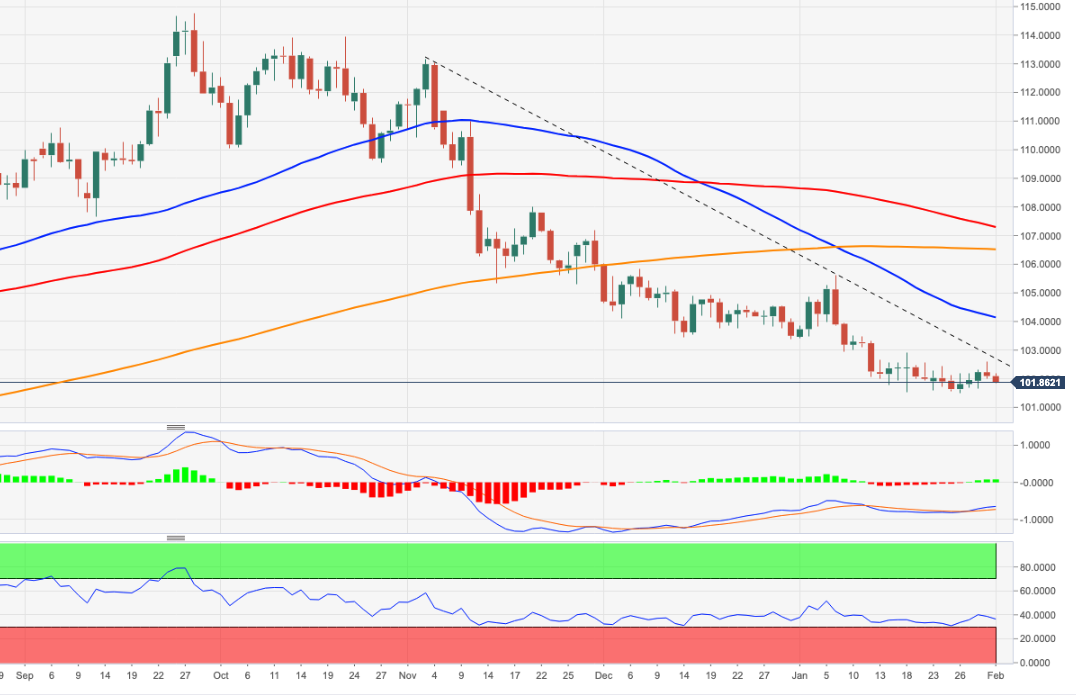- Phân tích
- Tin tức và các công cụ
- Tin tức thị trường
Tin tức thì trường
- AUD/USD bulls have taken the price into the 0.7150s and are on course for the 09.7200s.
- Central bank sentiment is underpinning the Aussie following the Federal Reserve.
AUD/USD is trading at 0.7144 and has ranged between 0.7128 and 0.7157 so far in the Asian session following the Federal Reserve rally after the central; bank had its rates raised by 25bps to a range of 4.50-4.75% and signalled further rate hikes are appropriate.
The statement acknowledged inflation has “eased somewhat” and dropped the references to supply/demand imbalances, high food and energy prices, and broader price pressures. However, Fed guidance is wisely erring on the side of caution. Nevertheless, the greenback was sold off with the Fed funds futures traders expecting the benchmark overnight interest rate to peak at 4.89% in June, before falling back to 4.39% by December. Nevertheless, the Fed's last "dot plot" in December showed that Fed officials expected the rate to rise above 5%.
With that being said, the greenback extended losses on Wednesday and fell to a nine-month low against a basket of currencies after Federal Reserve Chair Jerome Powell's dovish follow-up comments during the Q&A when he spoke of making progress in bringing down inflation pressures. He also noted progress on disinflation, which he said is in its early stages and said the Fed will continue to make decisions on a meeting-by-meeting basis. Powell repeated his code words for no pivot in 2023, but his acknowledgement of the start of the disinflationary process was taken as dovish by the markets and led to a decline in US treasury yields. Analysts at Rabobank said that they continue to think that inflation will be too persistent for the Fed to start cutting rates in 2023.''In fact, in our view the risks are still to the upside.''
Meanwhile, looking at the Aussie, net AUD short positions were little changed for a second week having recently moved to their lowest level since October. Also, it is worth noting that the stronger-than-expected Australian Consumer Price Index inflation data has pushed back on recent speculation that the Reserve Bank of Australia could be nearing the peak of its interest rate cycle. '' The combination of the Fed and RBA sentiment is bullish for AUD and as the following technical analysis illustrates, there could be an advance towards 0.7280 on a break of 0.7250.
AUD/USD technical analysis
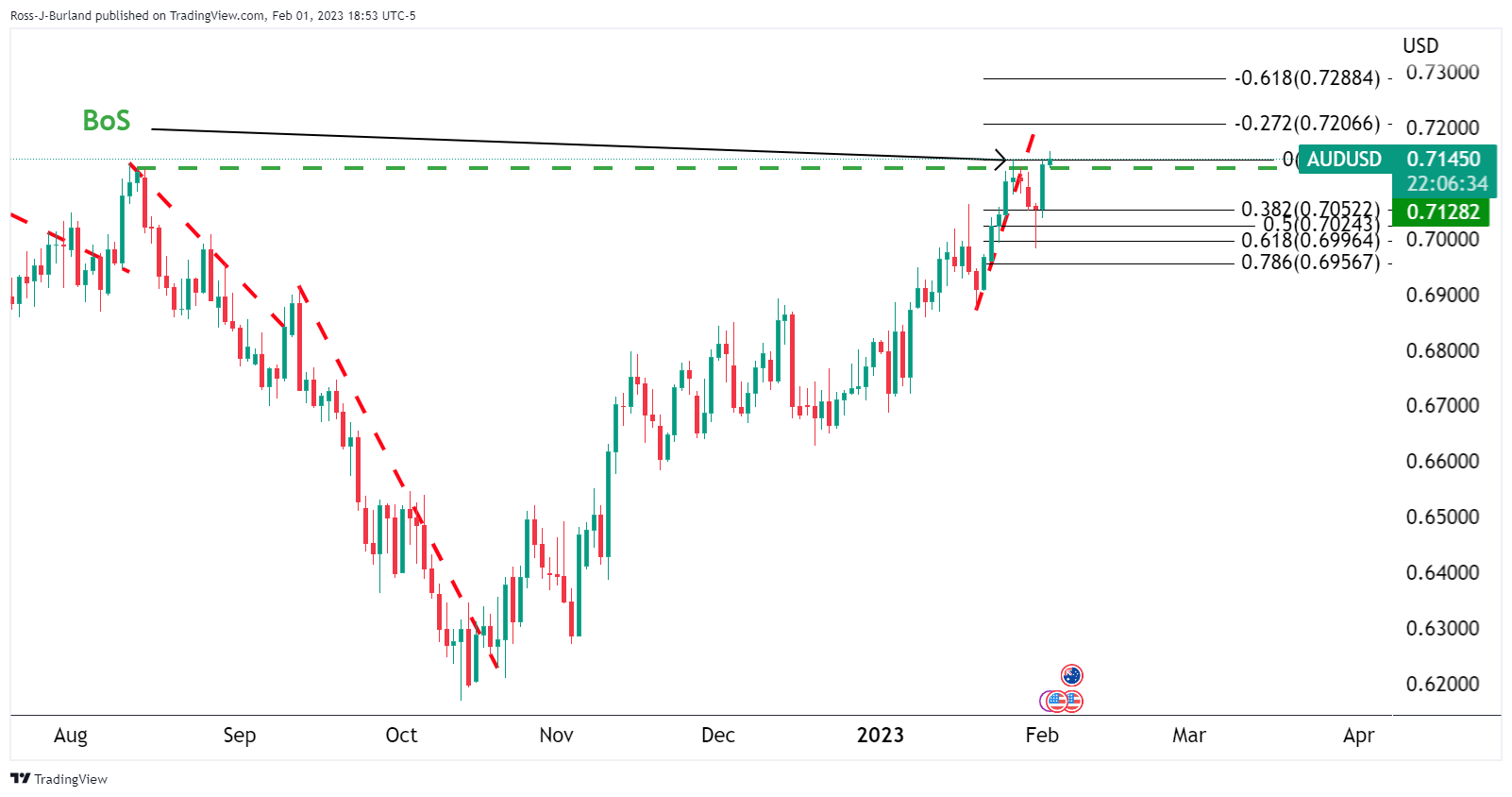
AUD/USD has broken structure around 0.7120/30 and is on the way towards the -272% ratio at 0.7206.
- US Dollar Index dropped the most in three weeks on Fed’s dovish hike.
- Fed matches 0.25% rate hike expectations but cited easing inflation to please DXY bears.
- Federal Reserve Chairman Powell’s readiness for rate cuts, if needed during late 2023 bolstered downside bias.
- Softer US data hints at further weakness but ECB, BoE could entertain traders.
US Dollar Index (DXY) holds lower grounds near 100.90 as traders lick their wounds near the lowest levels since April 2022 during Thursday’s Asian session. In doing so, the greenback’s gauge versus the six major currencies also portrays the market’s cautious mood ahead of the key central bank events and the US Nonfarm Payrolls (NFP).
DXY dropped the most in three weeks after the Federal Reserve’s (Fed) Monetary Policy Statement suggested that the inflation “has eased somewhat but remains elevated”. The same initially allowed the US Dollar bears to take entries even as the US central bank announced a 0.25% Fed rate hike while matching the market’s forecasts.
The US Dollar Index slump, however, took place after the Fed Chair Powell’s press as the policy hawk surprised markets by saying, “We can declare that a deflationary process has begun.” The policymaker also accepts the need for rate cuts during late 2023 if inflation comes down much faster. The policymaker also suggested that a couple more rate hikes are needed to reach it.
Also keeping the DXY bears hopeful were the mixed US data as ISM Manufacturing PMI dropped to the lowest levels since June 2020 while marking 47.4 figure for January, versus 48.0 expected and 48.4 prior. Further, the ADP Employment Change also declined to a one-year low with 106K the latest figure compared to the 178K market forecasts and the upwardly revised previous figure of 253K. On the contrary, JOLTS Job Openings rose to 11.012M in December, crossing 10.25M consensus and 10.44M prior readings.
Against this backdrop, Wall Street rallied and the US 10-year Treasury yields slumped the most in two weeks.
Having witnessed the Fed-inflicted losses, the DXY traders may wait for the monetary policy meetings of the European Central Bank (ECB) and the Bank of England (BoE). Also important to watch will be the US Preliminary Nonfarm Productivity for the fourth quarter (Q4), expected 2.4% versus 0.8% prior. Above all, Friday’s US jobs report for January will be crucial to follow for clear directions.
Technical analysis
A clear downside break of the May 2022 low of 101.30 keeps US Dollar bears hopeful of visiting the 100.00 psychological magnet.
- WTI crude oil licks its wounds around three-week low after falling the most in a month.
- Jump in EIA Crude Oil Stocks Change joined mixed clues surrounding global economic outlook to favor bears.
- OPEC+ left output policy intact, US Dollar slumped on Fed’s dovish hike.
WTI crude oil pares recent losses around the three-week low as it picks up bids to $77.10 during early Thursday in Asia. In doing so, the black gold price seems to cheer the broad US Dollar weakness during a quiet session, after falling the most since early January.
The energy benchmark’s previous slump could be linked to a surprise build in the inventories as the US Energy Information Administration said on Wednesday that the US crude oil and fuel inventories rose last week to their highest levels since June 2021 as demand remained weak. That said, the EIA Crude Oil Stocks Change for the week ended on January rose by 4.14M versus 0.376M expected and 0.533M prior.
While tracing the bearish inventories, the WTI crude oil ignores the fears of intact supply cuts from the major Oil producers. In its latest Joint Ministerial Monitoring Committee (JMMC) meeting, the Organization of the Petroleum Exporting Countries (OPEC) and allies led by Russia, known collectively as OPEC+, left the oil output policy unchanged. That said, OPEC+ agreed to extend the output cuts of 2 million barrels per day, which was assented to in October 2022.
On the same line, the broad-based US Dollar weakness should have also favored the WTI crude oil buyers, but failed. That said, the US Dollar Index (DXY) dropped to a fresh low in late April 2022 after the US Federal Reserve (Fed) announced a dovish rate hike.
It’s worth noting that softer activity data from China Caixin Manufacturing PMI, US ISM Manufacturing PMI and the UK S&P/CIPS Global Manufacturing also weighed on the black gold prices.
Moving on, WTI traders should pay attention to the risk catalysts for fresh impulse. Also important will be the central bank meetings of the European Central Bank (ECB) and the Bank of England (BoE) as they both could affect the US Dollar and the Oil price as well. Furthermore, Europe’s discussions on the Oil price cap for Russian exports are also important to watch for clear directions.
Technical analysis
A daily closing below 50-DMA, around $77.75 by the press time, directs WTI crude oil towards a two-month-old support line, close to $75.25 at the latest.
- GBP/JPY prolonged its agony and dropped for the third time in the week below 160.00.
- GBP/JPY Price Analysis: Break below 159.50 exacerbated a fall towards 158.90, the week’s low.
The British Pound (GBP) failed to gain ground vs. the Japanese Yen (JPY) on Wednesday after the US Federal Reserve (Fed) hiked rates by 0.25%, a signal perceived by market participants as dovish. A reflection of that is Wall Street’s finishing with solid gains. At the time of writing, the GBP/JPY exchanges hand at 159.39 as the Asian session begins.
GBP/JPY Price Analysis: Technical outlook
Technically speaking, the GBP/JPY remains downward biased, as shown by the daily time frame. During the last six trading days, the GBP/JPY was range-bound within the 159.50-161.70 range, unable to gather direction upwards/downwards until Wednesday’s session, in which the pair clashed with the 20-day Exponential Moving Average (EMA) at 160.12, but retraced and dropped below 160.00.
Momentum indicators like the Relative Strength Index (RSI) turning bearish and the Rate of Chang (RoC) registering that sellers are gathering momentum would pave the way for further downside.
Therefore, the GBP/JPY first support would be the February 1 low of 158.90, after testing a one-month-old downslope resistance trendline, turned support. A breach of the latter and the next demand area would be the top of the previously mentioned trendline at 158.70, followed by the January 19 low at 157.56
On the other hand, the GBP/JPY could resume upwards once bulls reclaim the 20-day EMA at 160.12

GBP/JPY Key Technical Levels
- EUR/JPY is struggling to deliver a breakout of the Descending Triangle ahead of the ECB policy.
- The ECB might continue hiking interest rates despite the softened Eurozone HICP.
- Another 50 bps interest rate hike is expected from the ECB.
The EUR/JPY pair has struggled to surpass the critical resistance of 141.75 in the early Tokyo session. The cross is expected to remain sideways till the announcement of the interest rate decision by the European Central Bank (ECB).
On Wednesday, the preliminary headline Eurozone Harmonized Index of Consumer Prices (HICP) softened to 8.5% from the consensus of 9.0% due to easing energy prices. However, the ECB is expected to continue to remain hawkish as the road to price stability is far from over.
Analysts at Danske Bank expect ECB President Christine Lagarde to continue to sound very hawkish and signal that further rate hikes are coming, particularly giving guidance for another 50bps hike in March.
EUR/JPY is auctioning near the downward-sloping trendline of the Descending Triangle chart pattern on an hourly scale, which indicates a contraction in volatility. The downward-sloping trendline of the chart pattern is plotted from January 25 high at 142.29 while the horizontal support is placed from January 25 low at 140.75.
The 20-period Exponential Moving Average (EMA) at 141.40 is overlapping the EUR/JPY price, which indicates a consolidation ahead.
Also, the Relative Strength Index (RSI) (14) is still oscillating in the 40.00-60.00 range, which signifies an absence of a potential trigger.
For an upside move, the cross needs to surpass January 25 high at 142.29, which will drive the asset toward January 11 high at 142.61 followed by October 24 low at 143.72.
On the flip side, a break below January 25 low around 140.76 will be a breakdown of the chart pattern, which will drag the asset towards January 5 low at 140.14. A slippage below the same will expose the cross for more downside toward January 17 high at 139.62.
EUR/JPY hourly chart
-638108904932859037.png)
- NZD/USD crosses two-week-old resistance line to highlight trader’s bullish bias.
- Upbeat MACD, RSI adds strength to the run-up targeting fresh multi-month high.
- Convergence of 61.8% Fibonacci Expansion, June 2022 high appears a tough nut to crack for buyers.
- Sellers need 100-SMA breakdown to confirm further downside.
NZD/USD takes the bids to refresh the weekly high near 0.6520 during early Thursday’s Asian session. In doing so, the Kiwi pair extends its rebound from the 100-SMA to cross a downward-sloping resistance line from January 18.
Not only the successful recovery from the 100-SMA and the trend line breakout but bullish MACD signals and the upbeat RSI (14) also keep NZD/USD buyers hopeful.
As a result, the Kiwi pair is all set to poke the previous monthly high of 0.6530.
It’s worth noting, however, that a convergence of June 2022 high and 61.8% Fibonacci Expansion (FE) of its January 06-19 moves, near 0.6575, appears a strong resistance for the NZD/USD bulls to cross to keep the reins afterward.
On the flip side, pullback remains elusive unless the NZD/USD pair stays above the recent resistance-turned-support line near the 0.6500 round figure.
Even if the NZD/USD price drops below 0.6500 resistance-turned-support, the 100-SMA and the weekly low, respectively around 0.6440 and 0.6410, could challenge the pair’s further downside.
In a case where NZD/USD remains weak past 0.6410, the 200-SMA level near 0.6375 could act as the last defense of the bears.
NZD/USD: Four-hour chart
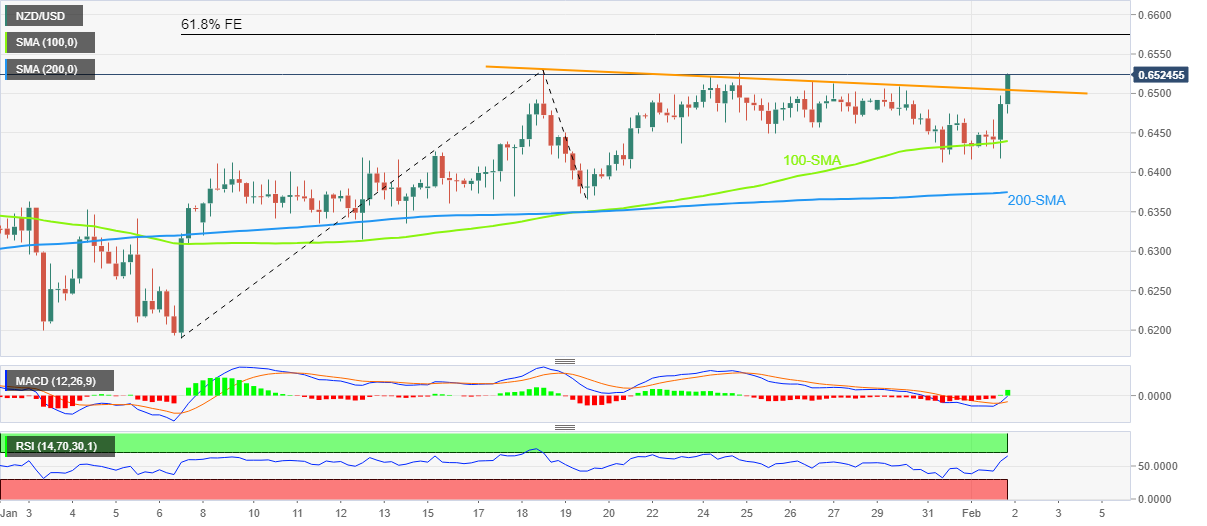
Trend: Further upside expected
- EUR/GBP stays on the front foot after rising the most in seven weeks.
- Euro cheers broad US Dollar weakness, pays little heed to softer Euro Area inflation.
- UK’s “Walkout Wednesday” and downbeat factory output add strength to the pair’s run-up.
- ECB, BoE both are likely to unveil 0.50% rate hike but the future of rate lifts will be the key to follow.
EUR/GBP bulls cheer the broad-based Euro (EUR) strength while refreshing the three-week high near 0.8900, taking rounds to 0.8890 by the press time of early Thursday’s Asian session. Additionally favoring the pair buyers could be the pessimism surrounding the UK workers’ strikes and downbeat factory output data. However, the cautious mood ahead of the monetary policy meeting of the European Central Bank (ECB) and the Bank of England (BoE) seems to probe the cross-currency pair’s further upside.
Also read: BoE Interest Rate Decision Preview: The last 50 bps hike but not the end yet
The Euro rallied the most in seven weeks against the British Pound (GBP) by spreading its broad-based gains from the US Dollar weakness. In doing so, the regional currency ignored downbeat inflation data at home. That said, the preliminary readings of the Euro area Harmonised Index of Consumer Prices (HICP) dropped to 8.5% YoY versus 9.0% expected and 9.5% prior. The Core HICP, however, came in unchanged at 5.2% compared to 5.1% market forecasts.
It should be noted that the US Federal Reserve’s (Fed) dovish hike could be held responsible for the US Dollar’s slump on Wednesday, which in turn allowed the EUR to rally against most counterparts.
Also fueling the EUR/GBP prices could be the mass strikes in the UK, as well as downbeat factory output. “Up to half a million British teachers, civil servants, and train drivers walked out over pay in the largest coordinated strike action for a decade on Wednesday, with unions threatening more disruption as the government digs its heels in over pay demands,” said Reuters.
On the other hand, the S&P Global/CIPS UK Manufacturing PMI confirmed a consecutive sixth monthly contraction in factory output with 47.0 figure versus 46.7 initial forecasts. “Weak demand from clients at home and abroad plus strong price inflation and a shortage of raw materials and staff all weighed on production. Brexit and port problems hurt exports while demand from China was particularly weak,” S&P Global said per Reuters.
On a broader front, Fed Chair Jerome Powell’s shift in favor of the rate cuts, if needed during late 2023, propelled bond-buying and equities, which in turn allowed the Euro to remain firmer ahead of the key ECB.
Moving on, market players will be more interested in the hints for slower rate hikes as both the central banks, namely the ECB and the BoE, are likely to announce 0.50% rate lift. It’s worth noting that the comparative economic soundness in the bloc and more hawkish comments from the ECB policymakers in the last couple of days favor the EUR/GBP bulls.
Also read: European Central Bank Preview: Lagarde needs to repeat her hawkish message
Technical analysis
Although the successful upside break of the 21-DMA, around 0.8815 by the press time keeps the EUR/GBP buyers hopeful, an upward-sloping resistance line from early November 2022, close to 0.8910 at the latest, appears a crucial hurdle for the pair traders to watch.
- USD/CHF has printed a fresh two-week low at 0.9070 as Fed scales down the policy tightening pace.
- The downbeat US Manufacturing PMI failed to impact the risk appetite theme.
- A spell of contraction in Swiss Real Retail Sales might force the SNB to avoid policy restrictions.
The USD/CHF pair has refreshed its two-week low at 0.9070 in the early Asian session. The downside pressure in the Swiss franc asset is built on a smaller interest rate hike announcement by the Federal Reserve (Fed). Fed chair Jerome Powell has stretched interest rates by 25 basis points (bps) to 4.50-4.75%, citing the requirement of maintaining policy significantly restrictive to address stubborn inflation.
The commentary from Fed’s Powell signifies that the Consumer Price Index (CPI) is clearly in a downtrend led by subdued consumer spending, a weak housing sector, and a slowdown in the United States' economic activities. However, the Fed will continue hiking interest rates to make monetary policy sufficiently restrictive as it needs more evidence to be confident inflation is on a downward path.
Despite Fed's hawkish guidance, the US Dollar Index (DXY) failed to hold the cushion of 101.00 and printed a fresh nine-month low at 101.64. S&P500 soared vigorously on a less-hawkish monetary policy by the Fed. The 500-US stock basket ignored the downbeat release of the United States ISM Manufacturing PMI (Jan). Manufacturing PMI dropped consecutively for the third time as higher interest rates by the Fed have resulted in lower consumer spending, which forced firms to avoid deploying full operational capacity. The economic data dropped to 47.4 lowest since May 2020 reading.
Apart from that, Automatic Data Processing (ADP) Employment data landed at 106K significantly lower than the estimates of 178K and the former release of 253K.
On the Swiss franc front, annual Real Retail Sales (Dec) data has contracted by 2.8% while the street was expecting an expansion of 2.6%. The economic data has been contracting consecutively for the past three months and is likely to force the Swiss National Bank (SNB) to avoid considering a restrictive stance on interest rates.
- USD/CAD licks its wounds after refreshing 11-week low.
- Bearish MACD signals, sustained trading below 21-DMA keeps sellers hopeful.
- 200-DMA, 1.3210 level act as the last defenses for the buyers.
USD/CAD jostles with a key support line after refreshing the multi-month low on the Federal Reserve’s (Fed) dovish hike, making rounds to 1.3290 during early Thursday morning in Asia. In doing so, the Loonie pair portrays sustained trading below the 21-DMA while also justifying the bearish MACD signals and downbeat RSI, not oversold.
It’s worth noting that an ascending trend line from June 2022, close to 1.3290 at the latest, challenges the pair sellers of late.
The major attention, however, should be given to the horizontal area comprising multiple levels marked since mid-July 2022 and the 200-DMA, between 1.3225 and 1.3210.
In a case where the USD/CAD pair stays weak below 1.3210, the 1.3200 round figure may act as an extra filter towards the south before directing prices towards the 1.3000 psychological magnet. It should be observed that June 2022 peak surrounding 1.3080 may offer an intermediate halt during the slump past 1.3200.
Meanwhile, USD/CAD recovery remains elusive until the quote remains below the 21-DMA hurdle of 1.3390.
Following that, the late January swing high near 1.3520 and the previous monthly top surrounding 1.3685 will be in focus.
Though, the USD/CAD bull-run needs validation from the December 2022 peak of 1.3705.
Overall, USD/CAD remains on the bear’s radar but the downside room appears limited.
USD/CAD: Daily chart
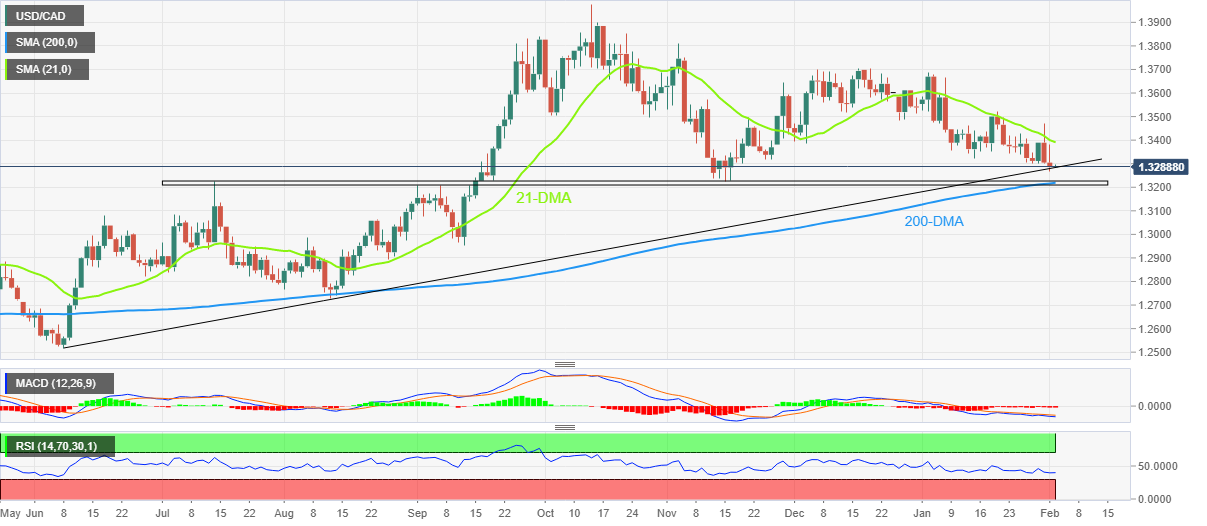
Trend: Limited downside expected
- The AUD/JPY cleared the 50/200/100-day Exponential Moving Averages (EMAs) on its way to 92.20s.
- AUD/JPY: A tweezers bottom candle chart pattern to pave the way for further upside.
The Australian Dollar (AUD) recovered some of its lost ground against the Japanese Yen (JPY) and rises, aligned with risk-perceived assets, bolstered by the US Federal Reserve (Fed) decision to raise rates by a quarter of a percentage, to 4.50% - 4.75% range, with the market’s perception of a dovish Fed. At the time of writing, the AUD/JPY exchanges hands at 91.99 after hitting a daily low of 91.21, above its opening price by 0.31%.
AUD/JPY Price Analysis: Technical outlook
After the Fed’s decision, the AUD/JPY pair rebounded off the day’s low at 91.21, as market sentiment remained sour ahead of the Fed’s meeting. Once the headlines crossed newswires and Powell’s presser began, the AUD/JPY edged up, clearing on its way north the 50, 200, and 100-day Exponential Moving Averages (EMAs), each at 91.31, 91.55, and 91.95, respectively.
As the New York session is about to end, an AUD/JPY close above the 100-day EMA will exacerbate a rally towards the January 26 swing high at 92.81. Once the spot price claims above the latter, the 93.00 figure would be next; after that, the December 13 daily high at 93.35 would be tested.
As an alternate scenario, the AUD/JPY first support would be the 200-day EMA at 91.55. Break below would send the pair sliding towards the 50-day EMA At 91.33, ahead of the February 1 low at 91.21.
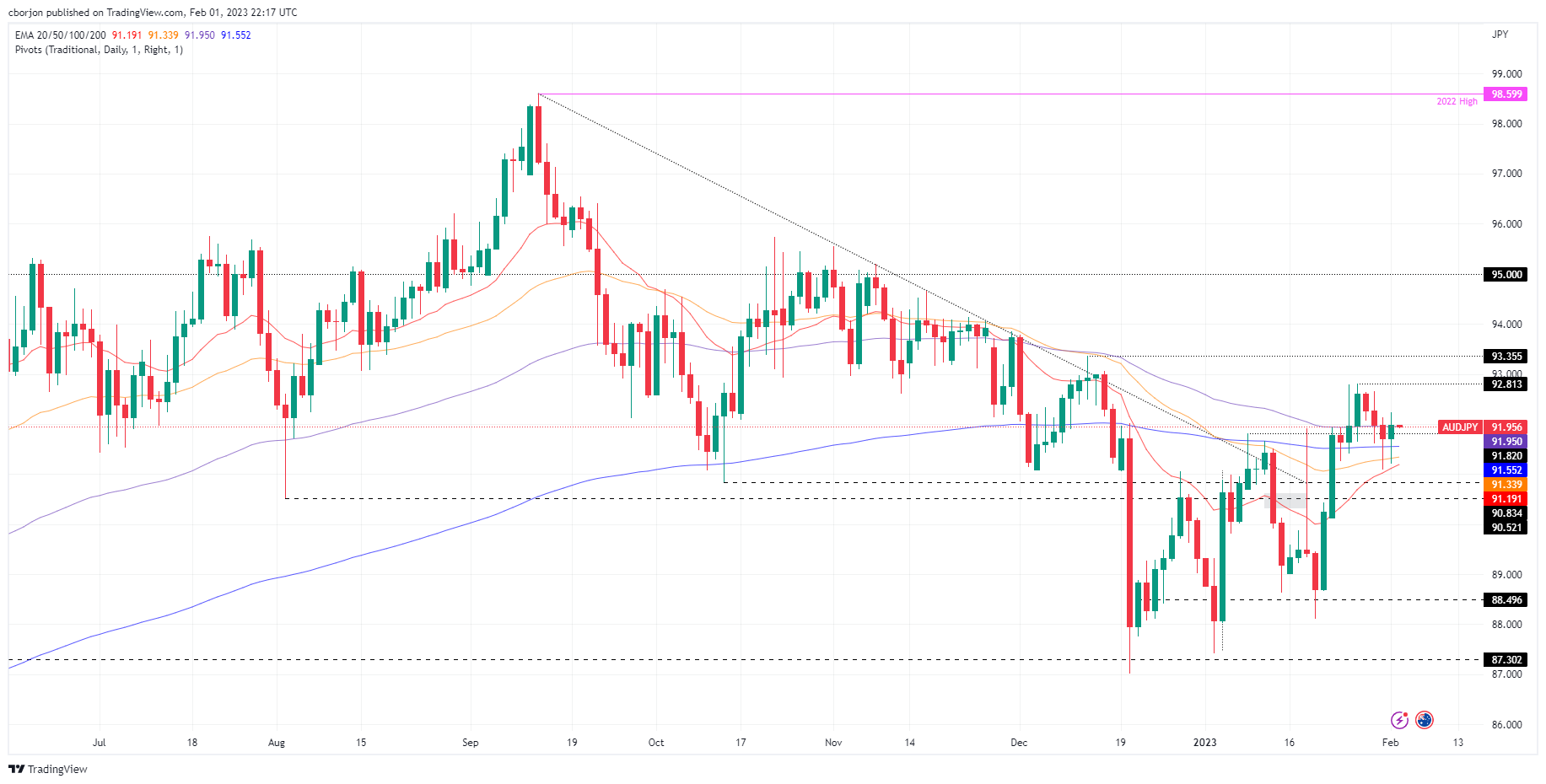
AUD/JPY Key Technical Levels
- AUD/USD has displayed a vertical rally as the Fed has slowed the pace of policy tightening further.
- The Aussie asset has shifted above the 61.8% Fibo retracement at around 0.7100.
- Upward-sloping 20-EMA adds to the upside filters.
The AUD/USD pair printed a fresh seven-month high at 0.7145 in the late New York session. The Aussie asset displayed a perpendicular rally after the Federal Reserve (Fed) announced a 25 basis point (bps) interest rate hike to continue tightening monetary policy further to achieve price stability. Fed chair Jerome Powell is denied consideration of cutting rates this year as the central bank has a lot more to do to reach the 2% inflation target.
The US Dollar Index (DXY) is hovering around a fresh nine-month low at 100.64 and is expected to remain in the negative trajectory amid the risk appetite theme underpinned by the market participants.
AUD/USD has scaled above the 61.8% Fibonacci Retracement (placed from April 5 high at 0.7661 to October 13 low at 0.6170) at 0.7095, which supports the upside bias, placed on the daily scale. Upward-sloping 20-period Exponential Moving Average (EMA) at around 0.7000 is acting as major support for the Australian Dollar.
The Relative Strength Index (RSI) (14) is oscillating in the bullish range of 60.00-80.00, which indicates that the upside momentum has already been triggered.
For further upside, the Aussie asset needs to surpass June 9 high of around 0.7200, which will drive the asset toward June 7 high at 0.7247 followed by June 3 high at 0.7283.
On the contrary, a downside move below the psychological support of 0.7000 will drag the asset toward a 50% Fibo retracement at 0.6916. A slippage below the latter will drag the asset toward January 19 low at 0.6972.
AUD/USD daily chart
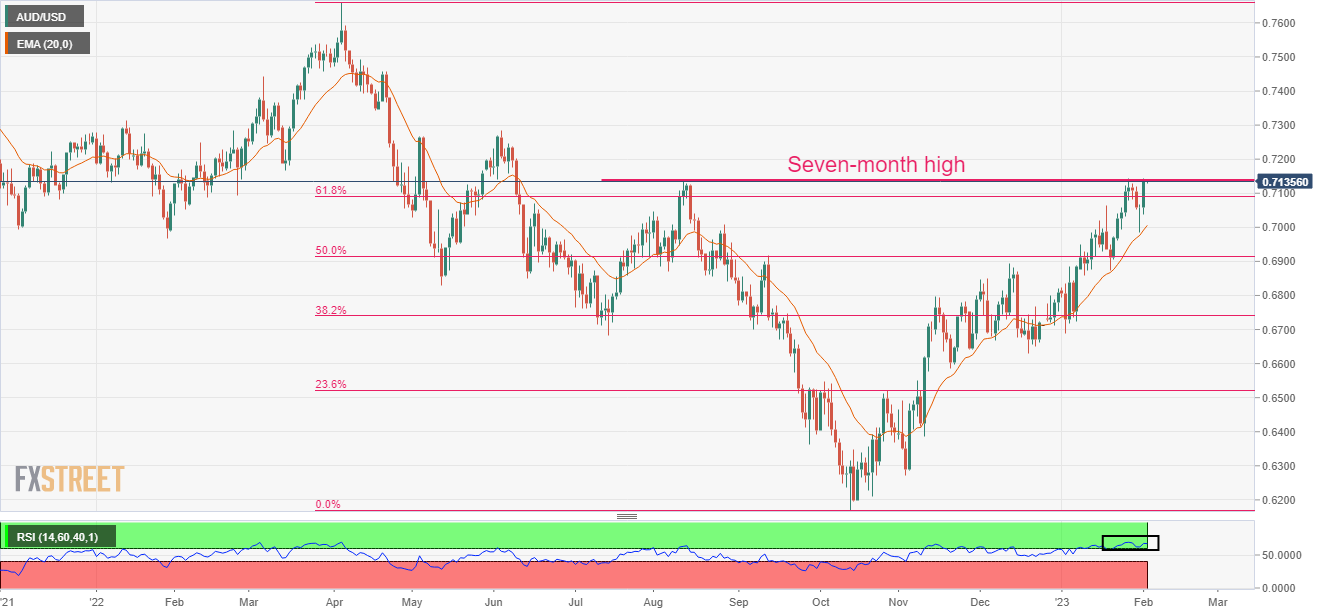
- EUR/USD bulls take a breather around multi-day top after rising the most in three months.
- Fed announced 0.25% rate hike as expected but Chairman Powell’s hint for rate cuts drowned US Dollar.
- Softer EU inflation, mixed US data failed to impress EUR/USD traders ahead of today’s ECB.
- ECB is likely announcing 0.50% rate hike, focus on easing of rate lifts.
EUR/USD bulls cheer the Federal Reserve’s (Fed) acceptance of easing price pressure, as well as Chairman Jerome Powell’s readiness for rate cuts if needed, by rising the most since November 2022 to poke the highest levels in 10 months, making rounds to 1.0990 at the latest. While the Fed-inspired rally appeared impressive, the major currency pair’s more moves appear to less likely ahead of the European Central Bank (ECB) monetary policy announcement, up for publishing during Thursday’s European session.
The Fed finally accepted that the inflation pressure in the US are abating of late while altering the Monetary Policy Statement wording to suggests that it “has eased somewhat but remains elevated”. The same initially allowed the US Dollar bears to take entries even as the US central bank announced a 0.25% Fed rate hike while matching market’s forecasts.
The greenback’s notable slump, however, took place after the Fed Chair Powell’s press as the policy hawk surprised markets by saying, “We can declare that a deflationary process has begun.” The policymaker also accepting the needs for rate cuts during late 2023 if inflation comes down much faster. The policymaker also suggested that a couple more rate hikes are needed to reach it.
It’s worth noting that the softer Eurozone inflation and the mixed US data previously challenged EUR/USD traders. That said, the preliminary readings of Euro area Harmonised Index of Consumer Prices (HICP) dropped to 8.5% YoY versus 9.0% expected and 9.5% prior. The Core HICP, however, came in unchanged at 5.2% compared to 5.1% market forecasts.
On the other hand, US ISM Manufacturing PMI dropped to the lowest levels since June 2020 while marking 47.4 figure for January, versus 48.0 expected and 48.4 prior. Further, the ADP Employment Change also declined to the one-year low with 106K be the latest figure compared to the 178K market forecasts and upwardly revised previous figure of 253K. On the contrary, JOLTS Job Openings rose to 11.012M in December, crossing 10.25M consensus and 10.44M prior readings.
Amid these plays, Wall Street rallied and the US 10-year Treasury yields slumped the most in two weeks.
Moving on, ECB is the key for the EUR/USD pair not only because it is up for announcing the 50 bps rate hike but also because the market doesn’t believe in the hawkish rhetoric of the policymakers and aim for hints of easy rates.
Also read: European Central Bank Preview: Lagarde needs to repeat her hawkish message
Technical analysis
A clear upside break of the seven-week high ascending trend line, close to 1.0960, directs EUR/USD towards March 2022 peak surrounding 1.1185.
- Gold price jumps on dovish Federal Reserve tilt.
- The US Dollar drops as markets price in a pivot at the Federal Reserve.
Gold price shot higher to a fresh bull cycle high on the back of the Federal Reserve's dovish tilt that markets have priced in, smelling a 'Fed-pivot' around the corner, bullish for the Gold price.
At the time of writing, the Gold price is trading at $1,950 and has rallied from a low of $1,920.58 reaching as high as $1,954.64. The Fed terminal rate has fallen to under 4.9% amid Federal Reserve's chair Powell's comments that followed the eighth rate hike in a year. However, the Federal Reserve slowed its pace to a quarter of a point in a nod to an improved inflation outlook, underpinned by Federal Reserve's chairman, Jerome Powell, when he took questions from the press.
Federal Reserve Jerome Powell's key comments
"We can now say for the first time that the disinflationary process has started".
-
Powell speech: Very difficult to manage the risk of doing too little on rates
-
Powell speech: Disinflationary process is in early stages
-
Powell speech: History cautions against prematurely loosening policy
-
Powell speech: Well-anchored longer-term inflation expectations not grounds for complacency
-
Powell speech: Will likely have to maintain restrictive stance for some time
-
Powell speech: Very difficult to manage the risk of doing too little on rates
-
Powell speech: Policymakers did not see this as a time to pause
-
Powell speech: Will not be appropriate to cut rates this year according to our current outlook
Meanwhile, the Federal Reserve was retaining its prior language in the statement and Fed fund futures are still pricing in rate cuts this year, with the Fed funds rate seen at 4.486% by end of December, unchanged prior to the Fed decision. The March Federal Reserve meeting is priced in at 85% for 25 bps with the remainder at no change.
United States data supports higher Gold price
In data from the United States, The January ADP jobs report undershot expectations, with private sector jobs up 106k in January, versus 253k previously (and 180k expected) and this data will still cast some doubt over forecasts for a firm January Nonfarm Payrolls print. The US ISM Manufacturing index fell further in January, dropping to 47.4 (48.4 previously). That’s the third month in a row of contraction (below 50).
Gold price technical analysis
The Gold price is now carving out a fresh high on the front side of the dominant trendline. To the downside, bears need to get below $1,920 again to cement a bearish bias for the foreseeable future while bulls need to stay above $1,950 and then get over $1,980:
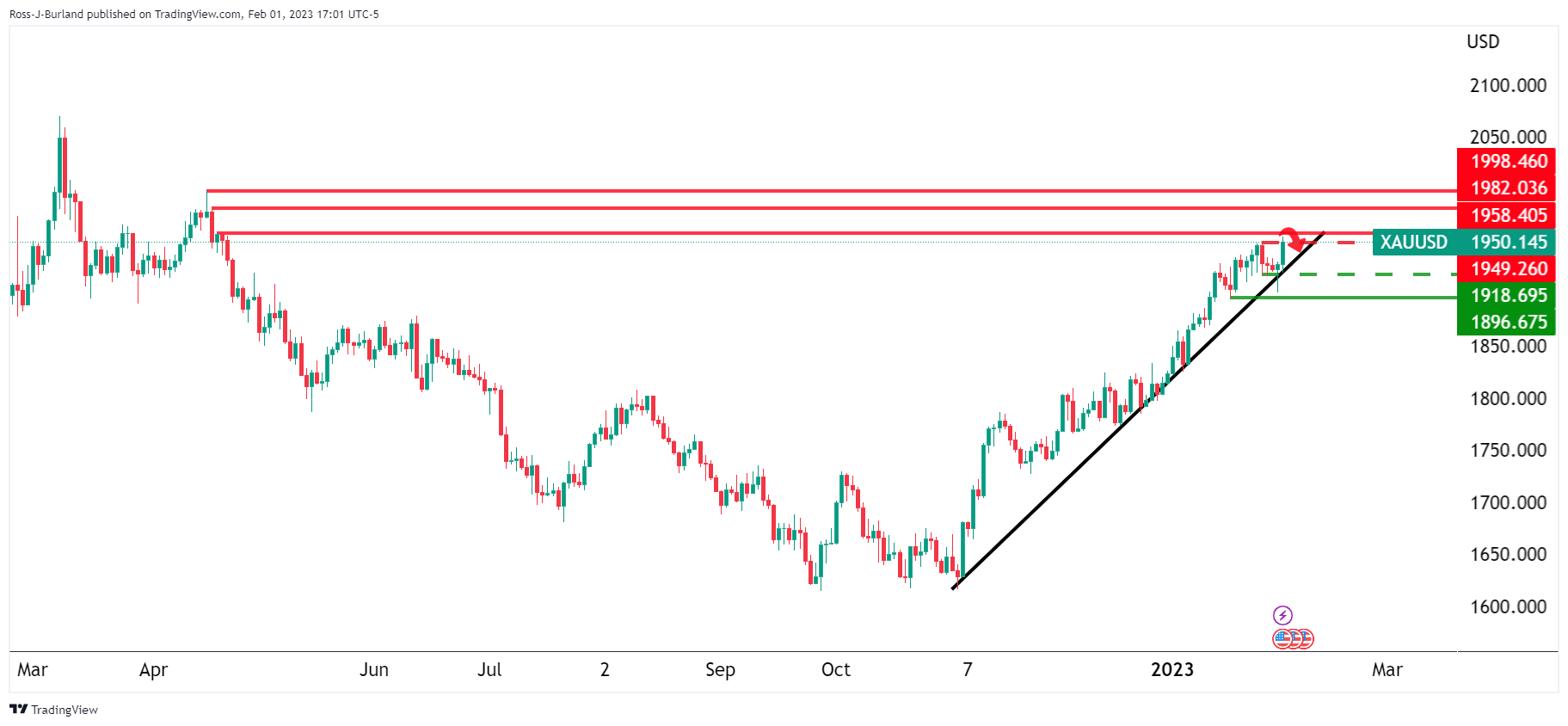
- GBP/USD has scaled firmly to near 1.2400 as Fed has announced a 25 bps interest rate hike.
- The USD Index has shifted below 101.00 for the first time in nine months amid a risk-on mood.
- To tame double-digit inflation, the BoE is set to announce a tenth consecutive interest rate hike.
The GBP/USD pair has displayed a juggernaut rally to near the round-level resistance of 1.2400 in the late New York session. The Cable has been infused with an adrenaline rush after the interest rate decision by the Federal Reserve (Fed) chair Jerome Powell met expectations. Fed chair Jerome Powell has pushed interest rates to the 4.50-4.75% range by announcing a 25 basis point (bps) hike as the central bank needs more evidence to be confident that inflation is on a downward path.
The US Dollar Index (DXY) has surrendered the critical support of 101.00 for the first time in the past nine months. The USD Index has refreshed its nine-month low at 100.64 despite the Fed having denied the speculation of pausing further restrictions on monetary policy this year. Meanwhile, S&P500 has settled Wednesday’s trading session on a bullish note. The 500-US stock basket recovered initial losses and ended the session with significant gains, portraying a significant improvement in the risk appetite of the market participants.
A smaller interest rate hike by the Fed has strengthened the demand for US government bonds, which led to a decline in the 10-year US Treasury yields to near 3.42%. The US Treasury yields nosedived despite the Fed clearing that the context of cutting interest rates this year is not in the picture.
Well, after sheer volatility in the FX domain inspired by Fed’s interest rate policy, investors are shifting their focus towards the interest rate policy by the Bank of England (BoE), which is scheduled for Thursday. BoE Governor Andrew Bailey looks set to announce a tenth consecutive interest rate hike to tame the double-digit inflation figure. According to a poll from Reuters, Investors are mostly betting on another half percentage-point increase to 4.0% and that Bank Rate will peak at 4.5% soon.
What you need to take care of on Thursday, February 2:
The US Dollar plummeted following the US Federal Reserve’s monetary policy decision. The central bank decided to hike its benchmark rate by 25 basis points (bps) as widely anticipated by market players. The statement showed that policymakers changed the wording on inflation, noting that it “has eased somewhat but remains elevated,” although there were no other relevant changes to the document. Furthermore, it noted that the Committee believes that “ongoing increases in the target range will be appropriate” to return inflation to 2%, hinting at more rate hikes in the docket.
US Fed Chair Jerome Powell started his statement by repeating the Fed is strongly committed to reaching its 2% inflation target. He also repeated that job gains have been robust, and the unemployment rate has remained low. However, he later added that, for the first time, “we can declare that a deflationary process has begun.” On the appropriate restrictive level, Powell said that a couple more rate hikes are needed to reach it. Finally, he ended up admitting that rate cuts could take place this year “if inflation comes down much faster.” Following the event, the US Fed Terminal Rate fell to under 4.9%, while the end-2023 Fed Funds Rate fell below 4.4%, as markets are still pricing in rate cuts for this year.
European inflation eased more than anticipated in January, according to preliminary estimates. The Harmonized Index of Consumer Prices (HICP) rose at an annualized pace of 8.6%. The news helped EUR/USD to overcome the 1.0900 threshold ahead of the US Federal Reserve’s announcement, with the pair ending the American session near a multi-month high of 1.1000 afterwards. The European Central Bank will announce its monetary policy decision on Thursday.
The GBP/USD pair struggled throughout the day to extend gains beyond 1.2300, as investors await the Bank of England monetary policy decision. The BoE is set to raise rates by another 50 basis points, while market players will be looking for clues about an easy pace of tightening from March on. It settled at 1.2370, up on the broad US Dollar weakness.
Commodity-linked currencies benefited from the positive tone of Wall Street, with AUD/USD hovering around 0.7140 and USD/CAD down to 1.3280. Finally, USD/JPY trades at around 128.90.
Spot gold soared and currently hovers at around $1,950 a troy ounce.
Crude oil prices edged lower as the OPEC+ meeting began, with no production changes on the agenda. A build in US inventories as reported by EIA also weighed on crude prices, as US stockpiles were up by 4.14 million in the week ended January 27. At the time being, WTI trades at around $76.90 a barrel.
Fed remains hawkish with 25 bps hike, how will Bitcoin price react?
Like this article? Help us with some feedback by answering this survey:
- NZD/USD pops on a troubled US Dollar hit by dovish tilt at the Fed.
- Markets smell a pivot coming and price in lower rates, weighing in the greenback.
NZD/USD has popped on the back of the market smelling a pivot at the Federal Reserve with the Fed terminal rate has fallen to under 4.9% amid chair Powell's comments. At the time of writing, NZD/USD is trading at 0.6500 and has rallied from a low of 0.6416 to a high of 0.6505 so far.
The Federal Reserve's dovish tilt, despite inflation, ''running very hot'', has weighed heavily on the greenback as traders move into risk-positive asset classes, such as commodities and stocks, supporting the high beta NZD. The Federal has increased interest rates for the eighth time in a year but slowed its pace to a quarter of a point in a nod to an improved inflation outlook. There was an initial bid in the greenback but it soon turned sour for the US Dollar bulls and the sell-off gathered pace as the cracks in Fed's chairman's, Jermoe Powell, comments started to reveal a dovish shift at the Fed.
Fed chair key comments
"We can now say for the first time that the disinflationary process has started".
-
Powell speech: Very difficult to manage the risk of doing too little on rates
-
Powell speech: Disinflationary process is in early stages
-
Powell speech: History cautions against prematurely loosening policy
-
Powell speech: Well-anchored longer-term inflation expectations not grounds for complacency
-
Powell speech: Will likely have to maintain restrictive stance for some time
-
Powell speech: Very difficult to manage the risk of doing too little on rates
-
Powell speech: Policymakers did not see this as a time to pause
-
Powell speech: Will not be appropriate to cut rates this year according to our current outlook
NZD now depends on RBNZ
Analysts at ANZ Bank said that ''with local markets firmly embracing “just” a 50bp RBNZ hike later this month, the NZD’s prospects are somewhat capped, but if the USD continues to crumble, that’s an offset. So there are plenty of balls in the air, and we remain attuned to volatility rather than directionality.''
''Yesterday’s NZ labour market report for Q4 still portrayed a labour market beyond ‘maximum sustainable employment’. However, the data were weaker across the board than the Reserve Bank of New Zealand expected back in November, with unemployment rising slightly, jobs growth slowing sharply, and wages (while still very strong) coming in below their expectation,'' the analysts added. ''Combine a softer employment report with Q4’s weaker-than-expected non-tradables inflation print last week, and we think there’s strong evidence that the RBNZ should downshift to a 50bp OCR hike at their 22 February meeting.''
- USD/JPY was rejected at the 20-day EMA and collapsed as the Federal Reserve increased rates by 25 bps.
- Federal Reserve officials stated that more increases would be appropriate in 25 bps increments.
- Powell’s disinflationary comments tumbled US Treasury bond yields and sent the US Dollar into a tailspin.
USD/JPY is plummeting sharply after the US Federal Reserve decided to slow down the pace of rate increases and hiked rates by 0.25% on their first monetary policy meeting of 2023. Therefore, the US 10-year Treasury bond yield is plunging more than ten bps toward 3.40% as the market responds to the Fed’s decision and Powell’s speech. At the time of writing, the USD/JPY exchanges hands in a volatile session at around 128.50-129.20.
Some remarks of the Federal Reserve Chair Jerome Powell
At the time of typing, the US Federal Reserve Chair Jerome Powell’s press conference continues, and the US Dollar continues to weaken across the board.
In his press conference, Powell said it would be premature to declare victory on inflation and said that the job is not fully done. He acknowledged that “it’s a good thing that disinflation so far has not come at expense of the labor market.”
Powell added that the Federal Open Market Committee (FOMC) has not decided on a terminal rate, and if data becomes weaker, then the central bank would become data-dependant. He added the Fed has no desire to overtighten, but if they do, they have the tools to work on it.
When asked about discussions in the meeting, Powell said they were talking about a couple more rate hikes to get to an “appropriately restrictive stance.”
Summary of the Fed’s monetary policy statement
On Wednesday, the Federal Reserve policymakers decided unanimously to hike rates by 0.25%, lifting the Federal Funds rate (FFR) at around 4.50% - 4.75%. Additionally, they pushed back against the market’s expectations for a Fed pivot and said additional rate hikes would be appropriate. Policymakers forward guided the market, adding that future rate hikes would be in 25 bps increments, dropping the reference to the “pace” of additional rate hikes.
Fed officials acknowledged that inflation has “eased somewhat but remains elevated.” Participants added that indicators point to modest growth in spending and production and commented that the labor market remains robust. Fed members stated, “in determining the extent of future rate hikes, it will take into account cumulative tightening, policy lags, and economic and financial developments.”
USD/JPY reaction to the headline

The USD/JPY 15-minute chart shows the pair tumbled below 129.50 and broke support levels, like the S2 and the S3 daily pivot points, each at 129.32 and 128.90. Then, it continued towards the day’s low at 128.54, reversing its course and reclaiming the S3 pivot point. Then the USD/JPY tested the 20-EMA at 129.21 before resuming its downtrend. The USD/JPY, the first support level, would be the S3 pivot at 128.90, followed by the daily low at 128.54, and then the S4 daily pivot at 128.48.
- USD/CAD breaks below 1.3300 momentarily as a dovish tilt at the Fed is priced in.
- Bears enthused by Fed's Powell arguing that the disinflationary process has started.
USD/CAD is under pressure and scoring fresh multi-day lows to 1.3274 so far from a high of 1.3379 and is down some 0.2%. The Federal Reserve's dovish tilt, despite inflation, ''running very hot'', has seen the market move out of the greenback and into risk-positive asset classes, such as commodities and stocks, supporting the Loonie.
pivot, with more rate hikes in the pipeline before a pause ''to get the job done.'' The central bank raised interest rates for the eighth time in a year but slowed its pace to a quarter of a point in a nod to an improved inflation outlook. However, the sell-off in the US Dollar gathered pace as the cracks in Fed's chairman's, Jermoe Powell, comments started to reveal a dovish shift at the Fed.
Jerome Powell's key comments
"We can now say for the first time that the disinflationary process has started".
Powell speech: Very difficult to manage the risk of doing too little on rates
Powell speech: Disinflationary process is in early stages
Powell speech: History cautions against prematurely loosening policy
Powell speech: Well-anchored longer-term inflation expectations not grounds for complacency
Powell speech: Will likely have to maintain restrictive stance for some time
Powell speech: Very difficult to manage the risk of doing too little on rates
Powell speech: Policymakers did not see this as a time to pause
Powell speech: Will not be appropriate to cut rates this year according to our current outlook
USD/CAD technical analysis
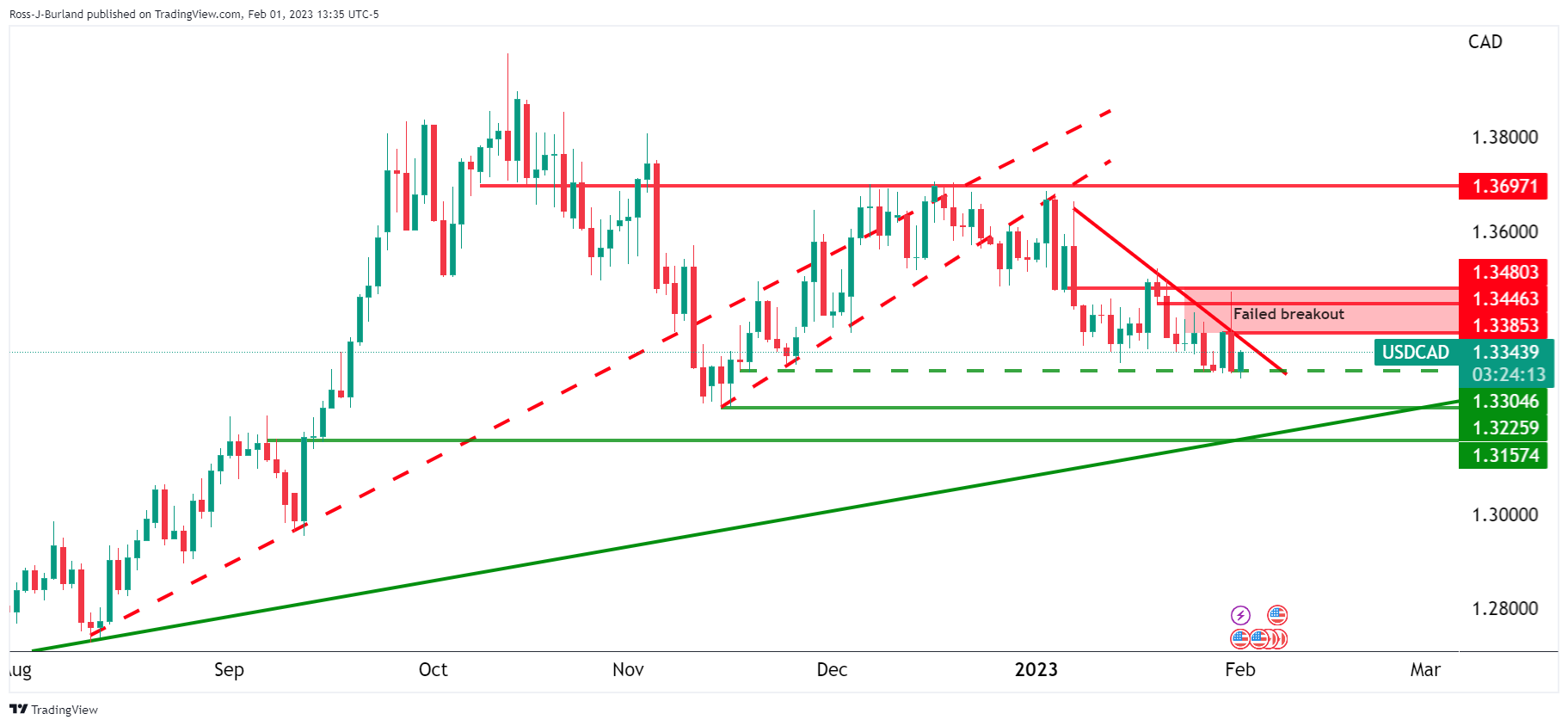
as the chart above shows, that was dran before the Fed, we have already seen the bears chip away at the 1.3305 structure, and this is technically already broken, exposing the 1.3220s and then the 1.3150s. On the upside, we have 1.3380s that guard the 1.3450/80s.
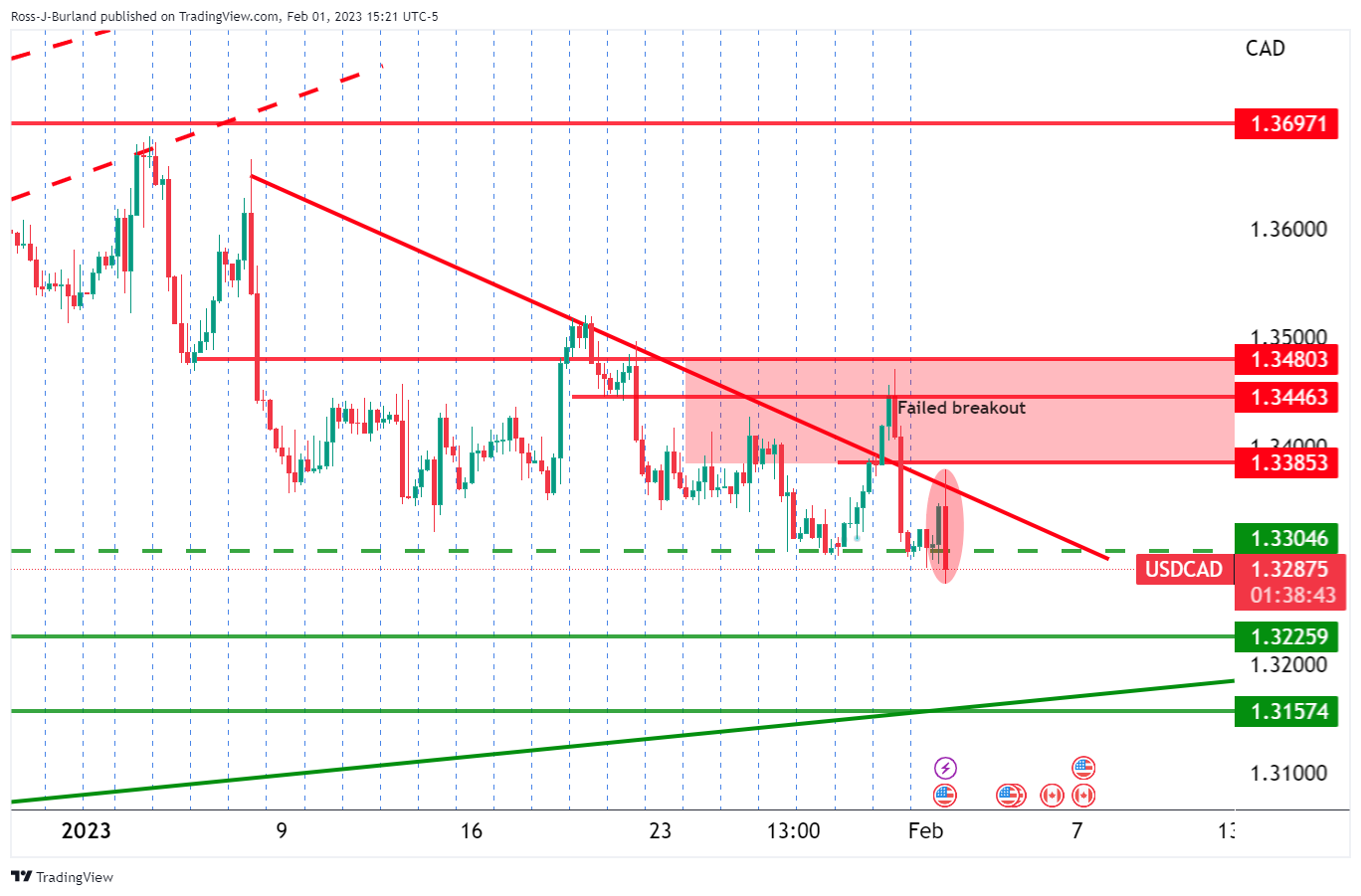
The move following the Fed is digging in at the structure in possible preparation for a downside extension.
FOMC Chairman Jerome Powell comments on the policy outlook after the Federal Reserve's decision to raise the policy rate by 25 basis points to the range of 4.5-4.75% following the first policy meeting of 2023.
Key quotes
"My own assessment is that positive growth will continue but at subdued pace."
"The global picture is improving a bit."
"Labor market also remains very, very strong."
"As inflation comes down, sentiment will improve."
"State and local governments are flush, so that will also support."
"Lots of spending coming in construction pipeline."
"Those factors will support positive growth this year."
"We will look at incoming inflation reports."
"We will also be looking at the next Employment Cost Index report, yesterday's one was constructive as it showed wages coming down."
"As accumulated evidence on inflation comes in, that will be reflected in policy over time."
"Financial markets have a very different job to us, our focus is on bringing down inflation."
"We are strongly resolved that we will complete this task."
"Goods inflation has come down pretty fast."
"This is not a standard business cycle, it's unique."
"We can have no certainty in our forecasts."
"Will not be appropriate for us to cut rates this year according to our current outlook."
"If inflation comes down faster, then we will see it, will incorporate into policy."
- EUR/USD has rallied on the back of a less hawkish Fed Powell.
- The market is pricing in rate cuts, this is weighing in the greenback.
EUR/USD has rallied as the market jumps on a dovish tilt at the Federal Reserve, despite inflation ''running very hot''. However, the Federal Reserve chairman is speaking to the press and he has put no timeline on a pivot, with more rate hikes in the pipeline before a pause ''to get the job done.''
At the time of writing, EUR/USD is taking in the upper quarter of the 1.09 area with printing a high of 1.0985 made so far. The Euro rallied from a low of 1.0852 on the day, completing its daily ATR and bulls keep moving in with eyes on the 1.1000 psychological mark. The Fed terminal rate has fallen to under 4.9% amid chair Powell's comments:
Watch live: Fed Powell's presser
Fed Press Conference: Chairman Jerome Powell speech live stream – February 1
Fed Powell's comments so far
Powell speech: Very difficult to manage the risk of doing too little on rates
Powell speech: Disinflationary process is in early stages
Powell speech: History cautions against prematurely loosening policy
Powell speech: Well-anchored longer-term inflation expectations not grounds for complacency
Powell speech: Will likely have to maintain restrictive stance for some time
EUR/USD H4 chart
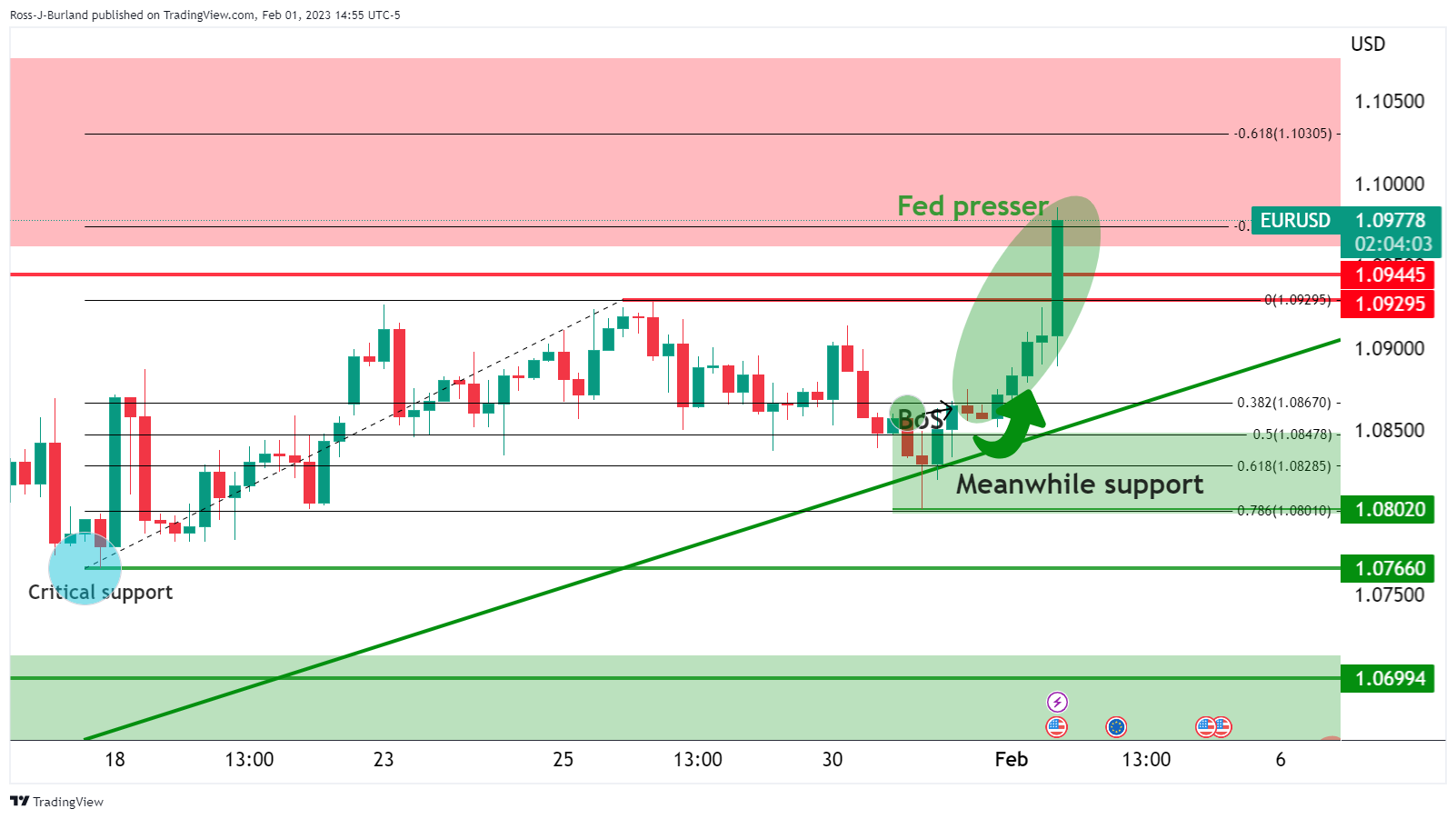
FOMC Chairman Jerome Powell comments on the policy outlook after the Federal Reserve's decision to raise the policy rate by 25 basis points to the range of 4.5-4.75% following the first policy meeting of 2023.
Key quotes
"Policymakers did not see this as a time to pause."
"Taking pauses in between moves is not something the Committee is talking about in any detail."
"Before a rate hike every other meeting was the norm but we have not yet decided path ahead."
"Overall my own view is we will not have sustainable return to 2% core ex housing sector inflation without increased labor slack."
"Most forecasters would say unemployment will probably rise a bit."
"There is a path to getting inflation to 2% without a significant economic decline."
FOMC Chairman Jerome Powell comments on the policy outlook after the Federal Reserve's decision to raise the policy rate by 25 basis points to the range of 4.5-4.75% following the first policy meeting of 2023.
Key quotes
"Very difficult to manage the risk of doing too little on rates."
"We don't want inflation springing back."
"We have no desire to overtighten, but we have tools that would work on that if we do."
"It would be very premature to declare victory on inflation."
"Until we see all aspects of inflation coming down, we still have a lot of work to do."
"We can now say for first time that disinflationary process has started, we see it in goods sector."
"But that's around 1/4 of the PCE Price Index."
"We see disinflation in the pipeline for housing."
"We expect to see that disinflation process will be seen soon in the core services ex-housing, but we don't see it yet."
"Labor market will probably important to bring that aspect of inflation down."
"We're talking about a couple more rate hikes to get to appropriately restrictive stance."
"We are not very far from that level."
"Policy is restrictive, trying to judge about how much is restrictive enough."
- AUD/USD snaps three days of losses as the Federal Reserve increased rates by 25 bps.
- Federal Reserve officials stated that more increases would be appropriate.
- US central bank policymakers decided that future rate hikes would be in 25 bps increments.
AUD/USD pares some of its earlier losses, aiming higher after the US Federal Reserve (Fed) lifted rates by 25 bps as expected by market participants, though emphasized that further increases would be appropriate, putting expectations for a Fed pivot in the backseat. At the time of writing, the AUD/USD is trading volatile in the 0.7040-0.7115 range.
Remarks of the Federal Reserve’s monetary policy statement
On Wednesday, the Federal Reserve policymakers decided unanimously to hike rates by 0.25%, lifting the Federal Funds rate (FFR) at around 4.50% - 4.75%. Additionally, they pushed back against the market’s expectations for a Fed pivot and said additional rate hikes would be appropriate. Policymakers forward guided the market, adding that future rate hikes would be in 25 bps increments, dropping the reference to the “pace” of additional rate hikes.
Fed officials acknowledged that inflation has “eased somewhat but remains elevated.” Participants added that indicators point to modest growth in spending and production and commented that the labor market remains robust. Fed members stated, “in determining the extent of future rate hikes, it will take into account cumulative tightening, policy lags and economic and financial developments.”
Now that the Fed’s decision is in the rearview mirror, traders can for the Federal Reserve Chair Jerome Powell’s press conference here: Fed Press Conference: Chairman Jerome Powell speech live stream – February 1
AUD/USD reaction to the headline
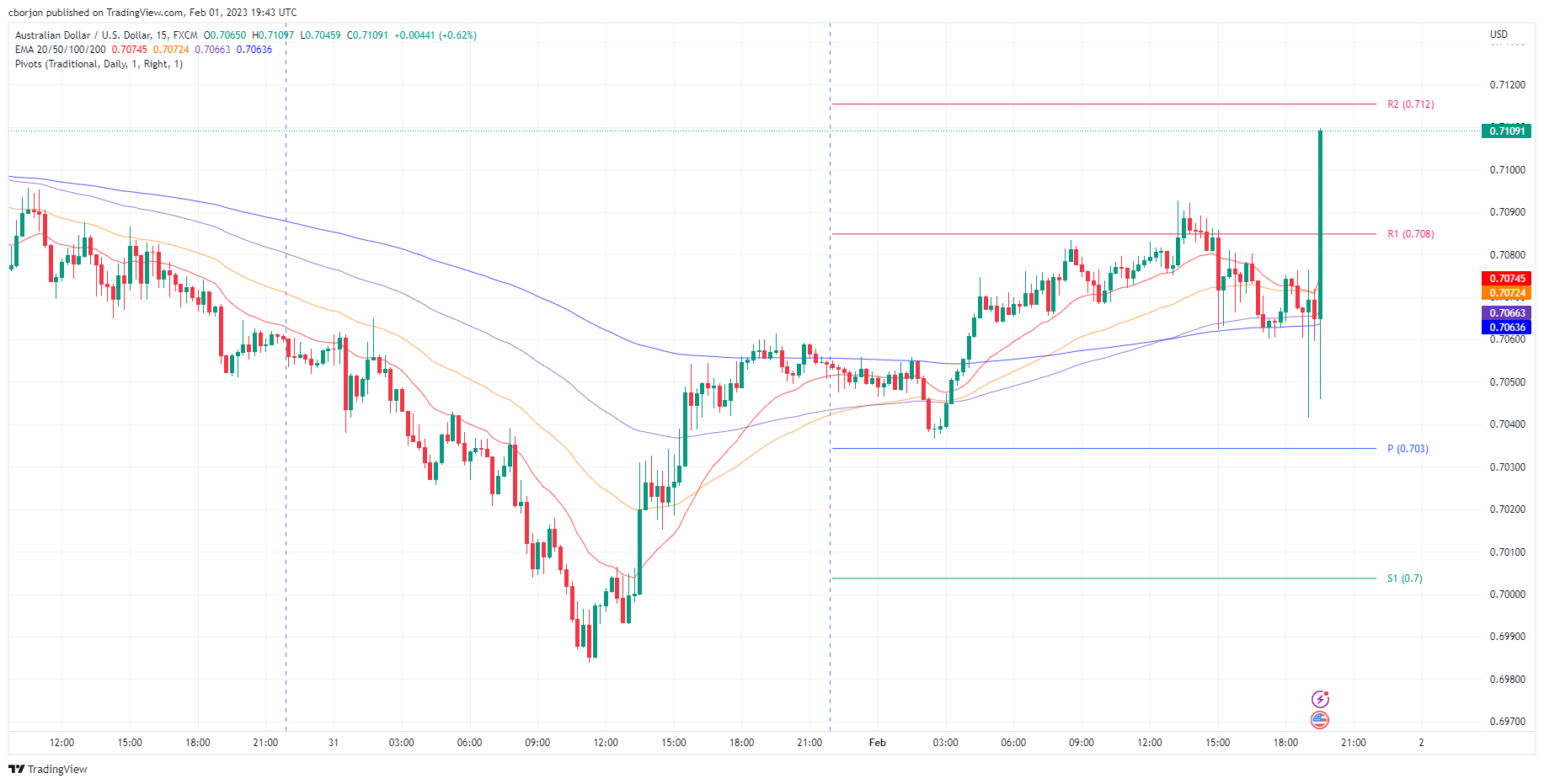
The AUD/USD 15-minute chart portrays the pair trading nearby a busy confluence of the 20, 50, 100, and 200-Exponential Moving Averages (EMAs). Even though AUD/USD’s price action remains volatile due to the importance of the Fed’s decision, it failed to crack the day’s low at 0.7036. Also, it’s aiming toward printing a new session high above the 0.7100 area, testing the R2 daily pivot point at around 0.7115-20. The break above will expose the 0.7200 mark.
On the flip side, the AUD/USD first support level would be the daily pivot at 0.7034, followed by the S1 pivot at 0.7000.
- GBP/USD has rallied around Fed' Powell's presser and opening statement.
- The US Dollar is volatile around the event.
GBP/USD has rallied to a high of 1.2361 so far despite a hawkish Federal Reserve chairman Jerome Powell turning the screw with regard to inflation targets following the Fed's interest rate decision. The central bank raised interest rates for the eighth time in a year but slowed its pace to a quarter of a point in a nod to an improved inflation outlook.
Fed statement
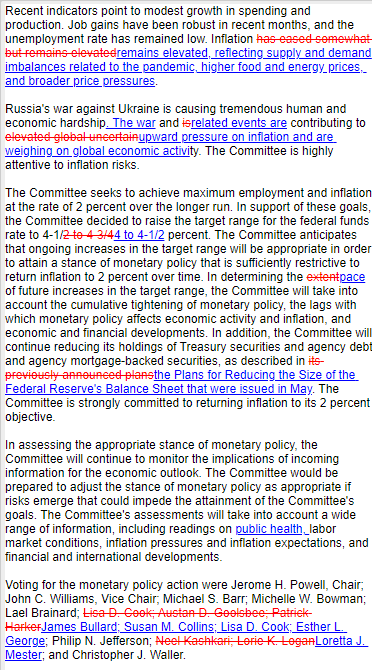
Key notes:
- FOMC policy vote was unanimous, to continue balance sheet reduction as planned.
- Reaffirms policy framework, and inflation target.
The Fed is retaining its prior language in the statement and Fed fund futures are still pricing in rate cuts this year, with the Fed funds rate seen at 4.486% by end of December, unchanged prior to the Fed decision. The March meeting is priced in at 85% for 25 bps with the remainder at no change.
Fed Powell's presser
Key notes so far:
-
Powell speech: History cautions against prematurely loosening policy
-
Powell speech: Well-anchored longer-term inflation expectations not grounds for complacency
-
Powell speech: Will likely have to maintain restrictive stance for some time
-
Fed Press Conference: Chairman Jerome Powell speech live stream – February 1
The disinflation process is underway and this is propelling the greenback lower.
FOMC Chairman Jerome Powell comments on the policy outlook after the Federal Reserve's decision to raise the policy rate by 25 basis points to the range of 4.5-4.75% following the first policy meeting of 2023.
Key quotes
"It is a good thing that disinflation so far has not come at expense of labor market."
"But this disinflationary process is in early stages."
"In housing services, we expect inflation to continue moving up but then moving down as new leases come in lower."
"But in core services ex-housing we don't see disinflation yet."
"It's gratifying to see disinflationary process underway, with continued strong labor market."
"Employment Cost Index and Average Hourly Earnings have abated somewhat, although still fairly elevated."
"We see wages moving down."
"By many many indicators job market is still very strong."
FOMC Chairman Jerome Powell comments on the policy outlook after the Federal Reserve's decision to raise the policy rate by 25 basis points to the range of 4.5-4.75% following the first policy meeting of 2023.
Key quotes
"Seeing effects of policy on demand in housing, but will take time for full effects to be realized."
"Will take time for full effects of our actions to be realized."
"These lags fed into our decision to raise by 25 bps today."
"In light of cumulative tightening and lags, Fed continued step-down from last year's fast pace."
"A slower pace allows us to better assess progress toward our goals."
"We will continue to make decisions meeting by meeting."
"Our focus in on using our tools to bring inflation down."
"Reducing inflation is likely to require below trend growth, some softening in labor market."
"History cautions against prematurely loosening policy."
"We will stay the course until job is done."
FOMC Chairman Jerome Powell comments on the policy outlook after the Federal Reserve's decision to raise the policy rate by 25 basis points to the range of 4.5-4.75% following the first policy meeting of 2023.
Key quotes
"Wage growth is elevated."
"Job market is extremely tight, job gains have been robust."
"Labor market continues to be out of balance."
"Pace of job gains has slowed and nominal wage growth too, but labor market still out of balance."
"Labor demand substantially exceeds supply."
"Inflation is well above our goal."
"Inflation data over past 3 months show welcome reduction in pace of increases but we need substantially more evidence to be confident inflation is on a downward path."
"Longer-term inflation expectations remain well anchored but that's not grounds for complacency."
FOMC Chairman Jerome Powell comments on the policy outlook after the Federal Reserve's decision to raise the policy rate by 25 basis points to the range of 4.5-4.75% following the first policy meeting of 2023.
Key quotes
"We have taken forceful actions over past year."
"We have covered a lot of ground, full effects yet to be felt."
"We have more work to do."
"We continue to anticipate ongoing increases will be appropriate to get to sufficiently restrictive stance."
"We will likely have to maintain restrictive stance for some time."
"Economy slowed significantly last year."
"Consumer spending appears to be subdued."
"Housing activity continues to weaken."
Jerome Powell, Chairman of the Federal Reserve System, will be delivering his remarks on the monetary policy outlook at a press conference following the meeting of the Board of Governors. Powell's speech will start at 19:30 GMT.
Follow our live coverage of the market reaction to Powell's press conference.
Fed hikes policy rate by 25 bps to 4.5-4.75% as expected.
About Jerome Powell (via Federalreserve.gov)
"Jerome H. Powell first took office as Chair of the Board of Governors of the Federal Reserve System on February 5, 2018, for a four-year term. He was reappointed to the office and sworn in for a second four-year term on May 23, 2022. Mr. Powell also serves as Chairman of the Federal Open Market Committee, the System's principal monetary policymaking body. Mr. Powell has served as a member of the Board of Governors since taking office on May 25, 2012, to fill an unexpired term. He was reappointed to the Board and sworn in on June 16, 2014, for a term ending January 31, 2028."
- Gold price seesaws in a $10 range after the Federal Reserve hiked rates by 25 bps.
- Federal Reserve officials stated that more increases would be appropriate.
- US central bank policymakers decided that future rate hikes would be in 25 bps increments.
Gold price rises following the US Federal Reserve (Fed) decision to slow the pace of interest rate increases and lifted the Federal Funds rate (FFR) by 25 bps to the 4.50% – 4.75% area. At the time of writing, the XAU/USD is trading volatile but above its opening price, at around the $1920-$1930 range.
Summary of the monetary policy statement
In its monetary policy statement, Fed officials voted unanimously to raise rates by 25 bps, emphasizing that additional rate hikes would be appropriate, pushing against the financial market’s expectations for a Fed pivot.
Policymakers acknowledged that inflation has “eased somewhat but remains elevated.” The Fed added that indicators point to modest growth in spending and production and commented that the labor market remains robust. Officials added, “in determining the extent of future rate hikes, it will take into account cumulative tightening, policy lags and economic and financial developments.”
Fed officials commented that future rate hikes would be in 25 bps increments, dropping the reference to the “pace” of additional rate hikes.
Now that the Fed’s decision is in the rearview mirror, traders prepare for the Federal Reserve Chair Jerome Powell’s press conference at around 19:30 GMT.
Gold’s reaction to the headline
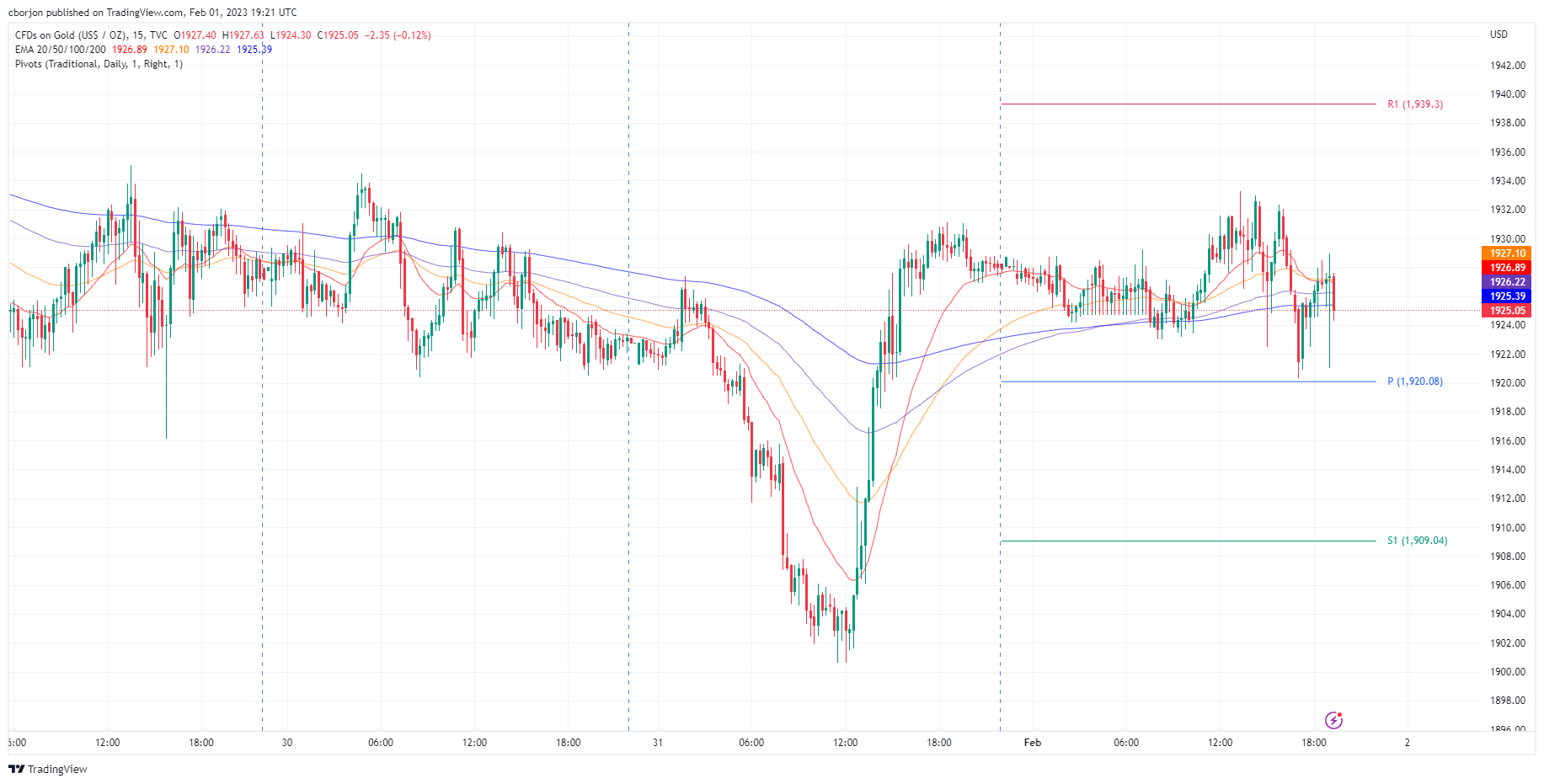
As shown in Gold’s 15-minute chart, In its initial reaction, the XAU/USD edged towards the daily pivot, though slightly above it, around $1920, and pushed upwards, clearing the 200, 100, 50, and 20-Exponential Moving Averages (EMAs). It should be said that XAU/USD’s is seesawing around $1920-$1930, and it would remain volatile during the press conference of Jerome Powell.
- EUR/USD is biased to the downside as it takes out the near-term structure around 1.0905 after the Fed interest rate decision.
- The Fed chairman Jerome Powell will be the next event that would be expected to cause more volatility and determine the direction of the Euro ahead of the ECB.
EUR/USD is bouncing around 1.0900 after the Federal Reserve raised interest rates for the eighth time in a year, but slowed its pace to a quarter of a point in a nod to an improved inflation outlook.
Federal Reserve statement

Key notes:
- FOMC policy vote was unanimous, to continue balance sheet reduction as planned.
- Reaffirms policy framework, and inflation target.
The Fed is retaining its prior language in the statement and Fed fund futures are still pricing in rate cuts this year, with the Fed funds rate seen at 4.486% by end of December, unchanged prior to the Fed decision. The March meeting is priced in at 85% for 25 bps with the remainder at no change.
Next up will be Jerome Powell who speaks to the press.
Watch live: Jerome Powell's presser
EUR/USD technical analysis
As per the pre-Fed analysis made ahead of the Tokyo open on Tuesday, EUR/USD Price Analysis: Bulls eye a move to test 1.0900/20, the price has broken the structure, leaving the bias to the upside for the sessions ahead of the Federal Reserve.
EUR/USD H4 chart, prior analysis:
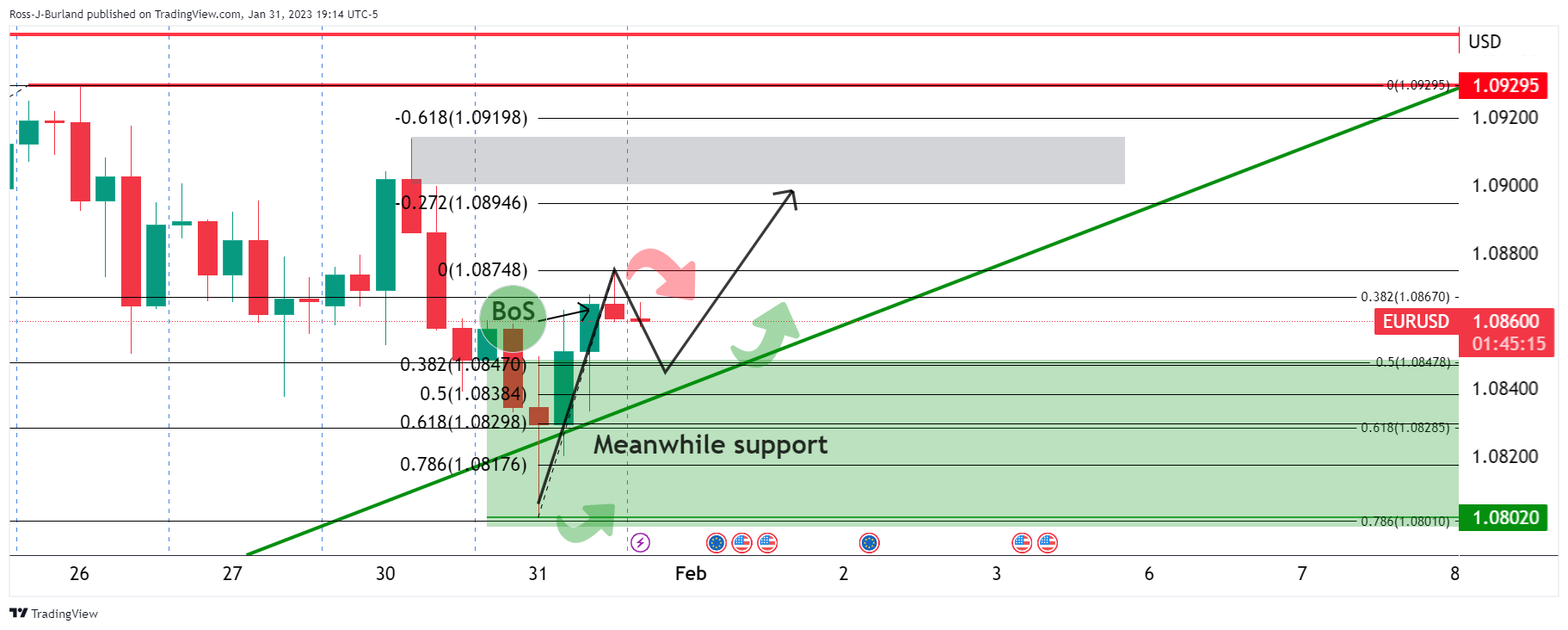
It was stated that the support came in near a 38.2% Fibonacci retracement of the prior bullish 4-hour impulse where a correction could be expected to decelerate. This comes in at 1.0850. On the upside, 1.0900 came in at the target with 1.0920 above there as a potential liquidity zone into the Fed.
EUR/USD update
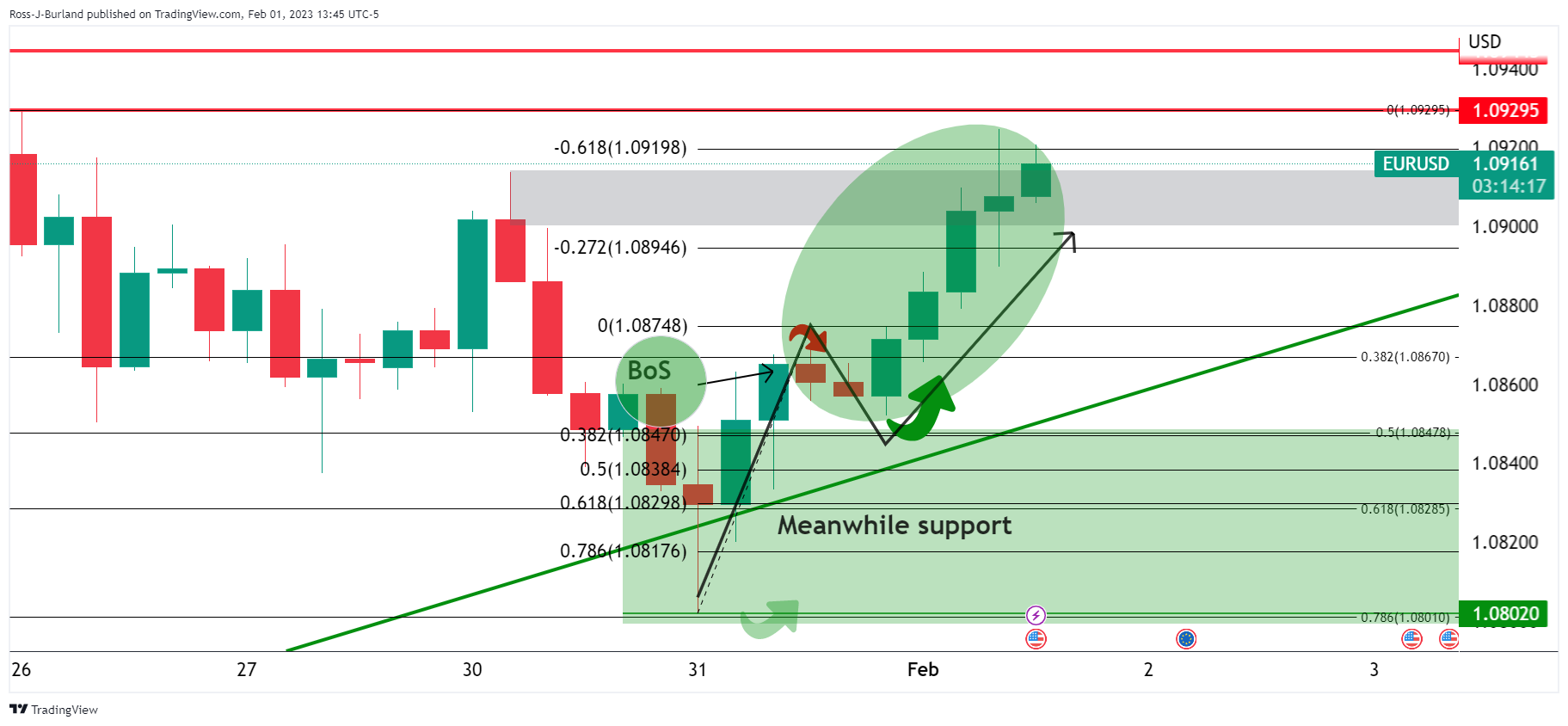
The price behaved accordingly and was pumped up to sweep liquidity through 1.0900 as forecasted, conveniently poised for either a sell-off around the Fed or a continuation of the move having already broken resistance structure.
EUR/USD post-Fed interest rate decision and statement

Before the announcement and statement, the price was sitting in a 50% mean reversion area on the hourly chart, on the front side of the bullish dynamic support. Given it had already broken structure to the upside, bulls were in place in anticipation of a move up. This left a bearish case for a test of major structure at 1.0888 and a subsequent move lower, trapping the breakout longs. On the other hand, a dovish outcome would have been perceived as bearish for the US Dollar and leave 1.0950 exposed in a -61.8% extension of the recent correction of the prior bullish impulse.
EUR/USD after the Fed, initial knee-jerk reaction

EUR/USD was offered to 1.0891 (breaking through technical structure again) on the knee-jerk of the Federal Reserve announcement. The price then attempted a move higher in volatility around the decision to hike just 25 basis points, touching a fresh higher for the day of 1.0925. It has now made a fresh session low of 1.0891 at the time of writing as the bears move in for the kill. This leaves the bias to the downside into the Fed chair's presser. However, should he fail to convince markets should he attempt to push back prospects of a pivot later this year, then the Euro could take off and break the 1.0920s resistance as explained above on the charts with 1.0950 eyed.
The US Federal Reserve on Wednesday announced that it raised the policy rate, federal funds rate, by 25 basis points to the range of 4.5-4.75% following the first policy meeting of 2023. This decision came in line with the market expectation.
Follow our live coverage of the Fed's policy announcements and the market reaction.
In the policy statement, the Fed noted that 'ongoing increases' in rates will be appropriate and added that inflation remains elevated despite having eased somewhat.
Market reaction
The US Dollar Index edged slightly higher with the immediate reaction but quickly erased its gains as investors await FOMC Chairman Jerome Powell's press conference. As of writing, the index was down 0.26% on the day at 101.82.
Key takeaways from policy statement, via Reuters
"In determining the extent of future rate hikes, will take into account cumulative tightening, policy lags, and economic and financial developments."
"Recent indicators point to modest growth in spending and production."
"Job gains have been robust in recent months, unemployment rate has remained low."
"Russia's war against Ukraine is contributing to elevated global uncertainty, Fed remains highly attentive to inflation risks."
"Will continue reducing the balance sheet as planned."
"Vote in favor of policy was unanimous."
- USD/CAD bears chipped away at the 1.3305 structure before bulls moved in to test bears at the 1.3350s.
- The Fed will determine when the price heads towards 1.3320s and then the 1.3150s or, on the upside, we have 1.3380s that guard the 1.3450/80s.
As per the prior analysis, USD/CAD Price Analysis: Bears seek a break of key support while on the front side of bear trend, bulls have moved in to test the critical resistance area near the 1.3350s ahead of the Federal Reserve's interest rate decision.
For the US Dollar, this event will be important and it could catch a bid if the outcome is far more hawkish than what would be otherwise anticipated. A pushback against the sentiment of a pivot could stir up some demand for the greenback which sees a higher USD/CAD but anything to the contrary would likely see 1.3300 come under pressure with the price already jammed in on the front side of the bearish trendline following a failed breakout.
USD/CAD, prior analysis daily charts
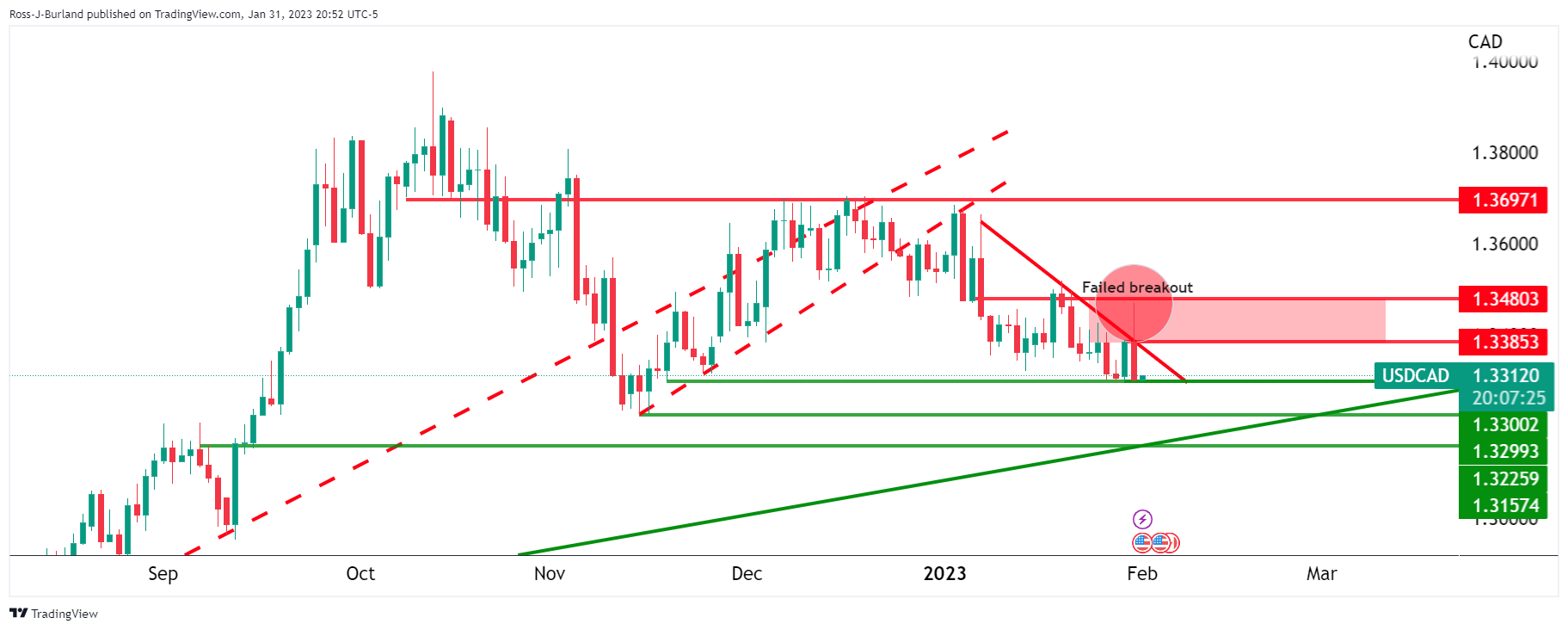
Zoomed in ...
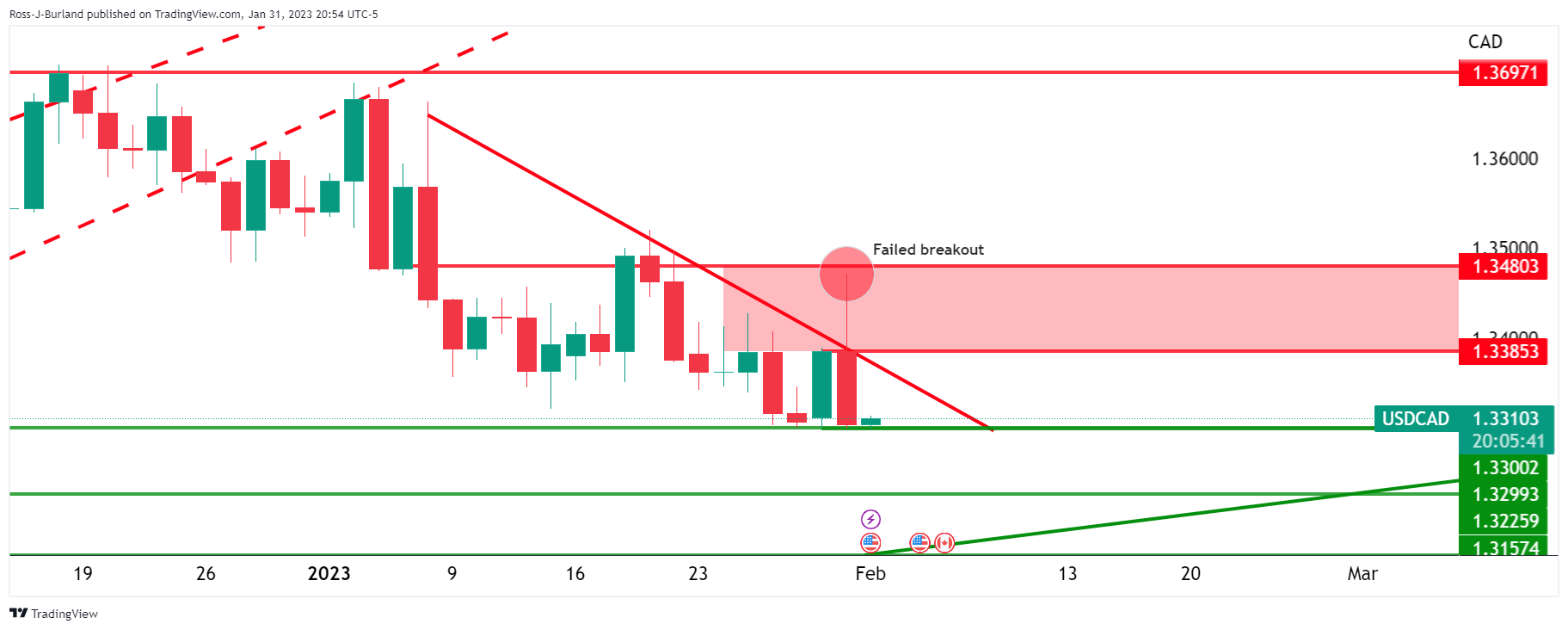
It was stated, that with the breakout failure, the bears remained in control.
USD/CAD H1 chart
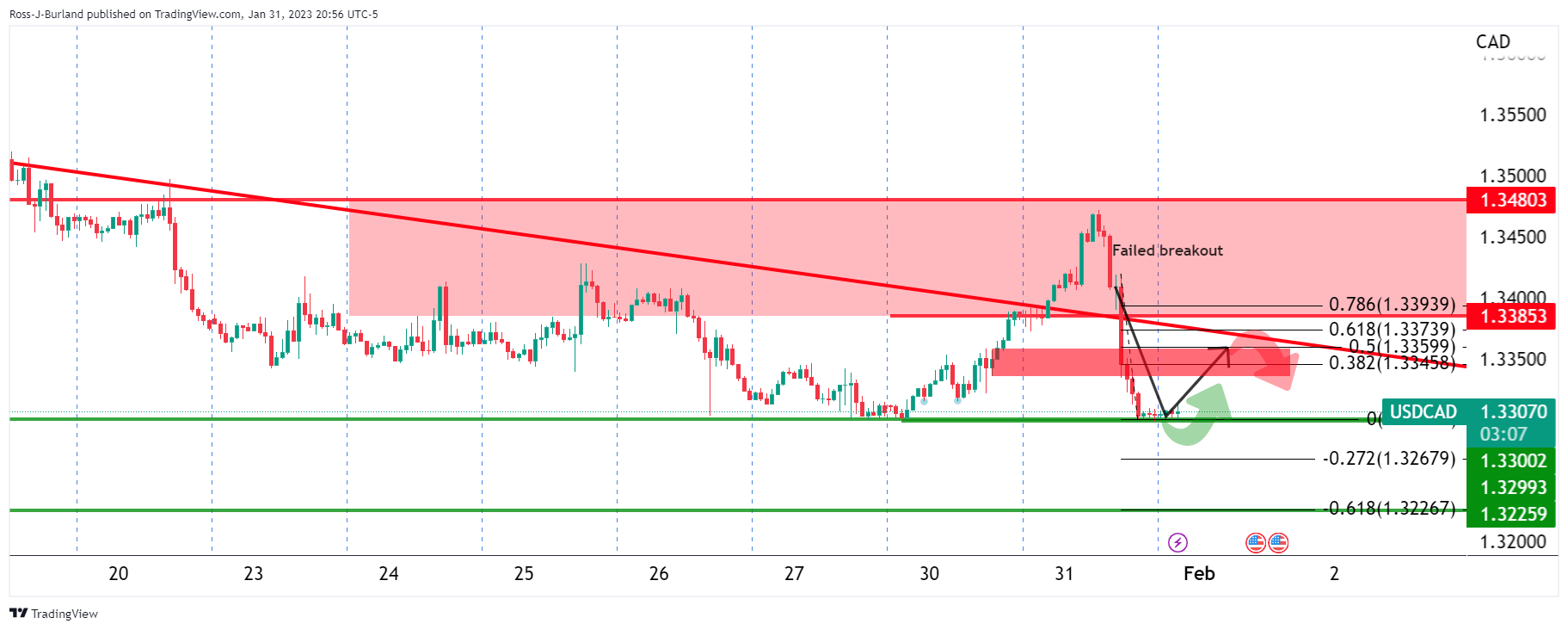
However, in the Asian session, when the analysis was drawn on the above charts, it was also explained that the bulls could be seeking a move to test the commitments of the bears again following the failed breakout with the 50% mean reversion resistance eyed.
USD/CAD update
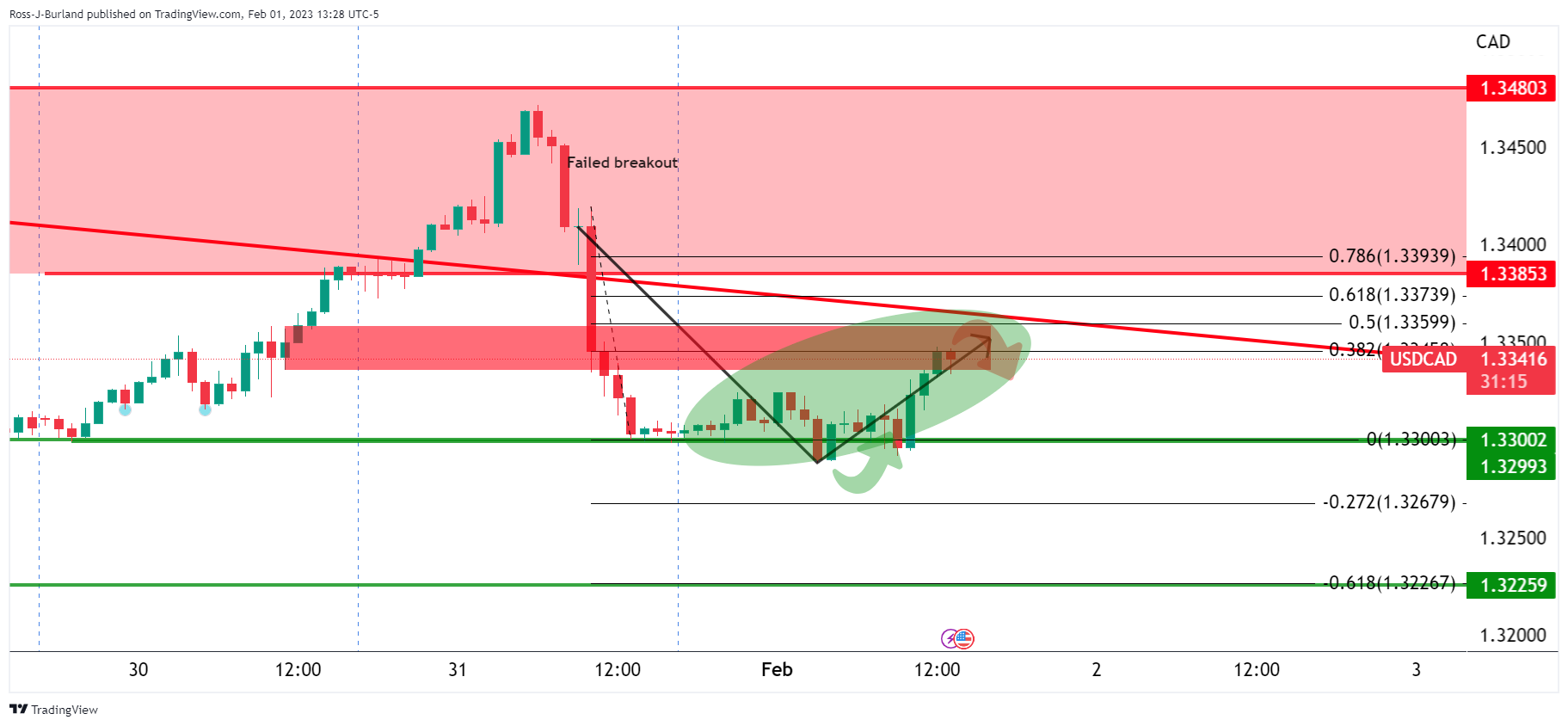
The bulls moved in as anticipated and now the price will be determined by the Federal Reserve event. In this regard, we have the levels marked as follows:

We have already seen the bears chip away at the 1.3305 structure, and this is technically already broken, exposing the 1.3320s and then the 1.3150s. On the upside, we have 1.3380s that guard the 1.3450/80s.
- The USD/CHF is trapped within a 140 pip area, trendless and fluctuating around the 20-day EMA.
- USD/CHF Price Analysis: The pair is neutral downwards, and it could test the YTD low during the session.
The USD/CHF remains subdued in Wednesday’s North American session, with markets awaiting the Federal Reserve’s (Fed) decision regarding its monetary policy. At the time of typing, the USD/CHF exchanges hands at around 0.9150s, almost flat.
USD/CHF Price Analysis: Technical outlook
The pair remains consolidated in the 0.9140 to 0.9280 area for the tenth consecutive day, though the USD/CHF fell and hit a new weekly lof of 0.9136 before recovering some ground, resting at around the 0.9150 area. Nevertheless, the USD/CHF bears remain in charge, as the daily EMAs sits above the spot price, while oscillators like the Relative Strength Index (RSI) and the Rate of Change (RoC) suggest the neutral-downward bias remains intact.
The USD/CHF support areas would be the day’s low at 0.9136, followed by the 0.9100 figure. Once broken it will exacerbate a USD/CHF fall to the YTD low of 0.9085, followed by the 0.9000 psychological figure.
On the other hand, if the USD/CHF reclaims 0.9200, then the 20-day EMA would be up for grabs at 0.9220. Once done, the USD/CHF could aim towards the January 31 daily high at 0.9288, on its way to the 0.9300 psychological barrier.
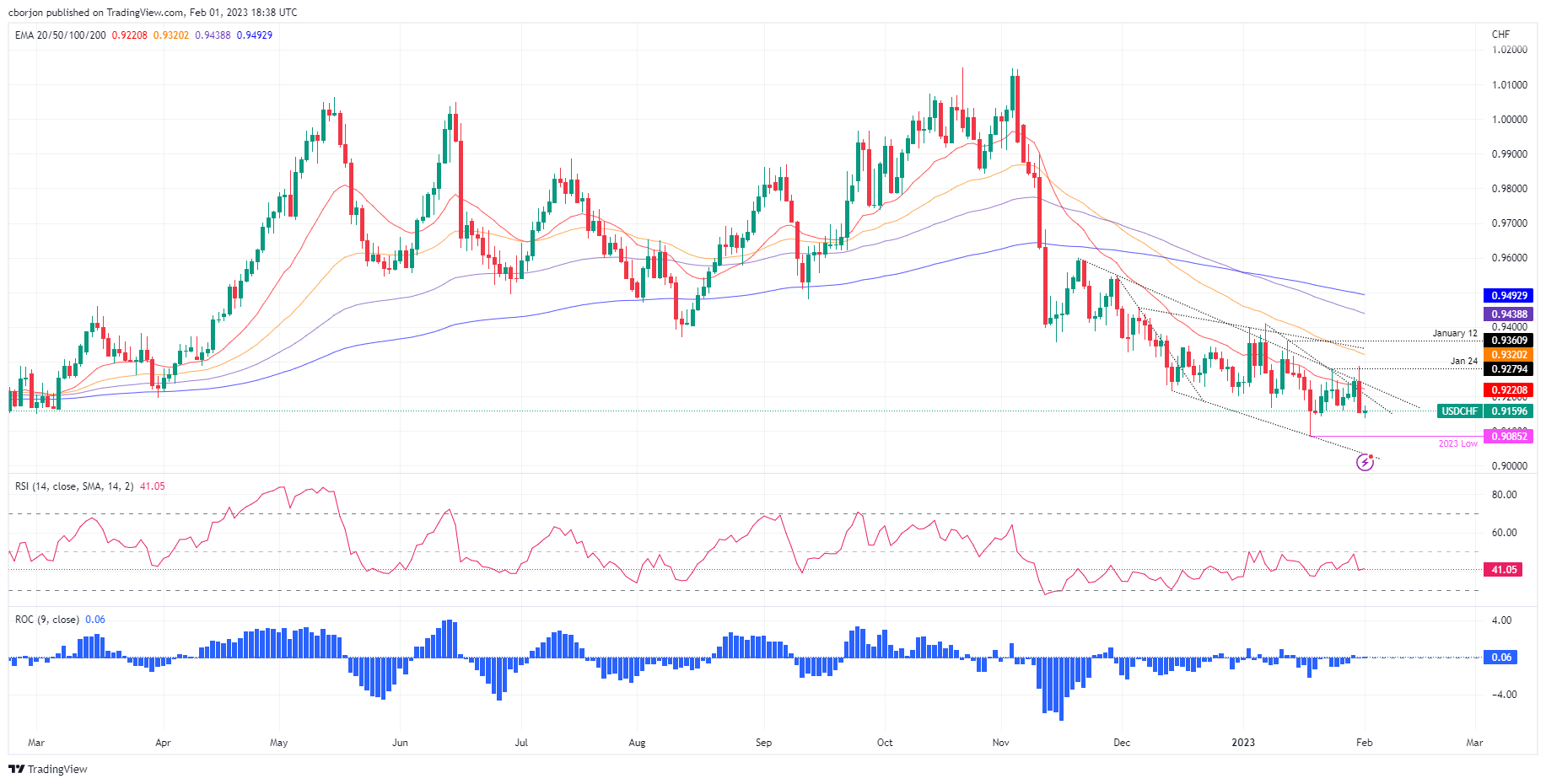
USD/CHF Key Technical Levels
- Silver fails to hold to its earlier gains above the 20-day EMA, with traders eyeing $23.00.
- Silver Price Analysis: Consolidated, slightly skewed downwards, as oscillators turned bearish.
Silver price struggles at the 20-day Exponential Moving Average (EMA) at $23.66 and is dropping toward the lows of the day, at around $23.40s, as investors prepare for the US Federal Reserve’s (Fed) monetary policy decision. Therefore, XAG/USD traders are squaring their positions, awaiting Jerome Powell and his colleagues. At the time of writing, the XAG/USD exchanges hands at $23.44, below its opening price by 1.12%.
Silver Price Analysis: XAG/USD Technical Outlook
Silver remains pressured ahead of the FOMC’s decision, trapped within Tuesday’s price action, which witnessed a test of the 50-day Exponential Moving Average (EMA) at $23.11, though it was quickly rejected, achieving a daily close above the 20-day EMA. However, Wednesday’s story is different. The XAG/USD fell below Monday’s low of $23.54, eyeing to extend its losses toward the $23.00 figure.
Momentum indicators, like the Relative Strength Index (RSI), turned bearish, while the Rate of Change (RoC), suggests that sellers are gathering momentum.
Given the backdrop, the XAG/USD first support would be the $23.00 psychological level. A breach of the latter and the year-to-date (YTD) low at $22.76 is on the cards.
As an alternate scenario, the XAG/USD’s reclaiming the 20-day EMA will expose the $24.00 figure. Once cleared, Silver would test the YTD high at $24.54, followed by a rally to the $25.00 mark.

Silver Key Technical Levels
- WTI bears break the hourly structure at $77.70 and the focus is on the downside.
- Bulls eye a higher resistance up at 61.8% Fibonacci retracement level near $78.50. While below there, the bias is to the downside.
- Bears can target between $75.36 and $74.88 on a break of $75.50.
As per the prior analysis, WTI bears taking control into the Fed, eyes on $75.00bbl, the price of oil has indeed dropped towards the target areas as forecasted at the start of the week, pulling away from the trapped volume that had accumulated around $79.40/50. The following illustrates the price action and gives an update with prospects of a correction before the next move lower.
WTI, prior technical analysis
It was suggested that ''a correction into resistance could entice trapped longs to get out of losing or breakeven positions and subsequently the shorts coming onto the market around 38.2% Fibonacci correction could see a move out of the consolidation below the trapped volume and into a 100% measured target towards $75.00 over the course of the coming week.''
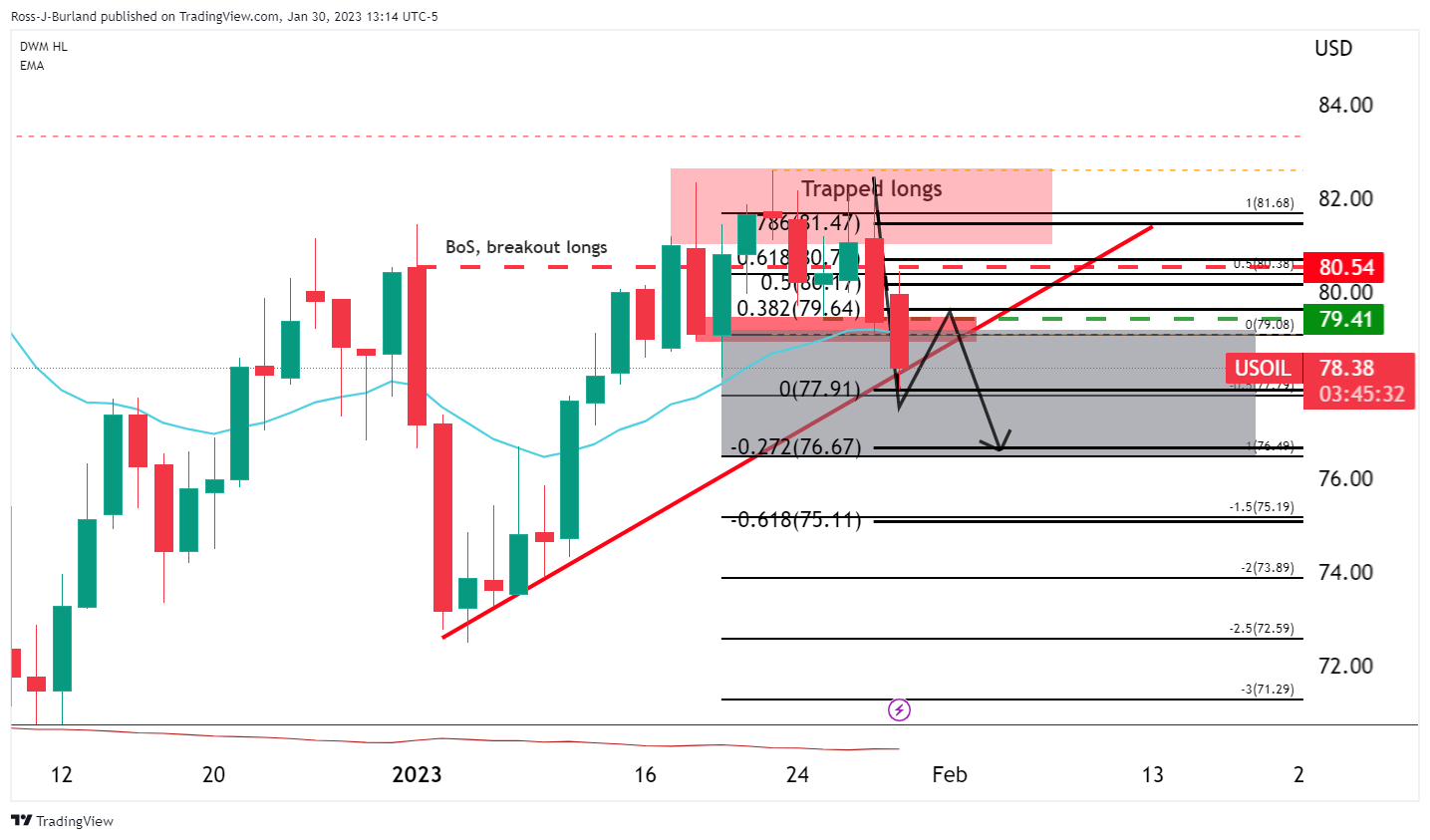
WTI Update
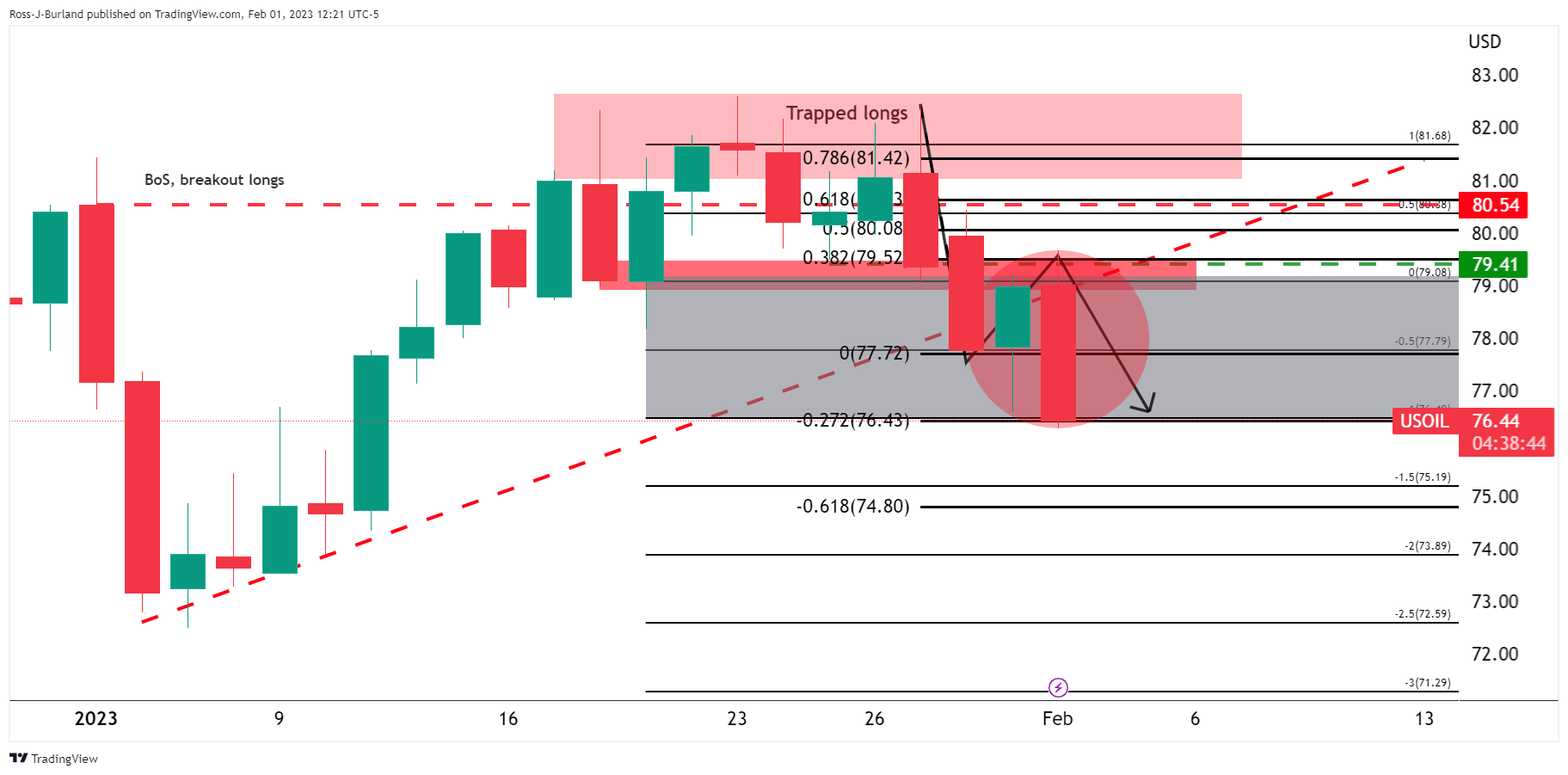
As illustrated, the price sank into the target area following a correction into where shorts were looking to get in at a premium. The subsequent move has fulfilled the 100% measured move and $75.00 beckons:
WTI H1 charts
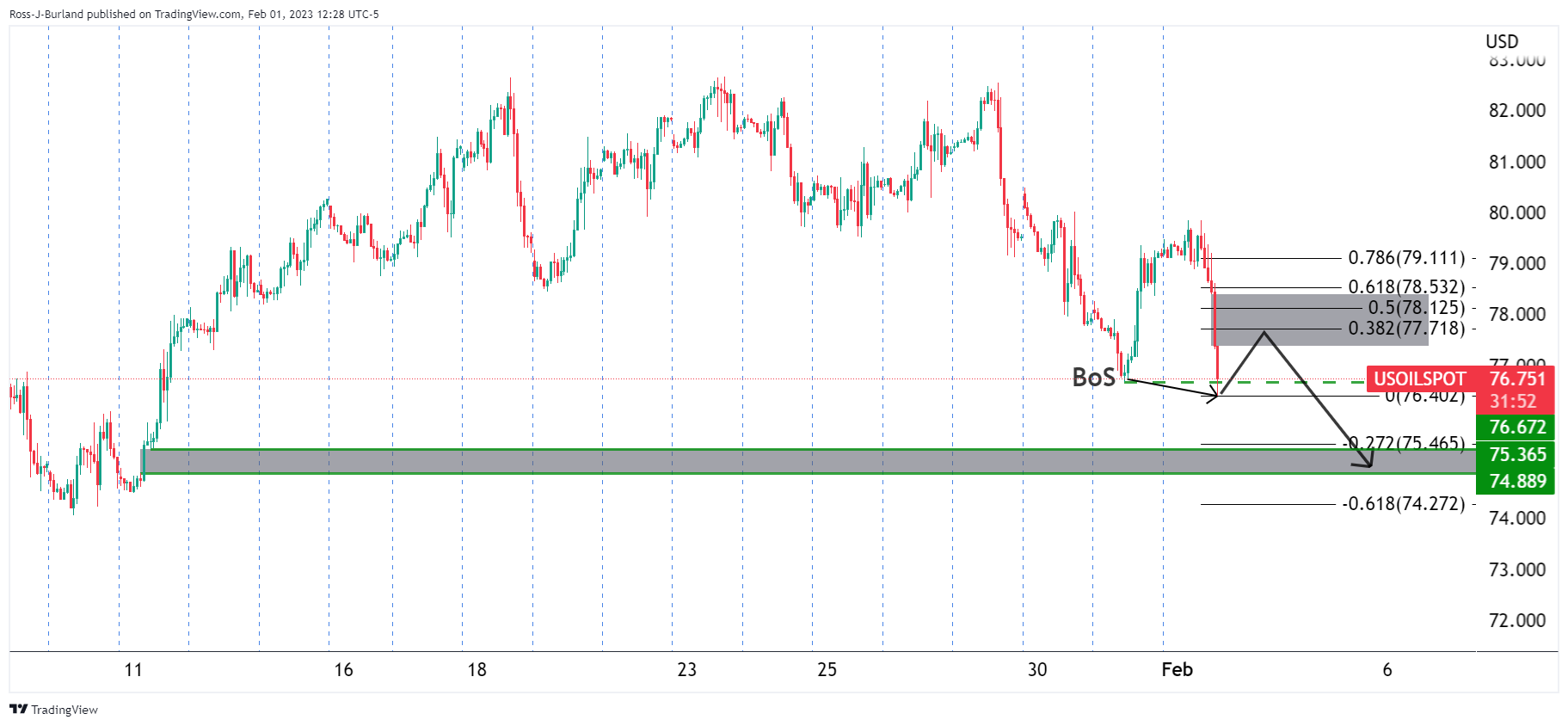
Zoomed in ...
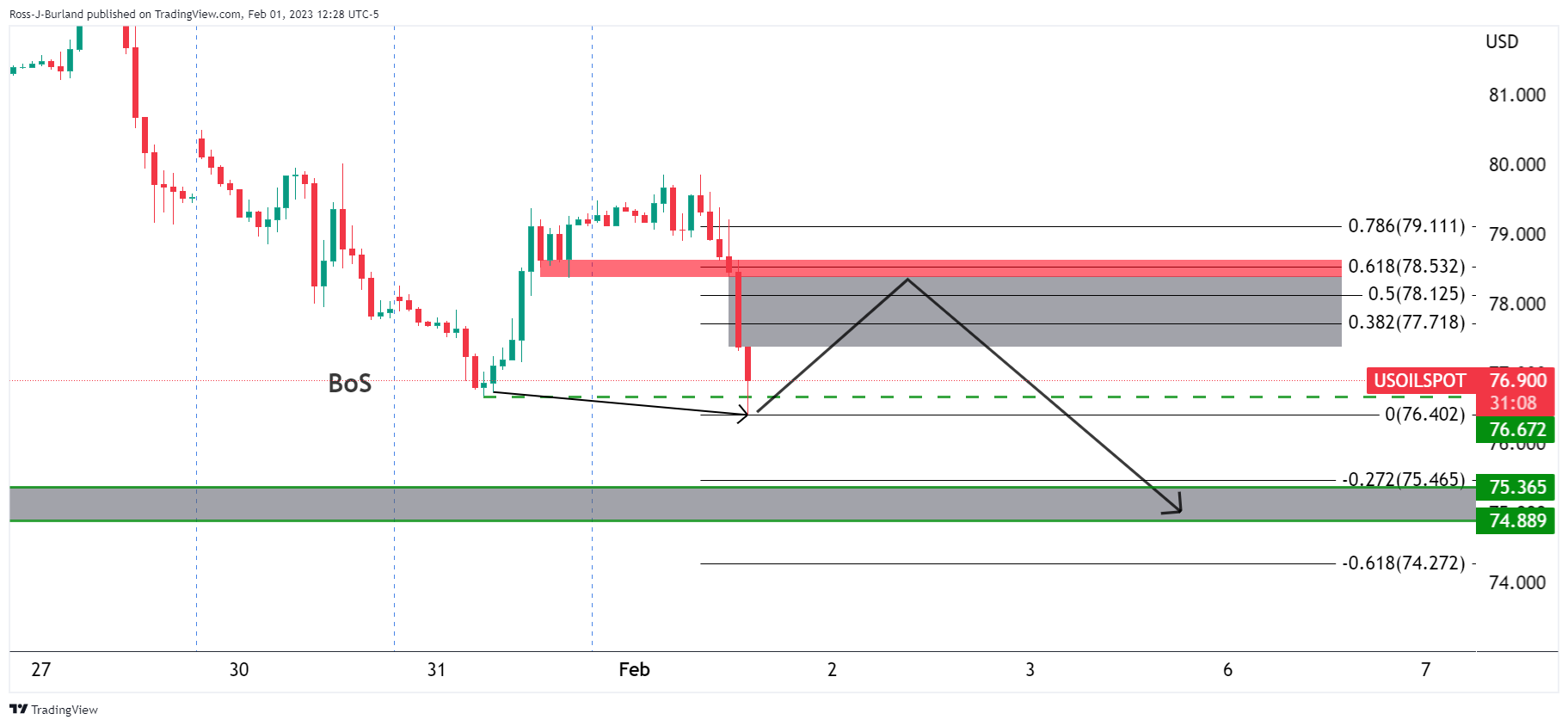
The greyed areas are price imbalances while the red marking is a resistance zone that has a confluence with the 61.8% Fibonacci retracement level near $78.50. While below there, the bias is to the downside. However, a more shallow correction may be all that is needed towards the 38.2% Fibo at $77.70. Either way, bears can target between $75.36 and $74.88 on a break of $75.50.
- Gold price shifted negatively as time for the US Federal Reserve decision approaches.
- ADP Employment Change was lower than estimates; would it be a prelude for Friday’s NFP?
- US factory activity in the United States remains in contractionary territory.
Gold price retraces from the day’s high and failed to hold to earlier gains after a busy US economic calendar released its first tranche of data, which was worse than estimated. In addition, a soft US Dollar (USD), capped the XAU/USD’s fall, while US Treasury bond yields continued to push downwards. At the time of writing, the XAU/USD exchanges hands at around $1925.
US economic data was mixed ahead of the FOMC’s meeting
Wall Street remains depressed ahead of the Fed’s monetary policy decision. US economic data showed that the labor market continues to ease as the ADP National Employment Change, which reports private hiring revealed that companies hired 106K employees, well below the 178K foreseen. Later, the JOLTs Job Openings report showed that vacancies rose to 11.01M exceeding estimates of 10.25M.
In addition, factory activity was updated by two firms, showing that manufacturing activity remains in contractionary territory. The S&P Global Manufacturing PMI for January jumped by 49.9 above the 46.8 estimates, better than expected but at recessionary territory. Elsewhere, the ISM Manufacturing PMI for January plunged to 47.4, below December’s 48.4, and dropped for the third straight month pushing the index to its lowest level since May 2020.
Aside from this, Gold traders remained laser-focused on the US Federal Reserve decision. Traders expect a 25 bps rate hike and further guidance from the US central bank. At around 13:30 GMT, the Fed Chair Jerome Powell would hit the podium, and each word would be scrutinized as investors expect a Fed pivot, from hiking rates, to cutting them by the second half of 2023.
Gold Technical Analysis
In the last five trading days, XAU/USD has failed to crack the $1950 psychological barrier, reaching a YTD high of 1949.16. on January 26. Since then, the XAU/USD dropped toward the 20-day Exponential Moving Average (EMA) at $1902.38 and gained traction toward the $1930 area, unable to re-test the YTD highs. That could be attributed to traders booking profits or awaiting Powell and Co.’s decision.
Gold’s key resistance levels lie at the current week’s high of $1934..47, followed by the YTD high at $1949.16, and then the $2000 mark. On the other hand, XAU/USD’s demand areas would be the 20-day EMA at $1904.83, followed by the January 18 swing low of $1896.74.
Gold is having a difficult time gathering further bullish momentum. Economists at Credit Suisse expect the yellow metal to stage a consolidantion phase.
Short-term momentum is turning lower
“Gold has stalled in the short-term just ahead of our tactical objective at the 78.6% retracement of the 2022 fall and April 2022 high at $1,973/98, with a fresh cap still expected here. Short-term momentum is also turning lower, reinforcing the case for a lengthier pause.”
“From a more medium-term perspective, only above the $2,070/72 record highs of 2020 and 2022 would suggest we are seeing a significant and meaningful long-term break higher, with resistance levels then seen at $2,300, then $2,500. This is not our base case for now though.”
“Support is seen at $1,897 initially, below which can see a pullback to the 55DMA, currently seen at $1,829.”
The greenback continues to weaken in the new year. Economists at the National Bank of Canada still anticipate a policy change from the FOMC in the first quarter of 2023, which would set the stage for a more prolonged decline.
Inflation easing more than expected
“Markets are embracing our longheld forecast that the US central bank will be forced to lower interest rates in H2 2023. It would be a mistake for the Fed to persists in raising its key rate well beyond the current level and holding it there for an extended period if inflation continues to surprise on the downside.”
“We still anticipate a policy change from the FOMC in the first quarter of 2023, which would set the stage for a more prolonged decline in the greenback. That said, the Dollar looks oversold at this stage and we think a temporary rebound is possible in the coming weeks, as we have not yet confirmed a change in the Fed's policy direction.”
- A volatile session is expected with the FOMC meeting.
- USD/MXN continues to consolidate near 18.75, below the 20-day SMA.
- A break above 18.90 could trigger more gains for the US Dollar.
The USD/MXN is falling on Wednesday, following the release of US economic data and ahead of the Federal Reserve decision. A 25 basis points rate hike is priced in and the key diver for action would be the outlook presented in the statement and in Powell’s comments. Volatile hours are expected across the FX board.
The daily chart shows the bias in USD/MXN is still to the downside, although losses continue to be limited by 18.75 and technical indicators do not offer clear signs with RSI flat and Momentum approaching 0 from the downside but about to turn south again. A consolidation below the 18.75 area should open the doors to a bearish extension targeting 18.62 initially. The next support is located at 18.55.
Hours ago, the USD/MXN peaked at 18.86, slightly below the 20-day Simple Moving Average, today at 18.88. The area around 18.90 has become a critical short-term resistance area. If the US dollar breaks and holds above, a recovery to 19.00 and more, seems likely. The next resistance stands at 19.10.
Technical levels

EUR/USD’s listless price action continues. Economists at Société Générale expect the pair to slow the pace of its advance.
Inflation outlook ensures a hawkish ECB
“Energy subsidies have supported European growth at the expense of increased public sector debt, and a mild winter has significantly reduced the near-term threat of energy shortages. The growth outlook helps the Euro, and the inflation outlook ensures a hawkish ECB.”
“The impact of the ECB stepping back from the bond market while governments borrow more is to suck European investors back into European government bonds as yields rise. That is Euro supportive. From here though, the pace of Euro gains should slow, at least for now.”
- GBP/USD remains firm ahead of the US Federal Reserve’s decision.
- A busy US economic calendar did little to help the US Dollar, which remained pressured amidst a risk aversion scenario.
- UK’s PMI improved but remained in contractionary territory for the sixth straight month, ahead of Thursday’s BoE meeting.
The GBP/USD snaps three days of consecutive losses and rises by a decent 0.22% on Wednesday amidst a risk-off impulse in the financial markets courtesy of a looming US Federal Reserve (Fed) decision. Except for the US Dollar (USD), most safe-haven peers remain on the front foot. Hence, the GBP/USD exchanges hands at around the 1.2320s area, slightly above the 20-day Exponential Moving Average (EMA).
Data from the United States is mainly ignored by traders eyeing the Fed
The Pound Sterling (GBP) holds to early gains following a tranche of US economic data release. The ADP National Employment Change report reports private hiring increased by 106K last month, below the 178K foreseen. Of late, the S&P Global Manufacturing PMI for January rose by 46.9 above 46.8 estimates, indicating that factory activity is beginning to improve, though at a slower pace.
A later report by the Institute for Supply Management (ISM) revealed that the PMI for January sank further, dropping to 47.4 from 48.4 in December for the third consecutive month and pushing the index to its lowest level since May 2020. At the same time, the JOLTs report showed that openings rose to 11.01 M in December, above estimates of 10.25 M.
Even though most of the US data released was worse than expected, the GBP/USD could not gain traction to test the daily high of 1.2345.
Across the pond, the UK economic docket presented the S&P Global/CIPS Manufacturing PMI for January, surprisingly above estimates of 46.7, came at 47 but remained at contractionary territory for a sixth consecutive month. The positive news of the report was that costs are slowing and supply chain pressures are easing.
In Brexit news, sources reported that the EU has reportedly accepted a UK customs proposal allowing goods to flow unchecked from Great Britain to Northern Ireland, while goods set for export into the Republic of Ireland would undergo checks in Northern Irish ports. There had been reports that both sides wanted a deal before April 25. It should be noted that despite Brexit headlines crossing the screens, the GBP barely reacted to that news.
Aside from this, the Bank of England is expected to raise rates on Thursday by 50 bps at its first monetary policy meeting of 2023.
GBP/USD Technical Analysis
Technically speaking, the GBP/USD has resumed its uptrend, at risk of central bank decisions, increasing the volatility from today until Friday of the current week. On the downside, the 20-day EMA at 1.2286 would be the first critical support, opening the door for further downside once cleared. The confluence of the 50 and 100-day EMAs, around 1.2139, would be difficult to surpass. On the other hand, the GBP/USD first resistance would be 1.2400, followed by the strong 1.2500 mark.
Economists at Rabobank expect the Fed to hold rates at their peak level until 2024. Thus, the US Dollar is set to to find support, though this may not be this week.
Labour market conditions remain tight
“In our view, the Fed is likely to hold rates at their peak until 2024 in order to squeeze out too high services sector inflation. Assuming the market adjusts in line with our outlook, the USD is likely to find support, though this may not be this week.”
“Given the market’s recent tendency to look through hawkish Fed commentary, there is no guarantee that similar overtones by the FOMC today will find much carry through unless they are backed-up by stronger than expected economic data.”
“The relative strength of this week’s US labour market data has the capacity to either counter or complement the message from Fed Chair Powell today and may have a bigger impact on the outlook for the USD over the next few weeks.”
- US ISM Manufacturing PMI fell more than expected in January.
- US Dollar Index stays in negative territory below 102.00.
The economic activity in the US manufacturing sector continued to contract at an accelerating pace in January with the ISM Manufacturing PMI dropping to 47.4 from 48.4 in December. This reading came in below the market expectation of 48.
Underlying details of the report revealed that the Employment Index edged slightly lower to 50.6 from 50.8 and the Prices Paid Index climbed to 44.5 from 39.4. Finally, the New Orders Index slumped to 42.5 from 45.1.
Commenting on the survey's findings, "the US manufacturing sector again contracted, with the Manufacturing PMI at its lowest level since the coronavirus pandemic recovery began," noted Timothy R. Fiore, Chair of the Institute for Supply Management Manufacturing Business Survey Committee.
"With Business Survey Committee panelists reporting softening new order rates over the previous nine months, the January composite index reading reflects companies slowing outputs to better match demand in the first half of 2023 and prepare for growth in the second half of the year," Fiore further noted.
Market reaction
The US Dollar Index staged a modest rebound with the initial reaction and was last seen losing 0.25% on the day at 101.83.
The Euro has experienced a bit of a breakthrough since the beginning of the year. The potential for further appreciation will hinge on economic resilience and policy change by the Federal Reserve, economists at the National Bank of Canada report.
Euro will witness some volatility over the next few months
“We believe the Euro will witness some volatility over the next few months as new data comes in and we get a better idea of where the Fed and the ECB intend to go.”
“The current level for the Euro is probably rich considering that there are still significant risks for a recession in the common area. Still, a Fed pivot would likely mean further moderation in the trade-weighted USD and would provide a lift for most major currencies in the second half of the year. As such, we do see the potential for some upside on the Euro later this year.”
- US data: ADP employment below expectations, ISM Manufacturing next.
- US Dollar weakens after data, EUR/USD attempts again to hold above 1.0900.
- Market participants await the FOMC decision.
The EUR/USD rose further after the release of US economic data that weighed on the US Dollar and ahead of the Federal Reserve rate hike. The pair rose to 1.0909, reaching the highest level since Monday.
From data to the Fed today, ECB tomorrow
The ADP employment report showed US private sector added 106K jobs in January, below the market expectation for an increase of 178K. It is the lowest reading since January 2021. The US Dollar weakened after the report
Next in line is the ISM Manufacturing PMI due at 15:00 GMT. It is expected to remain in negative territory for the third consecutive month at 48 in January.
The main event of the day will be the FOMC decision. At 19:00 GMT the Federal Reserve will release its statement. A 25 basis points is priced in. No fresh forecasts are being released. Analysts will look for clues about what the central bank will do next, how high it is willing to go and how it takes into account the latest evidence of a slowdown in inflation and mixed economic numbers. Jerome Powell, the Fed Chair, will hold a press conference at 19:30 GMT. Volatility is likely to jumped with the decision until the end of the American session.
On Thursday, the European Central Bank is also expected to raise interest rates. A 50 basis point is expected. ECB Christine Lagarde recently commented that more significant rate hikes are on the table after the February meeting, as inflation remains elevated.
Data released on Thursday showed the annual inflation rate in the Euro Area fell to 8.5% in January, the lowest in eight months and below forecast of 9.0%. The report estimated German inflation that was not available amid technical problems. The Core CPI remained steady at 5.2%.
Technical outlook
The bias in EUR/USD is to the upside. The euro faces a resistance at 1.0930 and a break above could trigger more gains, and a potential approximation to the psychological area of 1.1000.
On the flip side, 1.0885 and 1.0875 are the immediate support levels. The key area is 1.0800, a horizontal and dynamic (20-day Simple Moving Average) support area.
GBP/USD may hold below 1.2447 for now, but analysts at Credit Suisse look for an eventual break higher.
Only below the 1.1841 January low would be seen to mark a decisive reversal lower
“GBP/USD is still capped below the 1.2445/47 highs of December. We see scope for further consolidation beneath here.”
“Big picture, we look for an eventual break above 1.2447 to target the May high and 61.8% retracement of the 2021/2022 fall at 1.2668/1.2758.”
“Support is seen at 1.2263 initially, then the 55DMA, currently at 1.22156 which we look to try and hold.”
“Only below the 1.1841 January low would be seen to mark a decisive reversal lower and the completion of a bearish ‘double top’, which is not our base case.”
- AUD/USD reverses the recent weakness and targets 0.7100.
- Final Manufacturing PMI in Australia eased marginally to 50.0 in January.
- The Fed is largely expected to raise rates by 25 bps later on Wednesday.
The broad-based selling pressure around the greenback lends support to the risk-associated complex and encourages AUD/USD to flirt with the 0.7100 hurdle midweek.
AUD/USD focuses on the Fed’s decision on rates
After three consecutive daily pullbacks – including a drop to multi-session lows near 0.6980 on Tuesday – AUD/USD manages to regain composure against the backdrop of the generalized upbeat tone in the risky assets ahead of the key FOMC event.
On the latter, consensus among investors have already priced in a 25 bps rate hike later on Wednesday, while the subsequent press conference by Chair Powell has grown in importance amidst unabated speculation surrounding a potential pivot in the Fed’s policy.
Earlier in the session, RBA’s M.Kohler hinted at the idea that the inflation in Oz could have peaked by end of 2022.
Data wise Down Under, the final Judo Bank Manufacturing PMI eased marginally to 50 in January (from 50.2) and Commodity Prices rose 10.6% in the year to January.
AUD/USD levels to watch
At the moment the pair is advancing 0.44% at 0.7085 and a break above 0.7142 (2023 high January 26) would expose 0.7200 (round level) and finally 0.7282 (monthly high June 3 2022). On the downside, the next support lines up at 0.7000 (round level) seconded by 0.6983 (weekly low January 31) and then 0.6871 (weekly low January 19).
- S&P Global Manufacturing PMI for Canada rose above 50 in January.
- USD/CAD continues to fluctuate in a tight range at around 1.3300.
Business activity in Canada's manufacturing sector expanded at a modest pace in January with S&P Global Manufacturing PMI rising to 51 from 49.2 in December. This reading came in better than the market expectation of 49.4.
Commenting on the survey results, "the Canadian manufacturing economy began 2023 on a firmer footing than at the end of last year, registering some welcome, albeit modest, growth in both output and new orders," Paul Smith, Economics Director at S&P Global Market Intelligence said.
"Also welcome is the reduction in inflationary pressures and gives additional hope of firmer sector recovery in the months ahead," Smith added. "However, we must remember that growth is modest, and fears of the negative impacts on output of recession persist."
Market reaction
the USD/CAD pair showed no immediate reaction to this report and was last seen posting small daily gains at 1.3315.
The USD’s late 2022 slide has extended further through early January. In the view of economists at Scotiabank, a hawkish FOMC may lift the US Dollar.
A 25 bps hike is more or less fully priced in
“If a 1/4-point hike is more or less fully priced in, a hawkish-sounding Fed Chair Powell is perhaps not and could prompt a squeeze higher in the USD.”
“A lot needs to come together to lift the USD – a plausibly hawkish FOMC statement/Powell press conference primarily – but odds may be tilting towards a mini-squeeze (1-2%) higher in the USD in the short run.”
See – Fed Preview: Forecasts from 16 major banks, dialing down rate hike to 25 bps
Economists at Société Générale are still bullish on the Mexican Peso. They expect the USD/MXN pair to trade in the 18.45-19.50 range in the coming weeks
MXN is likely to continue performing well
“The MXN is likely to continue performing well ahead despite likely slow growth in the US and Mexico in 2023 and somewhat overvalued conditions.”
“The MXN should benefit from a low current account deficit, sound macro stability and potential flows related to nearshoring due to geopolitical issues, particularly between the US and China. Moreover, attractive carry and low volatility as well as stable workers’ remittances should support the currency.”
“We expect the USD/MXN pair to trade in the 18.45-19.50 range in the coming weeks.”
US ISM Manufacturing PMI overview
The Institute of Supply Management (ISM) will release its latest manufacturing business survey result, also known as the ISM Manufacturing PMI for January at 15:00 GMT this Thursday. The index is expected to remain in contraction territory for the third straight month and come in at 48 for January. Given that the Fed looks more at inflation than growth, investors will keep a close eye on the Prices Paid sub-component, which is anticipated to tick higher to 39.5 from 39.4 in December.
How could it affect EUR/USD?
Ahead of the key release, the US Dollar is pressured by the prospects for a smaller Fed rate hike and the disappointing release of the US ADP report on private-sector employment. A weaker-than-expected ISM Manufacturing PMI will be seen as another sign of a slowdown in the US economy and exert additional downward pressure on the Greenback. This, in turn, should allow the EUR/USD pair to capitalize on its intraday positive move back above the 1.0900 round-figure mark.
Conversely, a stronger print is unlikely to provide any respite to the USD bulls amid expectations that the Fed will slow the pace or even signal an end to the rate-hiking cycle. This, in turn, suggests that the path of least resistance for the USD is to the downside and supports prospects for a further near-term appreciating move for the EUR/USD pair. That said, any immediate market reaction is likely to be limited as the focus remains on the FOMC decision, due later during the US session.
Valeria Bednarik, Chief Analyst at FXStreet, offers a brief technical overview of the EUR/USD pair: “In the near term, and according to the 4-hour chart, the pair is developing above a flat 20 SMA, which reflects the consolidative phase the pair is undergoing since mid-January. The longer moving averages, however, head higher below the shorter one, in line with the wider long-time bullish stance. Finally, technical indicators crossed their midlines into positive territory, heading modestly higher.”
Key Notes
• EUR/USD Forecast: Battling 1.0900 ahead of central banks’ decisions
• EUR/USD Price Analysis: Topside continues to look at 1.0930
• EUR/USD: Forecasts upgraded to 1.12 by end-2023 and to 1.16 by end-2024 – ABN Amro
About the US ISM manufacturing PMI
The Institute for Supply Management (ISM) Manufacturing Index shows business conditions in the US manufacturing sector. It is a significant indicator of the overall economic condition in the US. A result above 50 is seen as positive (or bullish) for the USD, whereas a result below 50 is seen as negative (or bearish).
Citing two sources from the Organization of the Petroleum Exporting Countries (OPEC) and allies led by Russia, known collectively as OPEC+, Reuters reported that the group has left the oil output policy unchanged following a meeting of the top ministers.
Market reaction
Crude oil prices showed no immediate reaction to this headline. As of writing, the barrel of West Texas Intermediate (WTI) was trading at $79.28, where it was up 0.35% on a daily basis. Similarly, the barrel of Brent was up 0.25% at $85.60.
- USD/JPY turns lower for the second straight day and is pressured by a combination of factors.
- Bets for smaller Fed rate hikes, sliding US bond yields, weaker US ADP report weigh on the USD.
- The cautious market mood benefits the safe-haven JPY and contributes to the modest downall.
- The downside seems cushioned as the focus remains glued to the critical FOMC policy decision.
The USD/JPY pair meets with a fresh supply near the 130.40 region on Wednesday and drifts into negative territory for the second successive day. Spot prices remain depressed through the early North American session and slide to a fresh daily low, below mid-129.00s in reaction to a weaker-than-expected US ADP report.
In fact, Automatic Data Processing (ADP) reported that the US private sector employers added 106 jobs in January, down sharply from the previous month's upwardly revised 253K. Furthermore, the headline print was well below consensus estimates pointing to a reading of 178K, validating expectations that the Fed will slow the pace of its policy tightening. This, in turn, continues to weigh on the US Treasury bond yields, which undermines the US Dollar and exerts pressure on the USD/JPY pair.
The Japanese Yen (JPY), on the other hand, is drawing support from speculation that high inflation may invite a more hawkish stance from the Bank of Japan (BoJ) later this year. Adding to this, a softer risk tone - as depicted by a generally negative trading sentiment around the equity markets - further benefits the JPY's safe-haven status. This is seen as another factor acting as a headwind for the USD/JPY pair. The downside, however, seems limited as traders await the critical FOMC decision.
The US central bank is widely expected to deliver a smaller 25 bps. The focus, meanwhile, will remain on the accompanying monetary policy statement and Fed Chair Jerome Powell's remarks at the post-meeting press conference. Investors will look for cues about the future rate-hike path, which will play a key role in influencing the USD price dynamics. Wednesday's US economic docket also features the release of ISM Manufacturing PMI, though might do little to provide any impetus to the USD/JPY pair.
Technical levels to watch
Economists at TD Securities discuss the Federal Reserve interest rate decision and its implications for EUR/USD and USD/JPY.
Hawkish (25%)
“The FOMC delivers a 25 bps rate hike but downplays the recent decline in core prices as services inflation remains elevated and the labor market is still hot. Chair Powell calls the recent easing of financial conditions inappropriate and suggests that the Fed may need to increase rates above current market pricing to bring inflation under control. USD/JPY 130.80/00, EUR/USD 1.0730.”
Base Case (60%)
“Fed delivers a 25 bps rate hike, acknowledging the recent progress on inflation as a key factor for moderating the pace of hikes. The Committee reiterates that the job is not done, however, as the labor market remains overly tight. Powell maintains a similar tone to his post-December FOMC remarks, suggesting that ‘ongoing increases in the target range will be appropriate’, leaving the door open to additional hikes. USD/JPY 130.40, EUR/USD 1.0790/1.0800.”
Dovish (15%)
“Fed delivers a 25 bps rate hike, but flags recent deterioration in activity data, along with slowing inflation and wage growth as evidence that policy is working as intended with the full impact from prior hikes yet to be felt. Powell suggests that inflation could continue softening without a meaningful deterioration in the jobs market. Powell hints at being closer to reaching terminal and reiterates the Fed's desire for a soft landing. USD/JPY 128.90, EUR/USD 1.10.”
See – Fed Preview: Forecasts from 16 major banks, dialing down rate hike to 25 bps
- Employment in US private sector grew at a softer pace than expected in January.
- US Dollar continues to weaken against its rivals after the data.
The data published by Automatic Data Processing (ADP) showed on Wednesday that private sector employment in the US rose by 106,000 in January. This reading followed December's growth of 253,000 (revised from 235,000) and missed the market expectation for an increase of 178,000 by a wide margin.
Commenting on the data, "in January, we saw the impact of weather-related disruptions on employment during our reference week,” noted Nela Richardson, chief economist, ADP. "Hiring was stronger during other weeks of the month, in line with the strength we saw late last year."
Regarding wage inflation, "pay growth for job stayers held at 7.3% for the second month, with most industries little changed," ADP said in its publication. "One outlier was the information sector, where pay growth decelerated from 7% to 6.6%. For job changers, pay growth accelerated to 15.4 percent."
Market reaction
The US Dollar Index came under renewed bearish pressure after the disappointing data and was last seen losing 0.32% on the day at 101.75.
- USD/CAD seesaws between tepid gains/minor losses heading into the North American session.
- A modest uptick in oil prices underpins the Loonie and acts as a headwind amid a weaker USD.
- Traders now look to the US macro data for some impetus ahead of the critical FOMC decision.
The USD/CAD pair attracts some intraday sellers following an early uptick to the 1.3325 area and drops to its lowest level since November 16 on Thursday. Spot prices, however, recover a few pips and hold steady above the 1.3300 mark heading into the North American session.
A modest uptick in crude oil prices underpins the commodity-linked Loonie, which, along with a modest US Dollar weakness, acts as a headwind for the USD/CAD pair. The upside for the black liquid, meanwhile, remains capped amid expectations that OPEC+ will endorse their current output targets. Apart from this, the prevalent cautious market mood lends some to the safe-haven greenback and contributes to limiting the downside for the major, at least for now.
Traders also seem reluctant to place aggressive directional bets and prefer to wait on the sidelines ahead of the highly-anticipated FOMC monetary policy decision. The US central bank is widely expected to slow the pace of its policy tightening further and hike interest rates by 25 bps points. That said, the recent US macro data pointed to an economy that is resilient despite rising borrowing costs and backed the case for the Fed to stick to its hawkish stance.
Hence, the focus will be on the accompanying monetary policy statement and Fed Chair Jerome Powell's remarks at the post-meeting press conference. Investors will look for cues about the future rate-hike path, which will play a key role in influencing the USD. Heading into the key central bank event risk, traders will look to the US economic docket - featuring the release of the ADP report on private-sector employment, ISM Manufacturing PMI and JOLTS Job Openings.
Technical levels to watch
The Canadian Dollar has been trading sideways since the end of last year. Economists at Société Générale maintains a structural bearish bias for the USD/CAD pair.
Canadian and US inflation are now extremely close
“The correlation with oil prices is returning, and stabilising commodity markets have significantly reduced CAD volatility.”
“Bank of Canada monetary policy is tracking Fed decisions, which also limits the directionality of rates differentials, preventing USD/CAD from trending for now. As a result, Canadian and US inflation are now extremely close and on the same decelerating path.”
“This bias remains bearish USD/CAD, as the global soft landing supports risk assets, which is a positive CAD factor.”
AUD/USD now faces some consolidation, but it is still expected to see further gains ahead, according to economists at Credit Suisse.
Break below 0.6819/11 would relieve upside risks
“AUD/USD has entered a short-term consolidation below an important cluster of retracement levels at 0.7120/42. We see scope for a lengthier pause below this key level and likely a deeper short-term setback. However, with short and medium-term momentum still rising and moving averages close to a bullish cross higher, we stick with our broader bullish bias and look for further gains post this setback.”
“A closing break above 0.7120/42 would open up the next key cluster of levels at 0.7284/7306, which is the 61.8% retracement of the fall from 2021 and a key price high.”
“Below the inflection point at the 55DMA and the 200DMA at 0.6819/11 would relieve the upside risks and leave the market in more of a rangebound environment.”
Economists expect EUR/DKK to rise slightly and likely just enough to break the 7.4400 level after central banks announcements on Thursday.
Crunch time for EUR/DKK
“We expect Danmarks Nationalbank (DN) to hike 10 bps less than ECB on Thursday and widen the spread to -35 bps.”
“It is a 50/50 event whether DN follows ECB or not according to the market. Hence, if we are right, we expect EUR/DKK to rise, although only just above 7.4400.”
“FX forwards should drop if DN hikes 10 bps less. A further rise in EUR rates on a hawkish ECB would slightly mitigate the effect.”
- NZD/USD reverses an intraday dip that followed the release of the New Zealand jobs data.
- The prevalent USD selling bias turns out to be a key factor that lends support to the major.
- The cautious market mood caps the risk-sensitive Kiwi ahead of the critical FOMC decision.
The NZD/USD pair attracts some buyers near the 0.6420-0.6415 area on Wednesday, though the uptick lacks bullish conviction. Spot prices hold below mid-0.6400s and remain well within the striking distance of over a one-week low touched the previous day.
As investors digest slightly weaker New Zealand employment details, the prevalent US Dollar selling bias turns out to be a key factor acting as a tailwind for the NZD/USD pair. In fact, Statistics New Zealand reported earlier this Wednesday that the unemployment rate edged up to 3.4% in the fourth quarter against the 3.3% expected and the previous. This, in turn, forced investors to scale back their expectations for a more aggressive policy tightening by the Reserve Bank of New Zealand (RBNZ) and weighed on the domestic currency.
That said, the underlying bearish sentiment surrounding the USD helps offset the negative factor and lends some support to the NZD/USD pair. Expectations that the Federal Reserve will slow the pace or even signal an end to the rate-hiking cycle drag the US Treasury bond yields lower and continue to undermine the greenback. Traders, however, seem reluctant to place fresh directional bets and prefer to move to the sidelines ahead of the highly-anticipated FOMC monetary policy decision, scheduled to be announced later during the US session.
Heading into the key central bank event risk, traders on Wednesday will take cues from the US macro - the ADP report on private-sector employment, ISM Manufacturing PMI and JOLTS Job Openings. This, along with the US bond yields, might influence the USD and provide some impetus to the NZD/USD pair. In the meantime, the prevalent cautious mood - as depicted by a generally negative tone around the equity markets - might cap the risk-sensitive Kiwi.
Technical levels to watch
- EUR/USD extends the 2-day rebound to the boundaries of 1.0900.
- Further upside could see the 2023 high at 1.0929 revisited.
EUR/USD picks up extra upside traction and approaches once again the 1.0900 neighbourhood in pre-FOMC trading on Wednesday.
The continuation of the uptrend now needs to clear the 2023 high at 1.0929 (January 26) to allow for a test of the weekly top at 1.0936 (April 21 2022). A sustainable break above this level could pave the way for a challenge of the key barrier at 1.1000
In the longer run, the constructive view remains unchanged while above the 200-day SMA, today at 1.0313.
EUR/USD daily chart
- The index adds to Tuesday’s losses and breaches 102.00.
- The 3-month resistance line near 102.60 caps the upside so far.
DXY remains on the defensive and breaks below the 102.00 support once again on Wednesday.
In the near term, further losses appear in the pipeline while below the 3-month resistance line near 102.60. If the index manages to clear this region it could accelerate gains to the provisional 55-day SMA, today at 104.13.
Below this line, the dollar is expected to keep the short-term bearish bias unchanged.
In the longer run, while below the 200-day SMA at 106.46, the outlook for the index remains negative.
DXY daily chart
USD/JPY extends its consolidation from 127.53/27, but analysts at Credit Suisse look for only a temporary floor.
131.58 to be the first key resistance level
“We look for floor at 127.53/27 and a deeper recovery, given the large bullish divergence on short-term momentum indicators, and our view that US Yields can see a short-term reversal back into their range. We suspect this rebound will prove only temporary though and we look for a sustained break below 127.27 and then the 126.36 May 2022 low in due course, which should see weakness extend to the 61.8% retracement at 121.44.”
“We consider 131.58 to be the first key resistance level, with 132.88 a good fade zone. Ultimately, 134.78 is expected to hold.”
- EUR/JPY extends further the consolidative mood around 141.00.
- The 200-day SMA keeps holding the downside for the time being.
EUR/JPY maintains the side-lined trading well in place around the 141.00 region for yet another session on Wednesday.
Extra consolidation should not be ruled out in the very near term. In case the downside accelerates, the next support of note emerges at the 200-day SMA, today at 140.90. A sustainable drop below the latter exposes extra weakness to, initially, the 138.00 neighbourhood. On the upside, the breakout of the weekly low at 142.29 (January 25) could open the door to a potential test of the key resistance area around 143.00.
The constructive outlook for EUR/JPY is seen unchanged above the 200-day SMA for the time being.
EUR/JPY daily chart
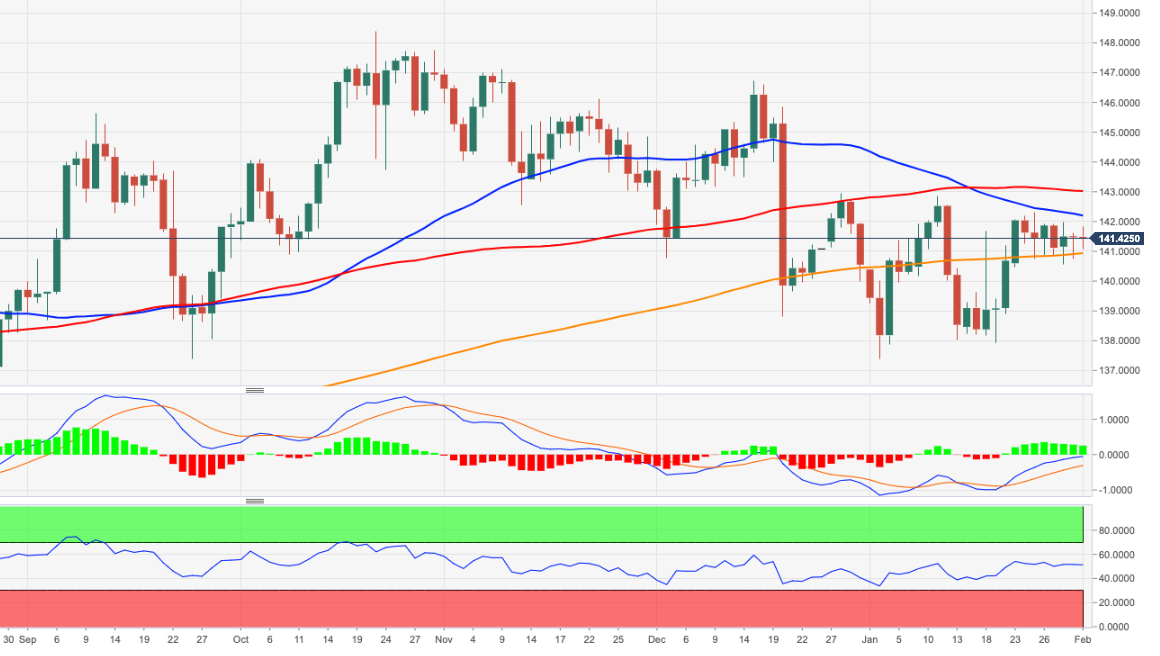
The Dollar peaked in late September, shortly after long-term US real rates peaked. In the view of economists at Société Générale, the next leg of Dollar weakness might be slower and not in a straight line.
A pause, perhaps? But not the end of the Dollar bear market
“The reluctance of the US market to price terminal fed funds above 5%, alongside the start of monetary policy tightening elsewhere, has shifted momentum away from the dollar. Meanwhile, upward revisions to global growth expectations have reduced fear of the dollar seeing safe-haven inflows.”
“In the short run, we may see a hiatus as the markets digest the US slowdown, the shift in relative momentum between the Fed and other central banks, and the less-bad-than-feared global economic backdrop. That may mean the next leg of Dollar weakness is slower and isn’t in a straight line.”
EUR/USD has failed at the key technical level of 1.0944/48 and holds short-term momentum divergence, which points to the potential for a short-term sell-off, economists at Credit Suisse report.
Short-term momentum turns lower on the back of a bearish divergence
“We continue to look for a top at 1.0944/48 for now and for a deeper setback over the next week or so, especially with short-term momentum turning lower on the back of a bearish divergence, with first support at 1.0767/36. Below here would trigger a deeper short-term sell-off, with support then seen next at the 55DMA, currently at 1.0618, which is the most we can envisage the market falling at this stage.”
“Bigger picture, our bias recently shifted and we now look for an eventual break above 1.0944, post a pullback, with next resistance at 1.1185, potentially the 61.8% retracement at 1.1275.”
Economists at Nordea expect the EUR/NOK pair to remain rabebound in the near term and start to edge lower in the second half of the year.
Lower EUR/NOK toward year-end
“It is likely EUR/NOK will remain rangebound in the short term in the interval 10.50-11.00. However, we expect to see a lower EUR/NOK toward year-end.”
“Bright spots for the NOK should be higher petroleum investments (implies increased NOK buying from oil companies), the reopening of China which means higher oil prices, and central banks pausing their rate hikes.”
“We see EUR/NOK at 10.20 by mid-2023 and around 10.00 at end-2023.”
Economist at UOB Group Ho Woei Chen reviews the recent prints from PMIs in the Chinese economy.
Key Takeaways
“Both the official manufacturing and non-manufacturing PMIs are back in expansion (defined as a reading above 50) in Jan for the first time in four months, having rebounded from their lowest since Feb 2020 just a month ago.”
“Activities have recovered swiftly after China relaxed its zero-Covid policy and reopened its borders to international travelers from 8 Jan. The sharp jump in the non-manufacturing PMI is consistent with anecdotal evidence of a strong boost in consumption spending during the Spring Festival holidays (21-27 Jan).”
“With China largely avoiding a further surge in Covid-19 infections following the Lunar New Year holidays, this should pave the way for stronger improvement in consumption and a rebound in GDP growth in 1Q23. However, we think the consumption recovery still faces some headwinds from falling global demand, a weaker jobs market and further downturn in the real estate market. These factors will affect income growth and household wealth, thus the propensity for spending may weaken after the initial bounce.”
“We retain our cautiously optimistic outlook for China’s GDP growth at 5.2% this year with the potential for an upgrade should China’s consumption continue to improve and the drag from the real estate market eases while global economy achieves a soft-landing this year.”
Considering advanced prints from CME Group for natural gas futures markets, open interest rose for the sixth consecutive session on Tuesday, this time by around 6.3K contracts. In the same direction, volume increased for the second straight day, now by around 44.7K contracts.
Natural Gas: Some support emerged near $2.50
Prices of the natural gas managed to halt the multi-week steep decline somewhat after advancing marginally on Tuesday. The small rebound was in tandem with increasing open interest and volume and should be indicative that further bounce like ahead. So far, the $2.50 region per MMBtu seems to have emerged as quite a firm and initial contention zone.
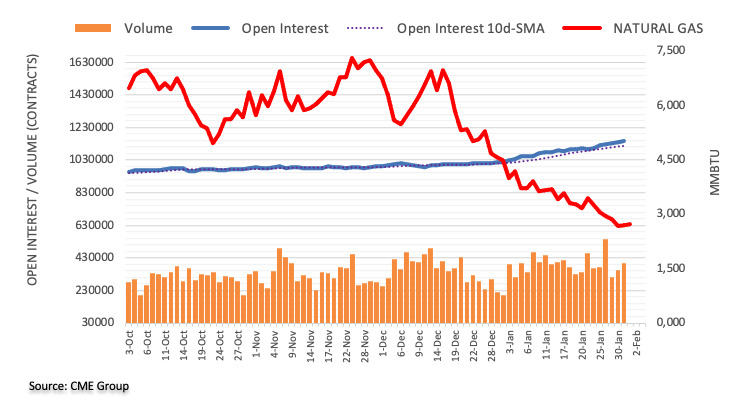
UOB Group’s Economist Lee Sue Ann and Markets Strategist Quek Ser Leang, still see USD/CNH trading between 6.7270 and 6.7950 in the next few weeks.
Key Quotes
24-hour view: “We held the view that USD “is likely to consolidate between 6.7400 and 6.7700” yesterday. Our view for consolidation was not wrong, however, USD traded within a narrower range than expected (6.7489/6.7665). Further consolidation appears likely, expected to be between 6.7400 and 6.7680.”
Next 1-3 weeks: “There is not much to add to our update from yesterday (31 Jan, spot at 6.7580). As highlighted, the recent build-up in upward momentum has faded and USD is likely to trade sideways within a range of 6.7270/6.7950 for now.”
The Dollar enters FOMC day after having shown some resilience over the past few sessions. A push-back against a pivot and rate-cut speculation could hit risk assets and lift the Dollar, economists at ING report.
Chair Powell may see little interest in sounding materially less hawkish just yet
“We are in the camp of expecting Powell to maintain his hawkish rhetoric despite this appearing less appropriate given the backdrop of slowing inflation and growth. This outcome may ultimately have some negative implications for risk and give the Dollar some support, as bets on a pivot, and potentially on rate cuts, are scaled back. Any communication missteps or deliberate dovish tilts, on the other hand, can surely revive that Dollar bear trend that appears to have halted lately.”
“We also have some US data to watch today: ISM manufacturing, ADP payrolls and JOLTS jobs openings. Substantial surprises on those releases are likely needed to drive major Dollar moves ahead of such a big event like the FOMC.”
See – Fed Preview: Forecasts from 16 major banks, dialing down rate hike to 25 bps
CME Group’s flash data for crude oil futures markets noted traders extended the uptrend in open interest and added around 15.6K contracts on Tuesday. Volume followed suit and went up by around 11.2K contracts, partially reversing the previous drop.
WTI remains focused on $82.60
Prices of the WTI charted a decent advance on Tuesday, coming back after dropping to 3-week lows near $76.60. The rebound was amidst increasing open interest and volume and is supportive of the continuation of the bounce at least in the very near term. Next on the upside for the commodity comes the YTD top at $82.60 per barrel (January 23).
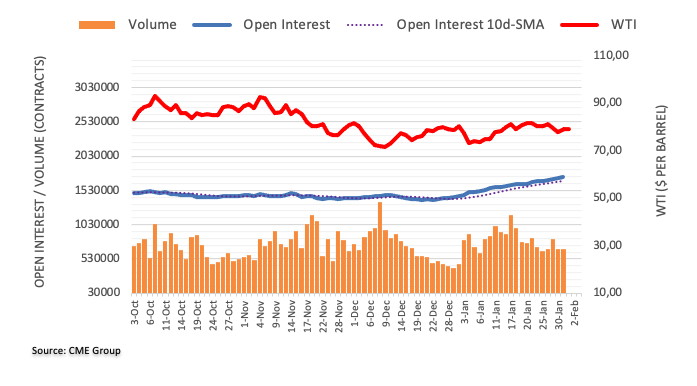
- GBP/USD remains confined in a narrow trading band as traders keenly await the FOMC decision.
- Bets for smaller Fed rate hikes continue to weigh on the USD and lend some support to the pair.
- A softer risk tone limits losses for the safe-haven Greenback and acts as a headwind for the major.
The GBP/USD pair struggles to gain any meaningful traction on Wednesday and oscillates in a narrow band through the first half of the European session. The pair is currently placed above the 1.2300 mark, nearly unchanged for the day, as traders now seem to have moved to the sidelines ahead of the highly-anticipated FOMC policy decision.
Heading into the key central bank event risk, bets for a smaller Fed rate hike keep the US Dollar bulls on the defensive and lend some support to the GBP/USD pair. In fact, the markets seem convinced that the US central bank will slow the pace of its policy-tightening cycle amid signs of easing inflationary pressures. The expectations were reaffirmed by Tuesday's release of the US wage growth data, showing that labor costs increased less than expected in the fourth quarter.
The recent US macro data, however, pointed to a resilient economy and suggested that the Fed is still going to sound more hawkish. Furthermore, several FOMC members have stressed the need to keep interest rates higher for longer in order to bring down inflation. Apart from this, the prevalent cautious market mood - amid the pre-Fed anxiety - helps limit the downside for the safe-haven greenback and acts as a headwind for the GBP/USD pair, at least for the time being.
Traders now look forward to the US economic docket, featuring the release of the ADP report on private-sector employment, ISM Manufacturing PMI and JOLTS Job Openings data. The focus, however, will remain glued to the FOMC monetary policy statement. This, along with Fed Chair Jerome Powell's comments at the post-meeting press conference, will be scrutinized for clues about future rate hikes. The outlook will play a key role in influencing the near-term USD price dynamics.
The market attention will then shift to the Bank of England (BoE) policy meeting on Thursday amid bets that elevated consumer inflation will force the central bank to continue lifting rates. Nevertheless, the decision will further contribute to determining the next leg of a directional move for the GBP/USD pair.
Technical levels to watch
Open interest in golf futures markets shrank for the fourth consecutive session on Tuesday, this time by just 867 contracts according to preliminary readings from CME Group. Volume, instead, went up by around 34.8K contracts after two daily drops in a row.
Gold faces initial support around $1900
Tuesday’s sharp decline and subsequent bounce off lows near $1900 was accompanied by shrinking open interest, which leaves the door open to the probability of further corrective moves in the very near term. That said, the $1900 neighbourhood per ounce troy of gold emerges as an immediate contention zone for the time being.
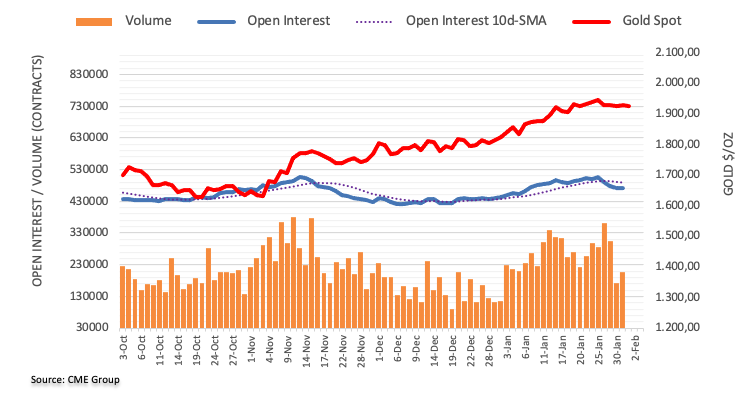
The likelihood of further gains remains unchanged once USD/JPY clears 131.15, comment UOB Group’s Economist Lee Sue Ann and Markets Strategist Quek Ser Leang.
Key Quotes
24-hour view: “Yesterday, we highlighted that ‘the rebound from the low has room to extend but a sustained advance above 130.80 appears unlikely’. Our expectations did not materialize as USD traded between 129.73 and 130.53. The price actions are likely part of a consolidation phase and USD is expected to trade within a range of 129.60/130.60 today.”
Next 1-3 weeks: “Our update from yesterday (31 Jan, spot at 130.40) is still valid. As highlighted, while upward momentum is showing signs of increasing, USD has to break above 131.15 before a sustained advance is likely. The chance of USD breaking above 131.15 will remain in place as long as USD stays above 129.30 (no change in ‘strong support’ level) within the next few days. Looking ahead, the next resistance level above 131.15 is at 132.00.”
Economists at ABN Amro think there is more upside in EUR/USD than they had forecast for 2023 and 2024.
Fed to take the upper bound of the fed funds rate to 5%
“We expect the Fed to take the upper bound of the fed funds rate to 5%. However, we still expect significant rate cuts in H2 23 and far more than market consensus (a total of 125 bps compared to 50 bps of cuts). This is negative for the US Dollar. Meanwhile, we have become less negative on the growth outlook for the Eurozone.”
“As a result of these dynamics, we have upgraded our EUR/USD to 1.12 (from 1.08) end of 2023 and to 1.16 (from 1.12) end of 2024.”
According to UOB Group’s Economist Lee Sue Ann and Markets Strategist Quek Ser Leang, AUD/USD is now predicted to navigate within the 0.6960-0.7130 range in the short-term horizon.
Key Quotes
24-hour view: “We highlighted yesterday that ‘downward momentum has improved a tad and the bias for AUD is on the downside’. We added, ‘As momentum is not strong for now, any decline is unlikely to challenge the major support at 0.6995’. AUD weakened more than expected as it dropped to a low of 0.6988. The decline was however short-lived as AUD rebounded to end the day little changed at 0.7054 (-0.09%). The rebound amid oversold conditions suggests AUD is unlikely to weaken further. Today, AUD is more likely to trade sideways between 0.7010 and 0.7090.”
Next 1-3 weeks: “Our update from yesterday (31 Jan, spot at 0.7060) is still valid. As highlighted, AUD appears to have entered a consolidation phase and it is likely to trade within a range of 0.6960/0.7130 for now.”
Inflation in the euro area, as measured by the Harmonised Index of Consumer Prices (HICP), declined to 8.5% on a yearly basis in January from 9.2% in December, Eurostat announced on Wednesday. This reading came in below the market expectation of 9%.
The Core HICP declined by 0.8% on a monthly basis in January but the annual rate remained unchanged at 5.2%, compared to analysts' estimate of 5.1%.
Market reaction
The EUR/USD showed no immediate reaction to these figures and was last seen trading at 1.0885, where it was up 0.2% on a daily basis.
- Gold price edges lower on Wednesday, though the downside is likely to remain cushioned.
- A modest US Dollar downtick could lend support to the XAU/USD amid a softer risk tone.
- The market focus remains glued to the Federal Open Market Committee (FOMC) decision.
Gold price struggles to capitalize on the overnight goodish rebound from the $1,900 mark, or a nearly two-week low and edges lower on Wednesday. The XAU/USD remains on the defensive through the first half of the European session and is currently trading just below the $1,925 level. The downside, however, seems cushioned, at least for now, as traders might refrain from placing aggressive directional bets ahead of the key central bank event risk.
Gold price draws support from weaker US Dollar
The Federal Reserve (Fed) will announce its decision at the end of a two-day policy meeting later today and is widely expected to further slow the pace of the rate-hiking cycle. In fact, the CME's FedWatch Tool points to a nearly 100% chance of a smaller 25 basis points (bps) rate hike amid signs of easing inflationary pressures in the United States (US). The bets were reaffirmed by Tuesday's release of the US wage growth data, which showed that labor costs increased less than expected in the fourth quarter. This, in turn, leads to a fresh leg down in the US Treasury bond yields and continues to weigh on the US Dollar. A weaker Greenback could act as a tailwind for the US Dollar-denominated Gold price.
Hopes for hawkish Federal Reserve cap Gold price
The recent US macro data, however, point to point to a resilient economy and back the case for the Fed to stick to its hawkish stance for longer. Moreover, Fed officials have been stressing the need to keep rates higher for longer in order to bring down inflation. Hence, the market focus will be on the accompanying monetary policy statement and Fed Chair Jerome Powell's comments at the post-meeting press conference. Investors will look for cues about the Fed's future rate-hike path, which will influence the USD and determine the near-term trajectory for the non-yielding Gold price. In the meantime, the prevalent cautious market mood might contribute to limiting losses for the safe-haven XAU/USD.
Macro data from United States eyed for some impetus
Market participants now look to the US economic docket, featuring the release of the ADP report on private-sector employment, ISM Manufacturing PMI and JOLTS Job Openings. This, along with the US bond yields, could drive the USD demand and produce short-term opportunities around Gold price later during the early North American session. The immediate market reaction to the US macro data, however, is more likely to fizzle out quickly, supporting prospects for an extension of the intraday range-bound price action.
Gold price technical outlook
From a technical perspective, the $1,900 level now seems to have emerged as an immediate strong support. A convincing break below might prompt some technical selling and expose the $1,880-$1,877 support. Gold price could eventually slide to test the next relevant support near the $1,856-$1,855 region, which if broken decisively will shift the near-term bias in favour of bearish traders.
On the flip side, any meaningful upside is likely to confront some resistance near the multi-month top, around the $1,949 region touched on January 26. A sustained strength beyond has the potential to lift the Gold price to the $1,969-$1,970 region. The momentum could get extended further and allow the XAU/USD to surpass an intermediate hurdle near the $1,980 zone. Bulls might then aim to reclaim the $2,000 psychological mark for the first time since March 2022.
Key levels to watch
EUR/GBP has surged beyond the 0.8800 level. The pair could extend its rise on a hawkish Federal Reserve, according to economists at ING.
Downside risks from a hawkish Fed
“We think there is now less scope for the ECB to push the Euro even higher, which means more fuel to the EUR/GBP rally may be mostly a function of risk sentiment rather than monetary policy divergence.”
“Since the Pound tends to be more sensitive to global risk sentiment than the Euro, the risks are skewed to the upside for EUR/GBP today given our baseline scenario for a hawkish Fed weighing on risk assets.”
“Cable may drop to the 1.2200 mark today.”
See – Fed Preview: Forecasts from 16 major banks, dialing down rate hike to 25 bps
The Swedish Krona has been a negative standout in the G10 space over the past few days. However, economists at ING still believe that the SEK will be able to recover and target sub-11.00 levels before the summer.
The risk of a black-swan scenario in Sweden has not dramatically increased
“Since we don’t believe the risk of a black swan scenario in Sweden has materially increased, we think that SEK will recover gradually over the coming months.”
“We still expect a return to the 10.60-70 levels by the second half of this year, even though upside risks for EUR/SEK have modestly risen.”
- EUR/USD adds to Tuesday’s advance and approaches 1.0900.
- EMU Flash inflation Rate, Unemployment Rate next of note in the bloc.
- The FOMC event, ISM Manufacturing take centre stage later in the session.
The European currency keeps the optimism unchanged for the second session in a row and lifts EUR/USD back to the vicinity of the 1.0900 hurdle on Wednesday.
EUR/USD looks at EMU data, FOMC decision
EUR/USD advances for the second straight session midweek on the back of the renewed offered stance in the greenback and ahead of key releases on both sides of the ocean as well as the key FOMC event due later in the European evening.
The recent knee-jerk in the dollar came in response to disappointing results from the US labour market in Q4 2022 which at the same time reinforced the idea of a Fed’s pivot that could emerge in the near term.
Closer to home, dwindling concerns around a potential recession in the region continues to bolster the recent upside bias in the single currency, although the persistent elevated inflation could prompt the ECB to keep its tightening cycle unaltered for the time being. on this, the ECB meets on Thursday and is expected to hike rates by half percentage point.
Back to the domestic calendar, advanced EMU Q4 GDP Growth Rate is due later seconded by the Unemployment Rate in the region. In addition, final Manufacturig PMIs are also scheduled.
Across the pond, MBA Mortgage Applications, the ISM Manufacturing, JOLTs Job Openings, the ADP report, final Manufacturing PMOI and Construction Spending are also due.
What to look for around EUR
The acute comeback allows EUR/USD to flirt once again with the key 1.0900 neighbourhood ahead of the FOMC gathering and the ECB event.
In the meantime, price action around the European currency should continue to closely follow dollar dynamics, as well as the potential next steps from the ECB and the Federal Reserve at their upcoming gatherings in the next week.
Back to the euro area, recession concerns now appear to have dwindled, which at the same time remain an important driver sustaining the ongoing recovery in the single currency as well as the hawkish narrative from the ECB.
Key events in the euro area this week: Germany Retail Sales/Unemployment Rate/Flash Inflation Rate, EMU Flash Q4 GDP Growth Rate (Tuesday) – Germany, EMU Final Manufacturing PMI, EMU Flash Inflation Rate/Unemployment Rate (Wednesday) – Germany Balance of Trade, ECB Interest Rate Decision, ECB Lagarde (Thursday) - Germany, EMU Final Services PMI (Friday).
Eminent issues on the back boiler: Continuation of the ECB hiking cycle amidst dwindling bets for a recession in the region and still elevated inflation. Impact of the Russia-Ukraine war on the growth prospects and inflation outlook in the region. Risks of inflation becoming entrenched.
EUR/USD levels to watch
So far, the pair is gaining 0.22% at 1.0884 and faces the next up barrier at 1.0929 (2023 high January 26) followed by 1.0936 (weekly high April 21 2022) and finally 1.1000 (round level). On the other hand, the breakdown of 1.0802 (weekly low January 31) would target 1.0766 (weekly low January 17) en route to 1.0625 (55-day SMA).
- USD/JPY extends its sideways consolidative price move and remains below the mid-130.00s.
- Bets for smaller rate hikes by the Fed weigh on the USD and act as a headwind for the pair.
- The cautious market mood underpins the JPY and further contributes to capping the upside.
The USD/JPY pair struggles to gain any meaningful traction and seesaws between tepid gains/minor losses through the early part of the European session on Wednesday. Spot prices remain below the mid-130.00s as traders seem reluctant and keenly await the outcome of a two-day FOMC monetary policy meeting.
The Fed will announce its decision later during the US session and is widely expected to moderate the pace of its rate-hiking cycle amid signs of easing inflationary pressures. The bets were reaffirmed by the US wage growth data released on Tuesday, which showed that labor costs increased less than expected in the fourth quarter. This, in turn, is seen dragging the US Treasury bond yields lower and weighing on the US Dollar, which, in turn, acts as a headwind for the USD/JPY pair.
Investors, meanwhile, turn cautious heading into the key central bank event risk. This is evident from the prevalent cautious mood around the equity markets and lends support to the safe-haven Japanese Yen (JPY). Apart from this, speculation that high inflation may invite a more hawkish stance from the Bank of Japan (BoJ) later this year underpins the JPY. The fundamental backdrop favours bearish traders and suggests that the path of least resistance for the USD/JPY pair is to the downside.
Even from a technical perspective, the recent price action witnessed over the past two weeks or so constitutes the formation of a symmetrical triangle. Against the backdrop of a sharp corrective fall from over a three-decade top, the said triangle could be categorized as a bearish pennant and validates the negative outlook for the USD/JPY pair. Hence, any attempted recovery move might still be seen as a selling opportunity and runs the risk of fizzling out rather quickly.
Market participants now look forward to the US economic docket, featuring the release of the ADP report on private-sector employment, ISM Manufacturing PMI and JOLTS Job Openings data. This, along with the US bond yields, might influence the USD price dynamics and provide some impetus to the USD/JPY pair. Apart from this, traders will take cues from the broader market risk sentiment to grab short-term opportunities ahead of the highly-anticipated FOMC policy decision.
Technical levels to watch
Economists at BBH expect a 25 bps hike and a very hawkish tone from the Fed. With risks to U.S. rates weighted to the upside, the dollar is likely to benefit from any bond market repricing of Fed policy.
DXY is in the process of carving out a near-term bottom
“We believe the dollar is in the process of carving out a near-term bottom. DXY has seen some support emerge just below 102. If it can establish a good base at current levels until the Fed narrative shifts again, the Dollar would be well-positioned to first challenge the January high near 105.631.”
“USD/JPY is vulnerable to renewed selling if the Bank of Japan starts removing accommodation this year, as we expect. However, the pace of tightening would be very modest and so further Yen gains beyond the knee-jerk reaction will be tough.”
“We believe US yields should move higher if and when a more hawkish narrative is established. In turn, this should help the Dollar recover some ground.”
See – Fed Preview: Forecasts from 16 major banks, dialing down rate hike to 25 bps
GBP/USD remains consolidative and should navigate the 1.2250-1.2430 range in the next weeks, suggest UOB Group’s Economist Lee Sue Ann and Markets Strategist Quek Ser Leang.
Key Quotes
24-hour view: “While we expected GBP to weaken yesterday, we were of the view that ‘it is unlikely to break the support at 1.2295’. The anticipated weakness exceeded our expectations as GBP dropped to 1.2285 before recovering. Today, the risk for GBP still appears to be on the downside even though the major support at 1.2250 is unlikely to come under threat. On the upside, a break of 1.2365 (minor resistance is at 1.2345) would indicate that the downside risk has faded.”
Next 1-3 weeks: “We indicated yesterday (31 Jan, spot at 1.2350) that the GBP strength from earlier this month has ended. We added, GBP has likely moved into a consolidation phase and is likely to trade between 1.2250 and 1.2430 for the time being. GBP subsequently dropped to 1.2285 before rebounding. While short-term momentum has improved somewhat, we continue to hold the view that GBP is in a consolidation phase. Looking ahead, if GBP breaks and stays below 1.2250, it would increase the risk of a pullback toward 1.2130.”
EUR/USD will inevitably be heavily impacted by the post-FOMC reaction today. Economists at ING believe that the pair could test the 1.08 support.
An exploration of the 1.0700-1.0750 range is surely possible in the near term
“In line with our view for a positive impact on the Dollar, we think the 1.0800 support could be heavily tested after the Fed announcement.”
“We think that EUR/USD will ultimately come out weaker from these two days of central bank activity.”
“An exploration of the 1.0700-1.0750 range is surely possible in the near term, even though the longer-term outlook keeps pointing to a Dollar decline and EUR/USD strength.”
See – Fed Preview: Forecasts from 16 major banks, dialing down rate hike to 25 bps
USD/SGD is down ~8% from its peak in October 2022. Economists at TD Securities believe that the pair could dive below 1.30.
SGD typically has a high beta to the USD
“USD/SGD has broken below its medium-term uptrend (monthly chart) which may signal a new trading range after holding in the 1.31-1.45 range for the past 8 years.”
“We see 1.30 as the next big support level though a break below rests more on USD weakness.”
“Our bearish USD house view which sees a plunge in the USD from Q2 may spark the next big move for USD/SGD below 1.30 as SGD typically has a high beta to the USD.”
Ulrich Leuchtmann, Head of FX and Commodity Research at Commerzbank, expect Sterling to remain under pressure following bleak prospects for the UK economy.
IMF predicts recession in the UK – and only in the UK
“The IMF assumes that this year the UK will be the only major economy to have to go through a recession. And the IMF also expects that no major economy will record slower growth than the UK even next year. That is not good news for Sterling.”
“A scenario in which Sterling has to be valued weaker has become at least marginally more likely. And that is putting pressure on Sterling already now.”
“I wonder: How are these concerns going to disappear short-term? And that is why I consider the GBP weakness to be sustainable for now.”
Ulrich Leuchtmann, Head of FX and Commodity Research, lacks the imagination to see the US Dollar benefiting from the US Federal Reserve's (Fed) policy announcements.
Convincing Powell needed to lift the USD
“Fed Chair Jay Powell will have to sell to the market why he and his colleagues will be reducing the speed of the rate steps before the promised key rate level has been reached. So far I am unsure how he is going to manage that convincingly. Only if he succeeds, USD will be able to profit.”
“I cannot promise that the FOMC decision will be USD-negative, all I can say is: I lack the imagination for a USD-positive result.”
See – Fed Preview: Forecasts from 16 major banks, dialing down rate hike to 25 bps
- Silver stalls the overnight recovery move near the $23.70-80 support breakpoint.
- The technical setup warrants some caution before placing fresh directional bets.
- A break below the $23.00 mark is needed to support prospects for deeper losses.
Silver struggles to capitalize on the previous day's goodish rebound from sub-$23.00 levels, or over a one-week low and oscillates in a narrow band through the early European session on Wednesday. The white metal is currently placed just above the mid-$23.00s, consolidating around the 200-hour SMA.
From a technical perspective, the XAG/USD remains capped near the $23.70-$23.80 support breakpoint, marking the lower end of a short-term ascending trend channel. The said area might act as a pivotal point for traders, which if cleared decisively should pave the way for some meaningful upside.
The XAG/USD might then aim to surpass the $24.00 round figure and retest the multi-month top, around the $24.50-$24.55 zone touched in January. The positive momentum could get extended further and allow bullish traders to reclaim the $25.00 psychological mark for the first time since April 2022.
That said, neutral technical indicators on daily/4-hour charts warrant some caution before positioning for a further near-term appreciating move. Moreover, the recent rangebound price action witnessed since December 21 points to indecision among traders over the next leg of a directional move for the XAG/USD.
In the meantime, the $23.30 area might now protect the immediate downside ahead of the overnight low, around the $23.00-$22.95 region. This is closely followed by support near the $22.75 region, which if broken decisively will make the XAG/USD vulnerable to fall towards the $22.20-$22.15 support.
Silver 1-hour chart

Key levels to watch
The December quarter labour market surveys were strong if a touch softer than expected. With higher interest rates now weighing on the economy, economists at Westpac think the jobs market has reached a turning point.
Turning point?
“The unemployment rate rose to 3.4%, slightly higher than forecast.”
“While the jobs market is coming from a very strong starting point, there is good reason to expect a deterioration in the years ahead. In contrast, wage inflation remains on the rise, and the turning point is likely to come later.”
“We continue to expect a 0.5% increase in the Official Cash Rate later this month.”
Month-end flows dominated markets. In the view of economists at Commerzbank, there is a certain underlying volatility that escapes any form of explanation
Choppy markets
“‘Choppy markets’ is probably the term to use for what we are seeing at the moment, or – if you want to disguise your cluelessness in a slicker manner – ‘month-end flows’.”
“Regardless of all the clever talk that we and others produce on a daily basis as a kind of background music to market events, we have to point out that there is a certain underlying volatility that escapes any form of explanation. It cannot be any different in an efficient market that always has to remain difficult.”
The US Federal Reserve will announce its monetary policy decision on Wednesday, February 1 at 19:00 GMT and as we get closer to the release time, here are the expectations as forecast by analysts and researchers of 16 major banks.
The Fed is set to raise rates by 25 basis points (bps) – that is fully priced in – despite some signs of economic weakness.
ANZ
“We expect that the FOMC will raise the fed funds target by 25 bps and guide that further rate rises will be appropriate amid cautious optimism that inflation will subside sustainably. We also expect it will guard against relaxing the fight against inflation too early. Risk management of the cost-of-living crisis skews policy towards over, rather than under tightening. We are increasingly confident that inflation will subside. However, we think that CPI inflation may overstate price weakness this year and, with the labour market still very tight, rates will remain at peak levels in 2023.”
Danske Bank
“The Fed looks keen on raising Fed funds rate to 5%. We expect a 25 bps rate hike followed by another 25 bps hike in March and May, respectively. A turn in the business cycle and drop in short-term inflation expectations pave the way for rate cuts next year, but the neutral rate is higher than before the crisis. We think the trajectory for Fed funds discounted by markets looks broadly fair, but we see slight upside to the front end of the curve and in particular 6M-2Y.”
Westpac
“Coming into the Jan/Feb meeting, the market believes US inflation is well on its way back to the FOMC’s target, leaving the Committee with little more to do. indeed, it could be argued that, were the FOMC not as resolute in their determination to remove all inflation risks, the market could have seen this meeting as the last move – so confident participants have become in the US inflation outlook. Since the CPI peaked in June 2022, we have anticipated a rapid easing in pressures and risks. But, we also recognise it will likely take until March for the FOMC to feel confident to stop. Hence we expect this cycle to end with 25 bps hikes in Feb and Mar.”
Commerzbank
“The Federal Reserve is likely to raise the target range for federal funds by just 25 bps, having already shortened the rate hike to 50 bps at its last meeting. The economy is cooling down as desired, and inflationary pressure seems to be easing noticeably. The rate peak is therefore no longer too far away.”
Nordea
“The Fed will likely slow down its rate hikes again, and deliver a 25 bps rate hike. A key part of the statement says the Committee anticipates that ongoing increases in the target range will be appropriate. If that part is maintained, this would suggest that the Fed still expects to raise rates more than once after this week, which would be more than the market is currently pricing in. We think that part will be included, which could be perceived slightly hawkishly at least as a first response, given that the market is not pricing in much more than a 25 bps rate hike this week. Such a hawkish move could easily be reversed after Powell’s comments, which are likely to illustrate that the peak in rates is approaching.”
Rabobank
“The recent decline in inflation has increased the probability of a further reduction in the size of the Fed’s rate hikes to 25 bps in February, from 50 bps in December. We continue to think that based on the fading momentum of inflation, the FOMC is likely to stop at a 4.75-5.00% target range and pause for the remainder of the year. Meanwhile, we still see upside risks to inflation and the federal funds rate during the course of the year if new negative supply shocks take place and/or the wage-price spiral gets out of hand.”
SocGen
“We expect a 25 bps rate hike and steady increases until the fed funds rate reaches the 5.0-5.25% target range.”
CIBC
“A quarter-point hike is well-telegraphed from the Fed, and we still see one more such move ahead, in part as a necessary counterweight to the easing in monetary conditions that financial markets have generated in pushing term yields lower. To combat that trend, look for the Fed’s messaging to lean strongly away from the notion that it will have room to cut rates in the back half of this year.”
Wells Fargo
“We expect the FOMC will raise the fed funds target range by 25 bps. This would be the smallest increase since the very first hike of the tightening cycle in March 2022. Ultimately, this meeting should signal that the Fed's work on this hiking cycle is nearer completion but not yet done. Our current expectations are for 75 bps more cumulative tightening, bringing the target range for the fed funds rate to 5.00%-5.25%. If our forecast is correct, then we would still have two more 25 bps rate hikes at the March and May FOMC meetings.”
Barclays
“We expect the FOMC to again slow the pace of hikes, raising the target range by 25 bps to 4.5-4.75%. Such a move would be in line with pre-blackout FOMC communications and supported by accumulating evidence that inflation and wage growth are decelerating, and signs of a slowing economy. A key challenge for the FOMC will be to execute its transition to smaller rate hikes without furthering expectations that an end to its hiking cycle is imminent. The post-meeting press conference should be particularly interesting in that respect. We expect Powell to signal a peak rate of 5.1% in 2023, possibly by mentioning that last December’s dot plot by the FOMC remains appropriate.”
BofA
“We look for the Fed to raise the target range for the federal funds rate by 25 bps to 4.50-4.75%. The message: Still cautious about inflation. While the Fed appears to favor another downshift in the pace of rate hikes, communication during the intermeeting period suggests policymakers have not changed their view on where the terminal funds rate is likely to end up or the view that inflation pressures will subside slowly. In other words, passing peak inflation is welcome and policymakers appear to have increased confidence that inflation is on a path lower, but the Fed is not yet convinced that inflationary pressures will dissipate quickly.”
RBC Economics
“We do expect the size of its rate increase to mirror the BoC’s at 25 bps. That’s half the size of its December hike and would take the fed funds target range to 4.5% to 4.75%. In December, most Federal Open Market Committee participants expected that the fed funds target range would need to be lifted above 5% this year. But we expect a pause in the slightly lower range of 4.75% to 5% – provided ongoing softening in US inflation and growth trends persists.”
NBF
“The Fed is all but assured to deliver a 25 bps increase, which would bring the upper bound of its target range to 4.75%. We’ll be closely watching the guidance provided by the FOMC, both in the statement and in Chair Powell’s post-meeting press conference, to see if this has materially impacted their expected rate trajectory. It’s expected that the Fed will continue to guide markets towards a 25 bps hike in March but continued softness could change that before the following meeting.”
ING
“We expect the Fed to raise the policy rate by 25 bps. This marks a clear slowdown in the pace of tightening and appears justified given inflation is moving in the right direction and activity is slowing. However, the Fed remains wary and will again suggest that this is not the end for interest rate increases. The central bank will also be keen to dismiss the notion that it is preparing for potential rate cuts later this year. Financial conditions have loosened given movements in the Dollar, Treasury yields and credit spreads and it may feel that any further loosening, fuelled by talk of potential policy easing in the second half of the year, could undermine its current actions in fighting inflation.”
Citibank
“We expect the Fed to raise rates by 25 bps with modest hawkish risks. The statement will likely continue to reflect that ‘ongoing increases’ or perhaps ‘further increase’ will be appropriate. A dovish surprise would be language change to ‘some further increases’ or dropping the forward guidance altogether. Powell will likely take the opportunity to reassert that policy rates will likely rise to above 5% and stay there, but he may be happy to give relatively little push-back to current market pricing and await further data to more clearly indicate the appropriate trajectory for policy rates.”
Erste Bank
“A rate hike of 25 bps is emerging quite clearly for us. The outlook that the FOMC and Fed Chairman Powell will give the markets should not change much. Further interest rate hikes are likely to be in the cards, precisely because the data is not yet sufficient to confirm a sustained downturn in inflation. We expect another rate hike of 25 bps in March, which should be the end of the rate hikes.”
- AUD/USD gains some follow-through traction on Wednesday amid a modest USD downtick.
- Bets for smaller rate hikes by the Fed continue to weigh on the buck and lend some support.
- The cautious market mood might cap gains for the risk-sensitive Aussie ahead of the FOMC.
The AUD/USD pair builds on the previous day's goodish rebound from the 0.6985 area, or over a one-week low and gains some follow-through traction on Wednesday. Spot prices climb to the 0.7075 region during the early European session, though any subsequent move up is more likely to remain capped ahead of the key central bank event risk.
The Federal Reserve (Fed) will announce its decision at the end of a two-day meeting on Wednesday and is expected to further moderate the pace of its rate-hiking cycle. Bets for a smaller 25 bps lift-off were cemented by the US wage growth data released on Tuesday, which showed that labor costs increased less than expected in the fourth quarter. The recent US macro data, however, point to a resilient economy and back the case for the Fed to stick to its hawkish stance for longer.
Hence, the focus will remain glued to the accompanying policy statement and Fed Chair Jerome Powell's comments at the post-meeting press conference. Investors will look for cues about the Fed's future rate-hike path, which will play a key role in influencing the US Dollar price dynamics and determining the near-term trajectory for the AUD/USD pair. In the meantime, a modest USD downtick is seen acting as a tailwind for the major and contributing to the intraday positive move.
That said, a softer risk tone - as depicted by a mildly negative sentiment around the equity markets - might hold back bulls from placing aggressive bets around the risk-sensitive Aussie. This makes it prudent to wait for a strong follow-through buying before confirming that the AUD/USD pair's pullback from the highest level since June 2022 has run its course. Traders now look to the US macro data - the ADP report, ISM Manufacturing PMI and JOLTS Job Openings - for some impetus.
Technical levels to watch
Here is what you need to know on Wednesday, February 1:
February starts with a bang as investors eye key macroeconomic data releases and the US Federal Reserve's (Fed) policy announcements. Eurostat will publish January inflation figures ahead of the European Central Bank's policy meeting on Thursday. The US economic docket will feature the ADP's private sector employment report and the ISM's Manufacturing PMI survey for January. After the Fed releases the policy statement alongside the interest rate decision at 1900 GMT, FOMC Chairman Jerome Powell will deliver his comments on the policy outlook and respond to questions from the press from 1930 GMT.
Federal Reserve Preview: The Good, the Bad and the Ugly, why the US Dollar would rise.
The US Dollar Index stays quiet near 102.00 early Wednesday after having snapped a three-day winning streak on Tuesday. The positive shift witnessed in risk sentiment following the Employment Cost Index data, which rose at a softer pace than expected in the fourth quarter, made it difficult for the US Dollar to outperform its rivals in the American session. Meanwhile, the benchmark 10-year US Treasury bond yield retreated to 3.5% and Wall Street's main indexes registered strong daily gains. With investors moving to the sidelines ahead of high-tier events, US stock index futures trade modestly lower on the day.
During the Asian trading hours, the data from New Zealand revealed that the Unemployment Rate edged higher to 3.4% in the fourth quarter from 3.3% in the third quarter. In the same period, Employment Change came in at +0.2%, falling short of the market expectation for an increase of 0.3%. NZD/USD came under bearish pressure and declined toward 0.6400 before recovering to 0.6450 in the early European morning. In the meantime, the Caixin Manufacturing PMI in China improved modestly to 49.2 in January from 49 but failed to trigger a significant market reaction.
EUR/USD registered small daily gains on Tuesday but lost its recovery momentum before reaching 1.0900. Inflation in the Euro area, as measured by the Harmonized Index of Consumer Prices, is forecast to edge lower to 9% on a yearly basis in January from 9.2% in December.
GBP/USD closed the third straight trading day in negative territory on Tuesday before going into a consolidation phase slightly above 1.2300 early Wednesday.
USD/JPY failed to make a decisive move in either direction on Tuesday and closed the day virtually unchanged. The pair extends its sideways grind above 130.00 mid-week. Jibun Bank Manufacturing PMI in Japan came in at 48.9 in January as expected.
Gold price staged an impressive rebound after having declined toward $1,900 on Tuesday. XAU/USD is having a difficult time gathering further bullish momentum but holding its ground at around $1,930.
Following Monday's sharp decline, Bitcoin recovered marginally on Tuesday. Early Wednesday, BTC/USD is fluctuating in a narrow range at around $23,000. Ethereum shook off the bearish pressure after having declined toward $1,500 earlier in the week and rose more than 1% on Tuesday. At the time of press, ETH/USD was trading marginally lower on the day at $1,575.
Gold price holds its recent range after testing the $1,900 mark on Tuesday. In the view of FXStreet’s Dhwani Mehta, XAU/USD appears ‘buy the dips’ trade.
Sellers need a daily closing below 21DMA at $1,907 to extend the correction
“The bright metal dropped sharply to the $1,900 threshold on Tuesday but staged a solid comeback thereafter. This suggests that Gold price remains a ‘buy the dips’ trade from a short-term technical perspective.”
“On the upside, Gold buyers need to find acceptance above the $1,935 hurdle to negate the recent downbeat mood. Further up, the move higher could challenge the $1,950 psychological level before attacking the $1,960 supply zone.”
“Gold sellers need a daily closing below the bullish 21-Daily Moving Average (DMA) at $1,907 to extend the correction from nine-month highs of $1,949. The last line of defense for Gold buyers stands at the $1,900 level, below which floors will open up toward the January 11 low of $1,867.”
GBP/USD picks up bids to reverse intraday losses, defending the previous day’s bounce off one-week low heading into Wednesday’s London open. Even so, the Cable pair remains down for the fourth consecutive day around 1.2325 by the press time.
That said, the options market signals seem to underpin the broadly bearish bias surrounding the GBP/USD pair, even if failing to support the latest rebound.
As a result, the options market indicator, namely the Risk Reversal (RR) prints a two-week and two-day losing streaks with the latest numbers being -0.070 and -0.040 on a weekly and daily basis. Alternatively, the monthly RR printed a 0.430 figures for January, marking the fourth consecutive positive number.
It should be noted that the RR is the difference between the call options and put options and generally directs the Cable price.
Talking about the quote’s latest inaction, the same could be linked to the cautious mood ahead of the Federal Open Market Committee (FOMC) monetary policy meeting. Even so, downbeat UK inflation expectations and housing statistics keep the GBP/USD bears hopeful.
Also read: GBP/USD: Downbeat UK inflation expectations, housing data supersede Brexit news above 1.2300, Fed eyed
- The index treads water near the 102.00 mark on Wednesday.
- The FOMC is largely anticipated to hike rates by 25 bps.
- Focus remains on Powell and potential futures steps by the Fed.
The greenback navigates a narrow range around the 102.00 zone when measured by the USD Index (DXY) ahead of the FOMC gathering later in the session.
USD Index remains focused on the Fed
The index trades within a tight range following Tuesday’s retracement, always around the 102.00 mark and amidst rising anxiousness among market participants in light of the imminent FOMC event.
While a 25 bps rate hike is widely expected, investors’ attention will also be on the subsequent press conference by Chief Powell and any hint regarding the next potential moves by the Fed, particularly a probable impasse in its normalization process (pivot).
Other than the FOMC gathering, it will be an interesting session data wise in the US economy, as MBA Mortgage Applications are due, seconded by the ISM Manufacturing, JOLTs Job Openings, the ADP report, final Manufacturing PMOI and Construction Spending.
What to look for around USD
The dollar gave away almost all of Tuesday’s gains and returned to its comfort zone around the 102.00 yardstick ahead of the Fed’s meeting later on Wednesday.
The idea of a probable pivot in the Fed’s policy continues to hover around the greenback and keeps the price action around the DXY somewhat subdued. This view, however, also comes in contrast to the hawkish message from the latest FOMC Minutes and recent comments from rate setters, all pointing to the need to advance to a more restrictive stance and stay there for longer, at the time when rates are seen climbing above the 5.0% mark.
On the latter, the tight labour market and the resilience of the economy are also seen supportive of the firm message from the Federal Reserve and the continuation of its hiking cycle.
Key events in the US this week: MBA Mortgage Applications, ADP Employment Change, Final Manufacturing PMI, ISM Manufacturing, Construction Spending, FOMC Interest Rate Decision (Wednesday) – Initial Jobless Claims, Factory Orders (Thursday) – Nonfarm Payrolls, Unemployment Rate, Final Services PMI ISM Non-Manufacturing (Friday).
Eminent issues on the back boiler: Rising conviction of a soft landing of the US economy. Prospects for extra rate hikes by the Federal Reserve vs. speculation of a recession in the next months. Fed’s pivot. Geopolitical effervescence vs. Russia and China. US-China trade conflict.
USD Index relevant levels
Now, the index is retreating 0.06% at 102.03 and the breach of 101.50 (2023 low January 26) would open the door to 101.29 (monthly low May 30 2022) and finally 100.00 (psychological level). On the upside, the immediate hurdle comes at the weekly high at 102.89 (January 18) followed by 105.63 (monthly high January 6) and then 106.47 (200-day SMA).
FX option expiries for Feb 1 NY cut at 10:00 Eastern Time, via DTCC, can be found below.
- EUR/USD: EUR amounts
- 1.0900 1.99b
- 1.0885 1.22b
- 1.0800 800.7m
- USD/JPY: USD amounts
- 130.50 635.6m
- 128.00 616m
- AUD/USD: AUD amounts
- 0.7185 1.05b
- 0.7000 572.1m
- 0.6920 526.7m
- USD/CAD: USD amounts
- 1.3400 420m
- EUR/GBP: EUR amounts
- 0.8700 765.9m
- 0.8800 510m
- USD/CNY: USD amounts
- 6.8200 1.1b
- 6.7400 1b
- USD/CHF remains on the back foot despite latest inaction.
- Sustained break of fortnight-old ascending trend line, U-turn from 200-EMA favor sellers.
- Buyers need successful trading below 61.8% Fibonacci retracement to retake control.
USD/CHF holds lower ground near 0.9160 during early Wednesday, following a clear downside break of the previous key support line.
The Swiss currency (CHF) pair’s latest inaction could be linked to the market’s cautious mood ahead of the Federal Open Market Committee (FOMC) monetary policy meeting.
However, the bearish MACD signals and a U-turn from the 200-bar Exponential Moving Average (EMA) seem to join the trend line break to keep sellers hopeful.
That said, multiple lows marked during January 18-20, close to 0.9150-45, seem to restrict the immediate downside of the USD/CHF pair.
Following that, a previous monthly low, as well as the yearly bottom, near 0.9085 will be in focus.
It should be noted that the 0.9100 threshold could act as an additional downside filter for the pair traders to watch during the weakness past 0.9145 while the August 2021 low near 0.9018 may challenge the USD/CHF bears past 0.9085.
Meanwhile, recovery moves need to cross the previous support line from January 18, close to 0.9205 by the press time, to recall the pair buyers.
Even so, the 200-EMA and the 61.8% Fibonacci retracement level of the pair’s January moves, respectively near 0.9270 and 0.9285, could probe the USD/CHF upside.
USD/CHF: Four-hour chart
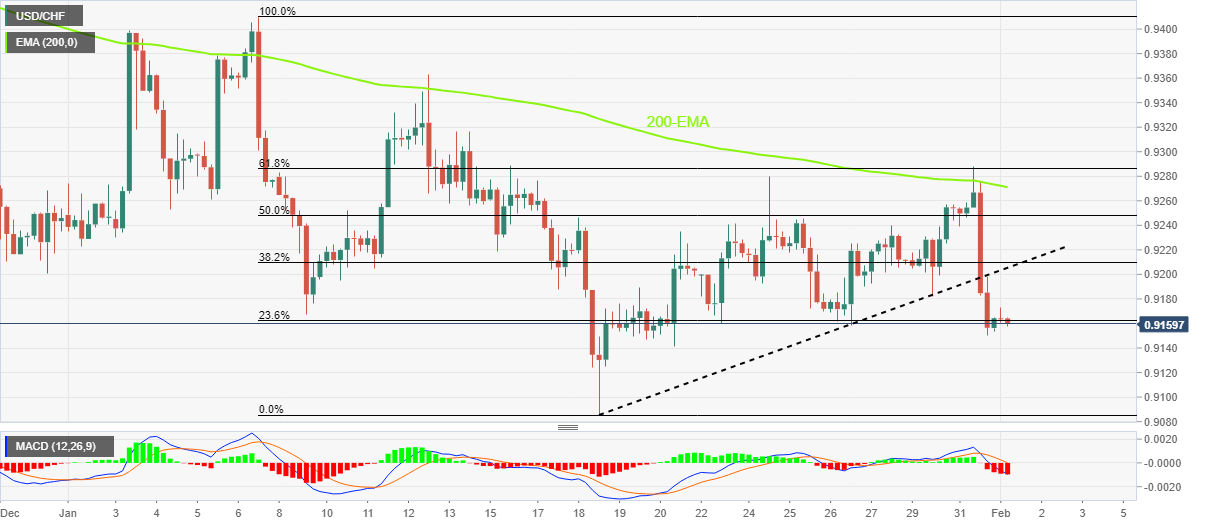
Trend: Further downside expected
- NZD/USD is scaling towards 0.6450 as the USD Index has retreated after a short-lived pullback.
- Federal Reserve is widely anticipated to announce a 25 bps interest rate hike to 4.50-4.75%.
- Reserve Bank of New Zealand might continue its hawkish stance despite weak Employment data.
- NZD/USD is testing the consolidation breakdown and is likely to display a fresh downside ahead.
NZD/USD has stretched its recovery above the critical resistance of 0.6440 in the early European session. The Kiwi asset displayed a recovery move after testing Tuesday’s low around 0.6415 due to subdued performance by the US Dollar Index (DXY). The USD Index is demonstrating topsy-turvy moves in a 101.70-101.80 range and is likely to display a downside break due to less anxiety among investors than usual ahead of the interest rate decision by the Federal Reserve (Fed).
S&P500 futures are failing to square off their losses that emerged in the Asian session, portraying a caution despite overall optimism in the market mood. Widely anticipated expression of further decline in the policy tightening pace by the Federal Reserve is not compelling the market participants to dump risk-sensitive assets. However, emerging United States recession fears due to the expectation of further stretch in the interest rate have shifted investors to the sidelines. The return generated by 10-year US Treasury bonds is hovering around 3.51% after a mild correction.
Lower Labor cost and consumer spending bolsters the case of the less-hawkish Fed’s policy
The Employment Cost Index (Q4) released on Tuesday was trimmed to 1.0% vs. the consensus of 1.1% and the prior release of 1.2%. Easing negotiation power for labor costs is music to the ears for the Federal Reserve, which is working hard to achieve price stability in the United States. Also, the Personal Consumption Expenditure (PCE) price index released last week showed that consumer spending contracted in December Christmas celebrations, which claims that the downside trend in the US Consumer Price Index (CPI) will continue further.
Economists at Goldman Sachs have come up with expectations for dictations by Federal Reserve chair Jerome Powell in February’s monetary policy meeting. They believe that "Since the FOMC last met in December, incoming data on wage growth and inflation have been encouraging, while signals on activity growth have been mixed and at times concerning. This ended up making the case for slowing the pace of rate hikes to 25bp this week quite easy.”
For further guidance, Goldman Sachs expects two additional 25bp hikes in March and May, but fewer might be needed if weak business confidence depresses hiring and investment.
US Employment data remains key ahead of Federal Reserve policy
The tight US labor market is losing its luster as firms are ditching the recruitment process due to a bleak economic outlook. Higher interest rates and lower retail demand has already forced the firms to suspend their expansion plans for some time. Also, a few firms are not operating at full capacity, which has trimmed the requirement of hiring fresh talent. This has also trimmed the negotiation power of employees to determine talent acquisition costs.
As per the consensus, the US Automatic Data Processing (ADP) (Jan) Employment data is seen at 170K, significantly lower than the former release of 235K. The declining scale of job additions due to weaker economic projections is going to delight the Federal Reserve as it will trim inflation projections further.
Apart from the Employment data, US ISM Manufacturing PMI (Jan) will be of significant importance. Manufacturing activities are expected to be slowed to 48.0 vs. 48.4 in the prior release as firms are not deploying their entire operating capacity. However, the New Order Index is seen higher at 46.1 vs. the former release of 45.2. An upbeat forward demand might provide some cushion to the USD Index.
New Zealand Dollar holds strength despite weak job data
The New Zealand Dollar remained extremely volatile in the Asian session due to the release of the Employment data (Q4) and Caixin Manufacturing PMI data. The Employment Change dropped to 0.2% from the expectations of 0.3% and the former release of 1.3%. While the Unemployment Rate has increased to 3.4% from the consensus and the prior release of 3.3%. Apart from that Quarterly Labor cost index has landed at 1.1% lower than the estimates of 1.3% but similar to the prior release of 1.1%.
Steady employment bills and declining labor demand might delight the Reserve Bank of New Zealand (RBNZ), which is working with immense enthusiasm and zeal to achieve price stability. Reserve Bank of New Zealand Governor Adrian Orr might continue hiking interest rates as the inflation rate is still above 7%.
The Caixin manufacturing PMI landed at 49.2 lower than the expectations of 49.5 but higher than the former release of 49.0. It is worth noting that New Zealand is one of the leading trading partners of China and an unimpressive PMI has a vital impact on the New Zealand Dollar.
NZD/USD technical outlook
-638108283395652406.png)
NZD/USD has sensed selling interest after testing the strength of the consolidation breakdown in the 0.6450-0.6470 range on a four-hour scale. On a broader note, the kiwi asset demonstrated signs of bearish reversal after a Double Top chart pattern around December 13 high at 0.6515. An absence of stellar buying interest while attempting to surpass the 0.6515 resistance triggered selling pressure for the New Zealand Dollar.
The 50-period Exponential Moving Average (EMA) at 0.6460 is acting as a major barricade for the New Zealand Dollar.
Meanwhile, the Relative Strength Index (RSI) (14) has also slipped into the bearish range of 20.00-40.00, which indicates that the downside momentum is active now.
In the opinion of UOB Group’s Economist Lee Sue Ann and Markets Strategist Quek Ser Leang, EUR/USD should keep the trade within the 1.0800-1.0930 in the next few weeks.
Key Quotes
24-hour view: “Yesterday, we stated that EUR ‘is likely to trade with a downward bias but it is unlikely to challenge the major support at 1.0800’. In London trade, EUR dropped sharply but briefly to 1.0800 before rebounding. EUR appears to have moved into a consolidation phase and it is likely to trade between 1.0815 and 1.0900 today.”
Next 1-3 weeks: “We noted on Monday (30 Jan, spot at 1.0870) that EUR appears to have entered a consolidation phase and it is likely to trade between 1.0800 and 1.0930 for the time being. Yesterday, EUR dropped briefly to 1.0800 before rebounding. There is no change in our view for now. Looking ahead, the risk of EUR breaking 1.0800 first appears to be greater and if this were to happen, it could lead to a pullback toward the next major support at 1.0720.”
- WTI crude oil fades bounce off three-week low even if it stays unchanged on a day.
- Market’s cautious mood ahead of FOMC joins pre-OPEC+ anxiety to restrict latest moves.
- Unimpressive China PMI recently weighed on Oil prices amid sluggish session.
- OPEC+ is expected to remain output cut policy unchanged, Fed’s dovish hike may propel commodity prices.
WTI crude oil seesaws near $79.30 after taking a U-turn from the intraday low surrounding $79.50 as traders await the key Joint Ministerial Monitoring Committee (JMMC) meeting of the Organization of the Petroleum Exporting Countries (OPEC) and allies led by Russia, known collectively as OPEC+. Also challenging the momentum of the black gold price could be the cautious mood in the market as traders await the Federal Open Market Committee (FOMC) monetary policy announcements.
On Tuesday, headlines suggesting an increase in the US energy demand and the broad US Dollar weakness underpinned the quote’s recovery moves.
That said, the US Energy Information Administration (EIA) said Tuesday, in its Petroleum Supply Monthly (PSM) report, that demand for US crude and petroleum products rose 178,000 barrels per day (bpd) in November to 20.59 million bpd, the highest since August.
On the same line, Reuters released a survey on Tuesday suggesting that the OPEC oil output fell in January as Iraqi exports declined and Nigerian output did not recover further while Gulf members maintained strong compliance with an OPEC+ deal on production cuts to support the market.
It should be noted that the downbeat US data eased the inflation fears and backed the dovish hike expectations from the Federal Reserve (Fed), which in turn weighed on the US Dollar Index (DXY) and allowed the WTI crude oil the previous day. That said, US Employment Cost Index (ECI) for the fourth quarter (Q4) eased to 1.0% versus 1.1% market forecasts and 1.2% prior readings. Further, the Conference Board (CB) Consumer Confidence eased to 107.10 in January versus 108.3 prior. It should be noted that no major attention could be given to the US Chicago Purchasing Managers’ Index (PMI) for January which rose to 44.3 versus 41 expected and 44.9 previous readings.
Amid these plays, the S&P 500 Futures print mild losses while the US Treasury bond yields remain sluggish and pause the previous day’s pullback. That said, the US Dollar Index (DXY) remains inactive near 102.10 at the latest.
Moving on, the OPEC+ policy meeting will be important for the Oil traders even as no change is expected. “Five OPEC+ sources told Reuters last week that the JMMC would discuss the economic outlook and the scale of Chinese demand, and was unlikely to suggest tweaks to current policy,” said Reuters. The reason could be linked to the statement from Reuters suggesting OPEC+ agreed in October to cut its production target by 2 million barrels per day (bpd), about 2% of world demand, from November until the end of 2023.
Following that, the Fed’s verdict will be crucial as it will affect the black gold prices via the US Dollar moves. In that case, a dovish outcome could drag the greenback towards refreshing the yearly low.
Technical analysis
Although the 50-DMA puts a floor under the WTI crude oil price at around $77.80, the bearish MACD signals and the steady RSI (14) keep sellers hopeful. The reason could be linked to the commodity’s sustained trading below the key hurdles.
- USD/CAD licks its wounds after falling the most in a week.
- Oil price struggles despite softer US Dollar as markets brace for OPEC+ verdict.
- Softer US data, yields join bearish bias for the Fed to lure Loonie pair sellers.
- Canada GDP appeared unimpressive but PMIs may offer intermediate moves.
USD/CAD remains defensive around 1.3310 amid sluggish markets on early Wednesday, treading water after reversing from a one-week high the previous day.
The Loonie pair’s latest inaction portrays the cautious mood ahead of the Federal Open Market Committee (FOMC) monetary policy meeting. Also challenging the quote is the Oil traders' anxiety before the Joint Ministerial Monitoring Committee (JMMC) of the Organization of the Petroleum Exporting Countries (OPEC) and allies led by Russia, known collectively as OPEC+.
That said, the WTI crude oil, Canada’s main export earner, grinds higher past $79.00 following a strong reversal from the three-week on Tuesday. It should be noted that Reuters has already turned down the odds of any change in the OPEC+ JMMC’s previous verdict favoring the supply cuts from major producers.
On the other hand, the US Dollar Index (DXY) remains indecisive after reversing from a one-week high as an early signal for the US inflation printed downbeat figures. That said, US Employment Cost Index (ECI) for the fourth quarter (Q4) eased to 1.0% versus 1.1% market forecasts and 1.2% prior readings. Further, the Conference Board (CB) Consumer Confidence eased to 107.10 in January versus 108.3 prior. It should be noted that no major attention could be given to the US Chicago Purchasing Managers’ Index (PMI) for January which rose to 44.3 versus 41 expected and 44.9 previous readings.
At home, Canadian Gross Domestic Product (GDP) for November grew by 0.1% MoM, matching October's expansion of 0.1% but rose past the market expectation of 0%.
It should be observed that the pre-event cautiousness joins China’s Consecutive sixth below 50.0 print of the Caixin Manufacturing PMI, which in turn probes the Oil price and put a floor under the USD/CAD. Additionally, mildly offered S&P 500 Futures act as an additional challenge for the Loonie pair sellers.
On the contrary, downbeat yields challenge the US Dollar bulls ahead of the key event. The benchmark US 10-year Treasury bond yields remain sluggish near 3.51% and defend the previous day’s pullback.
Looking forward, dovish bias over the Fed joins the likely unimpressive OPEC+ meeting to keep USD/CAD bears hopeful. Also important will be the monthly PMI data for the US and Canada.
Technical analysis
Unless providing a daily close beyond the one-month-old descending resistance line, close to 1.3380 by the press time, USD/CAD is on the way to late 2022 low surrounding 1.3225.
- Asian stocks have found a cushion as the Fed is set to trim the policy tightening pace.
- Chinese equities are showing strength despite the Caixin Manufacturing PMI missed estimates.
- The announcement of the Union Budget by Indian FM will escalate volatility in the Nifty50 index.
Markets in the Asian domain are mildly positive as investors are capitalizing on the context of a further slowdown in the policy tightening pace by the Federal Reserve (Fed). Investors are shrugging off rising United States recession fears, which has provided a cushion to global equities. S&P500 futures are showing losses in early Asia after a bullish session on Tuesday. The US Dollar Index (DXY) is displaying topsy-turvy moves in a 101.70-101.80 range, portraying ambiguity in the sentiment of the market participants.
At the press time, Japan’s Nikkei225 added 0.10%, SZSE Component gained 0.40%, Hang Seng jumped 0.42%, and Nifty50 climbed 0.72%.
Chinese stocks are showing resilience despite the unimpressive Caixin Manufacturing PMI numbers. The economic data has landed at 49.2 lower than the expectations of 49.5 but higher than the former release of 49.0. The street was expecting a better-than-expected performance after getting positive cues from China’s official Manufacturing PMI data.
Manufacturing activities in the Chinese economy in January remained steady despite households celebrating the Lunar New Year festival.
The Nifty50 index is likely to remain extremely volatile as Indian Finance Minister Nirmala Sitharaman will dictate the Union Budget for FY2023-24. Defence and infrastructure stocks are likely to remain on the radar. Meanwhile, the US and India have come into a partnership to launch US-India Initiative on Critical and Emerging Technologies to compete against China on military equipment, semiconductors, and artificial intelligence (AI), as reported by Reuters.
On the oil front, oil prices have recovered dramatically as the Chinese economy is showing resilience after dismantling pandemic controls. The oil price witnessed a stellar buying interest after dropping below $77.00 and is now looking to extend its upside move above the immediate resistance of $79.50.
- EUR/USD fades bounce off 21-day EMA inside rising wedge bearish chart pattern.
- RSI’s retreat from overbought territory, bearish MACD signals also favor downside bias.
- 200-day EMA acts as additional key support while buyers need validation from 1.0965 for a free move.
- Dovish bias on Fed signals room for extreme reaction to surprise outcome.
EUR/USD buyers seem running out of steam as the quote seesaws near 1.0860-70 heading into Wednesday’s European session.
That said, the major currency pair bounced off the 21-day Exponential Moving Average (EMA) the previous day but stays inside a three-month-old rising wedge bearish chart pattern as traders await the Federal Open Market Committee (FOMC) monetary policy meeting results.
Also read: EUR/USD slides to 1.0850 as German/US data intensifies ECB vs. Fed battle
It’s worth noting that the RSI (14) pullback from overbought territory joins the bearish MACD signals to challenge the EUR/USD bulls.
Also acting as an upside hurdle is the pair’s multiple failures to cross the 1.0930.
Even if the quote rises past 1.0930, the stated wedge’s top line surrounding 1.0965 could challenge the EUR/USD bulls before directing them to cross the 1.1000 psychological magnet.
On the flip side, the 21-day EMA level of 1.0800 restricts immediate EUR/USD moves ahead of highlighting the stated wedge’s lower line, close to 1.0775 at the latest.
Should the EUR/USD bears manage to conquer the 1.0775 key support, the odds of witnessing a slump toward the late 2022 lows can’t be ruled out. However, the 200-day EMA level near 1.0500 may act as an intermediate halt during the likely slump.
EUR/USD: Daily chart

Trend: Downside expected
- Gold price struggles to extend the previous day’s corrective bounce as sellers have the upper hand below $1,950 hurdle.
- Pre-Fed anxiety probe XAU/USD moves but fading inflation woes in the US, softer yields tease buyers.
- Mixed data from China, recession concerns keep Gold bears hopeful.
- Fed Chair Powell’s press conference will be crucial as 0.25% rate hike is priced in.
Gold price (XAU/USD) portrays the typical pre-Fed anxiety as it seesaws around $1,928 during early Wednesday. The yellow metal dropped to the lowest levels in a week the previous day before bouncing off the $1,900 threshold as downbeat US data underpinned dovish expectations from today’s Federal Open Market Committee (FOMC) monetary policy meeting. Adding strength to the bullion was the upbeat performance of the US equities amid strong earnings from top-tier companies. It’s worth noting, however, that the market’s fears of recession and Fed Chair Jerome Powell’s hawkish nature seem to probe the XAU/USD buyers of late. Additionally, China’s consecutive sixth monthly contraction in the Caixin Manufacturing PMI also seems to challenge the bullion prices ahead of the activity data from the UK, Europe and the US, not to forget the Fed’s verdict.
Also read: Gold Price Forecast: Tensions mount ahead of Fed, buyers keep defending $1,900
Gold Price: Key levels to watch
The Technical Confluence Detector shows that the Gold price grinds higher past the $1,920 support confluence, comprising Fibonacci 38.2% on one day and 23.6% on one month.
Also acting as a downside filter is the convergence of the Pivot Point one week and one day S1 near $1,907, a break of which could quickly drag the quote to the previous day’s bottom surrounding the $1,900 threshold.
Meanwhile, $1,930 guards the Gold price’s immediate upside as it encompasses the previous high and 50-SMA on four-hour (4H), as well as the 200-HMA.
Following that, Pivot Point one day R1 and Fibonacci 23.6% on one week join the upper band of Bollinger to highlight $1,940 as an intermediate hurdle.
Above all, the $1,950 level comprising previous monthly and weekly highs, as well as the Pivot Point one day R2, appears a tough nut to crack for the Gold buyers, a break of which could quickly propel prices towards March 2022 peak surrounding $1,966.
Overall, the Gold price grinds higher but the road towards the north appears long and bumpy.
Here is how it looks on the tool
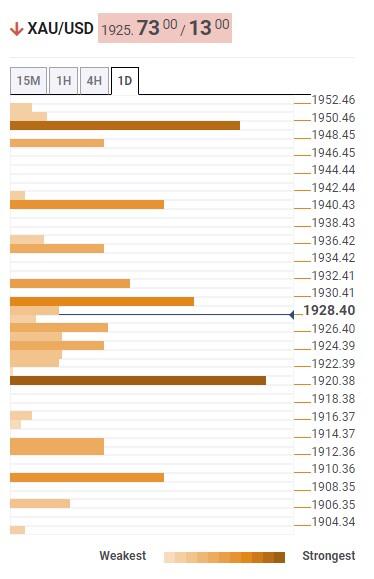
About Technical Confluences Detector
The TCD (Technical Confluences Detector) is a tool to locate and point out those price levels where there is a congestion of indicators, moving averages, Fibonacci levels, Pivot Points, etc. If you are a short-term trader, you will find entry points for counter-trend strategies and hunt a few points at a time. If you are a medium-to-long-term trader, this tool will allow you to know in advance the price levels where a medium-to-long-term trend may stop and rest, where to unwind positions, or where to increase your position size.
- GBP/USD has built an intermediate cushion around 1.2300 as USD Index faces selling pressure.
- Goldman Sachs sees two additional 25 bps rate hikes by the Fed after a 25 bp rate hike announcement on Wednesday.
- The BoE might continue with bigger interest rate hikes to tame soaring inflation.
The GBP/USD pair has gauged an intermediate cushion after dropping to near the crucial support around 1.2300 in the Asian session. The Cable has gained traction as the US Dollar Index (DXY) has retreated after a pullback move to near 101.80. It would be early to consider the halt in the Pound Sterling downside as a bullish reversal as the FX domain is likely to remain volatile ahead of the interest rate decision by the Federal Reserve (Fed).
Meanwhile, the risk profile is still in favor of safe-haven assets. S&P500 futures are carrying losses in Asia despite a bullish Tuesday session as investors are worried that the continuation of policy tightening by the Fed will dampen the scale of economic activities in the United States. Investors should brace for escalating recession fears and higher interest rates will put a dent in the morale of producers.
Contrary to the risk-aversion theme, the demand for US government bonds is increasing. This has led to a decline in the 10-year US Treasury yields below 3.51%.
Meanwhile, economists at Goldman Sachs have come up with expectations for dictations by Fed chair Jerome Powell in February’s monetary policy meeting. They believe that "Since the FOMC last met in December, incoming data on wage growth and inflation have been encouraging, while signals on activity growth have been mixed and at times concerning. This ended up making the case for slowing the pace of rate hikes to 25bp this week quite easy.”
For further guidance, Goldman Sachs expects two additional 25bp hikes in March and May, but fewer might be needed if weak business confidence depresses hiring and investment.
On the United Kingdom front, the absence of inflation slowdown signals and rising wage growth due to a tight labor market are bolstering the case of a higher interest rate hike by the Bank of England (BoE). As per the consensus, BoE Governor Andrew Bailey is expected to announce a 50 basis point (bps) interest rate hike to 4.00%.
- USD/IDR takes offers to refresh intraday low, snaps four-day uptrend.
- Indonesia Inflation eases to 5.28% YoY, 0.34% MoM during January.
- Mixed sentiment, sluggish yields and optimism in Asia-Pacific zone favor bears.
- FOMC is the key as 0.25% is priced in but Fed Chair Powell is a hawkish policymaker.
USD/IDR returns to the bear’s table after a four-day absence as it drops to $14,970 while refreshing intraday low during early Wednesday. In doing so, the Rupiah (IDR) ignores downbeat figures of Indonesia's Inflation while bracing for the Federal Open Market Committee (FOMC) monetary policy meeting.
That said, Indonesia Inflation eased in January to 5.28% YoY and 0.34% MoM, versus 5.51% and 0.66% respective priors. With this, the inflation gauges also remained below the market forecasts of 5.4% yearly and 0.47% monthly figures. Even so, the key statistics remain beyond Bank Indonesia’s (BI) target and underpin the IDR strength.
Other than the upbeat Indonesia data, cautious optimism in the Asia-Pacific region also seems to favor the USD/IDR bears. It’s worth noting that an index of the Asia-Pacific shares outside Japan prints 0.60% intraday gains by the press time while Indonesia’s benchmark IDX Composite rises 0.37% on a day.
On a broader front, the S&P 500 Futures prints mild losses while the US Treasury bond yields remain sluggish and pause the previous day’s pullback. That said, the US Dollar Index (DXY) struggles to reverse Tuesday’s losses around 102.10.
Elsewhere, downbeat US data strengthened the market’s dovish bias surrounding today’s Fed meeting. However, Fed Chair Jerome Powell’s last hawkish stand and readiness to defend the aggressive rate hikes challenge the USD/IDR downside.
That said, US Employment Cost Index (ECI) for the fourth quarter (Q4) eased to 1.0% versus 1.1% market forecasts and 1.2% prior readings. Further, the Conference Board (CB) Consumer Confidence eased to 107.10 in January versus 108.3 prior. It should be noted that no major attention could be given to the US Chicago Purchasing Managers’ Index (PMI) for January which rose to 44.3 versus 41 expected and 44.9 previous readings.
Moving on, US PMIs could entertain USD/IDR traders but major attention will be given to the Fed’s verdict and Chairman Jerome Powell’s press conference.
Also read: Federal Reserve Preview: The Good, the Bad and the Ugly, why the US Dollar would rise
Technical analysis
A clear downside break of the one-week-old ascending trend line join s Tuesday’s Doji candlestick to favor USD/IDR bears targeting the monthly low of $14,862.
- USD/INR has come out of the woods ahead of the Indian Union Budget announcement.
- The USD Index has rebounded as anxiety among investors has soared ahead of the Fed’s monetary policy.
- Consideration of a lower Fiscal Deficit and higher taxes in the Indian Union Budget could strengthen the Indian rupee.
The USD/INR pair has delivered an upside break of the consolidation formed in a narrow range of 81.66-81.77 in the Asian session. The asset is demonstrating optimism amid a recovery move shown by the US Dollar Index (DXY) after dropping to near 101.70.
Investors are getting anxious ahead of the interest rate decision by the Federal Reserve (Fed), therefore, the USD Index is fetching traction. The risk-averse theme is getting popular despite the being widely anticipated that the Fed will hike interest rates by 25 basis points (bps). S&P500 futures have faced immense pressure in the Asian session despite being heavily demanded on Tuesday. The alpha generated by the 10-year US Treasury bonds has dropped to 3.51%.
Apart from the Fed’s monetary policy, the release of the United States Automatic Data Processing (ADP) Employment data carries significant importance. According to the consensus, the US economy has generated fresh 170K jobs in January vs. the former release of 235K. Higher interest rates by Fed chair Jerome Powell to tame inflation have trimmed the demand for borrowings by corporate, which has led to a decline in the labor demand.
On the Indian rupee front, investors are awaiting the announcement of the Union Budget FY2023-24 by Indian Finance Minister Nirmala Sitharaman for fresh impetus. Consideration of lower Fiscal Deficit management and higher taxes by the Indian administration could strengthen the Indian rupee.
Meanwhile, the oil price is looking to extend its recovery above the immediate resistance of $79.50. Soaring expectations for higher oil demand amid a sheer economic recovery in China have strengthened the oil price. It is worth noting that India is one of the leading importers of oil and higher oil prices impact the Indian Rupee.
- AUD/USD renews intraday low amid sour sentiment, mixed data.
- China Caixin PMI fails to overcome 50.0 mark despite improving in January.
- Mixed concerns over RBA’s next move, especially after strong inflation and downbeat Retail Sales, weigh on Aussie prices.
- Cautious mood can weigh on risk-barometer pair ahead of Fed’s verdict.
AUD/USD takes offers to refresh intraday low around 0.7040 as the market’s anxiety ahead of the key Fed verdict amplifies during early Wednesday. Adding strength to the pullback moves could be the Chinese activity data from the industry group.
That said, China’s Caixin Manufacturing PMI rose to 49.2 versus 49.0 prior but eased below 49.5 market forecasts. Also, the below 50 readings for the sixth consecutive month adds strength to the bearish bias surrounding Australia’s biggest customer.
Elsewhere, RBA’s Head of the Economic Analysis Department Marion Kohler mentioned that the bank believes inflation peaked in Q4 of 2022. On the contrary, James Glynn from Wall Street Journal (WSJ) mentioned that the RBA is set to deliver a string of hikes and keep guidance hawkish during the next week’s monetary policy meeting.
It should be observed that the market sentiment turns sour after upbeat data as traders brace for today’s key Federal Open Market Committee (FOMC) monetary policy meeting amid receding fears of inflation and stagnant recession woes. Also making today’s Fed meeting interesting is Fed Chair Jerome Powell’s hawkish stand and readiness to defend the aggressive rate hikes even if the latest inflation cursors have been downbeat.
Against this backdrop, the S&P 500 Futures prints mild losses while the US Treasury bond yields remain sluggish and pause the previous day’s pullback. That said, the US Dollar Index (DXY) picks up bids to reverse Tuesday’s losses around 102.15.
Moving on, the Fed’s 0.25% rate hike is already given but Fed Chair Powell’s speech will be crucial.
Technical analysis
A daily closing below the one-month-old ascending trend line, around 0.7015 by the press time, becomes necessary to convince AUD/USD bears.
- USD/JPY remains depressed inside a fortnight-old triangle after reversing from one-week high.
- Convergence of 100-EMA, descending trend line from mid-December guards immediate upside.
- Sluggish RSI, multiple hurdles to the north challenge buyers.
- 200-EMA acts as the last defense for bears.
USD/JPY stays pressured around the 130.00 round figure, following a pullback from the one-week high, as the Yen pair traders remain cautious ahead of the Federal Reserve (Fed) monetary policy outcome on Wednesday.
Technically, the two-week-long symmetrical triangle restricts the immediate USD/JPY moves.
That said, the pair’s latest weakness could be linked to the failure to cross the downward-sloping resistance line from December 15 and the 100-bar Exponential Moving Average (EMA), around 130.30 by the press time. Also challenging the USD/JPY buyers could be the sluggish RSI (14) line.
It’s worth noting, however, that the pair sellers need to conquer the stated triangle’s support line, around 129.50 at the latest, to retake control. Following that, a slump toward the previous monthly low of 127.21 can’t be ruled out.
Alternatively, the 130.30 resistance confluence restricts immediate USD/JPY upside ahead of the aforementioned triangle’s top line, close to 130.55 as we write.
Should the Yen pair remains firmer past 130.55, the 200-EMA level surrounding 131.75 will act as the last defense of the bears, a break of which may open doors for the quote’s run-up towards the previous monthly high near 134.80.
USD/JPY: Four-hour chart
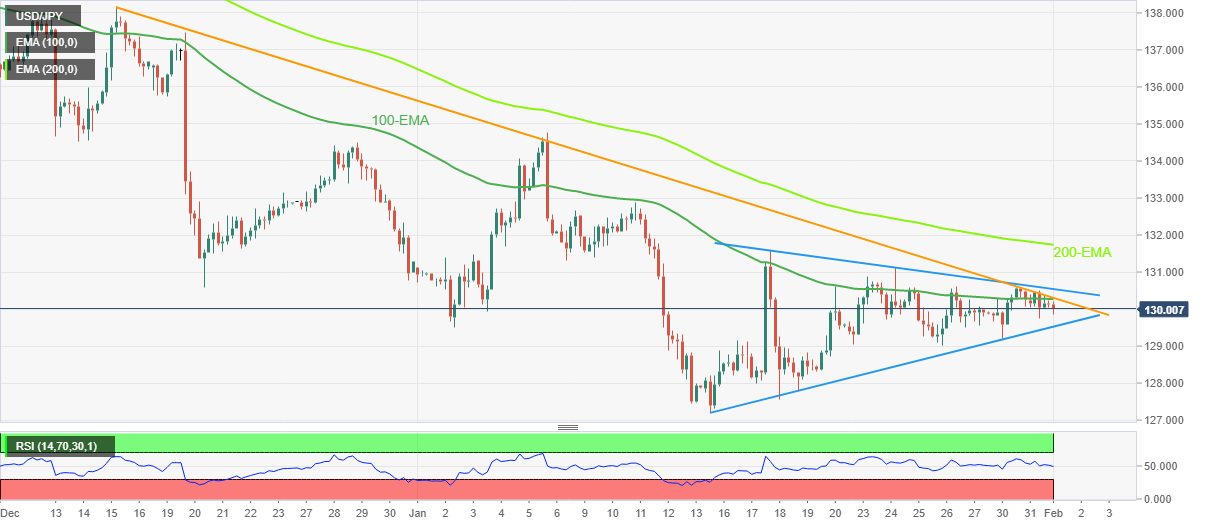
Trend: Pullback expected
- EUR/USD takes offers to refresh intraday low, reverses the previous day’s bounce off two-week low.
- US data amplifies Fed’s dovish hike concerns but downbeat German statistics also probe ECB hawks and probe EUR/USD rebound.
- Dicey markets ahead of PMIs, Fed trigger profit booking moves.
- Fed Chair Powell’s ability to defend hawks will be at test, rising wedge teases pair bears.
EUR/USD renews intraday bottom around mid-1.0800s as it reverses the previous day’s recovery moves during early Wednesday. In doing so, the major currency pair portrays the market’s anxiety ahead of the key Federal Open Market Committee (FOMC) monetary policy meeting. Also weighing on the quote could be the economic challenges to the bloc emanating from Germany, as well as the mixed data from the US and fears that Fed Chairman Jerome Powell will defend hawks anyhow.
On Tuesday, the preliminary readings of the Eurozone fourth-quarter (Q4) Gross Domestic Product (GDP) grew 0.1% QoQ versus 0.0% expected and 0.3% prior. The YoY prints also painted a rosy picture of the bloc as it rose past 1.8% market consensus to 1.9%, versus 2.3% prior. However, German Retail Sales plunged by 5.3% MoM in December, much worse than expected. Earlier in the week, German GDP also disappointed the EUR/USD pair traders.
Alternatively, US Q4 Employment Cost Index (ECI) eased to 1.0% versus 1.1% market forecasts and 1.2% prior readings. Further, the Conference Board (CB) Consumer Confidence eased to 107.10 in January versus 108.3 prior. It should be noted that no major attention could be given to the US Chicago Purchasing Managers’ Index (PMI) for January which rose to 44.3 versus 41 expected and 44.9 previous readings.
Elsewhere, firmer earnings data from the industry majors like General Motors, Exxon and McDonald’s pushed back recession woes in the US and propelled the Wall Street benchmarks. That said, the Dow Jones Industrial Average (DJIA), S&P 500 and Nasdaq all three reported over 1.0% daily gains the previous day. On the other hand, the US 10-year Treasury bond yields snapped a three-day uptrend while revisiting 3.51% while the two-year counterpart also dropped to 4.20%.
It should be noted that JP Morgan’s annual survey marked easing inflation fears and rising recession woes, which in turn probe the risk profile amid the pre-Fed anxiety. Even so, global rating giant Fitch expects the US Consumer Price Index (CPI) to moderate to mid-3.0% range in 2023 and a high-2.0% range in 2024, which in turn probes the EUR/USD bears.
Amid these plays, the S&P 500 Futures prints mild losses while the US Treasury bond yields remain sluggish and pause the previous day’s pullback. The same allows the EUR/USD pair to brace for the Fed’s dovish hike of 0.25%.
While the 0.25% Fed rate hike is almost given and priced in, the EUR/USD traders will also pay attention to the activity data for January and Jerome Powell’s ability to defend the aggressive rate hikes.
Also read: Federal Reserve Preview: The Good, the Bad and the Ugly, why the US Dollar would rise
Technical analysis
Failure to keep the bounce off the 21-day Exponential Moving Average (EMA), around 1.0800 by the press time, increases the odds of the EUR/USD pair’s confirmation of the three-month-old rising wedge bearish chart pattern by breaking the 1.0775 support.
| Raw materials | Closed | Change, % |
|---|---|---|
| Silver | 23.728 | 0.61 |
| Gold | 1928.1 | 0.28 |
| Palladium | 1647.88 | 0.89 |
Economists at Goldman Sachs provide a sneak peek at what they expect from the upcoming February US Federal Reserve (Fed) monetary policy decision.
Key quotes
"Since the FOMC last met in December, incoming data on wage growth and inflation have been encouraging, while signals on activity growth have been mixed and at times concerning. This ended up making the case for slowing the pace of rate hikes to 25bp this week quite easy.”
"The key question for the February meeting is what the FOMC will signal about further hikes this year. We expect two additional 25bp hikes in March and May, but fewer might be needed if weak business confidence depresses hiring and investment, or more might be needed if the economy reaccelerates as the impact of past policy tightening fades."
- USD/CNH has shown a V-shape recovery from 6.7480 amid a recovery in the USD Index.
- Caixin Manufacturing PMI has landed at 49.2 lower than the expectations of 49.5.
- The risk-perceived assets are facing the heat amid soaring anxiety ahead of the Fed’s monetary policy.
The USD/CNH pair has shown sheer volatility after the IHS Markit reported a lower-than-anticipated Caixin Manufacturing PMI data. The asset dropped to near 6.7480 but found a stellar buying interest and demonstrated a V-shape recovery above 6.7540. The economic data has landed at 49.2 lower than the expectations of 49.5 but higher than the former release of 49.0.
The street was expecting a better-than-expected performance after getting positive cues from China’s official Manufacturing PMI data. The official Manufacturing PMI released by China’s National Bureau of Statistics (NBS) landed at 50.1, higher than the consensus of 49.7 and the prior figure of 47.0.
It is worth noting that Chinese households remained busy in January’s last week for Lunar New Year celebrations, therefore, firms didn’t operate at full capacity. In spite of that, the Chinese economy maintained resilience in its production activities.
Meanwhile, the US Dollar Index (DXY) has extended its recovery above the immediate resistance of 101.75 as anxiety among investors is soaring ahead of the interest rate decision by the Federal Reserve (Fed). Also, investors are turning risk averse and therefore dumping the risk-perceived assets like S&P500 futures, which have extended their downside. The return generated by 10-year US Treasury bonds has dropped to 3.50% on expectations that Fed chair Jerome Powell will announce a smaller interest rate hike.
As per the CME FedWatch tool, the chances of a 25 basis point (bps) interest rate hike announcement by the Fed are more than 99%.
- EUR/GBP snaps two-day uptrend as it retreats from intraday high.
- Short-term key resistance line challenges buyers amid looming bear cross on MACD, RSI pullback.
- Convergence of 100-HMA, 200-HMA appears tough nut to crack for bears.
EUR/GBP returns to the bear’s radar, after a two-day off, as the quote mark another U-turn from the two-week-old descending resistance line during early Wednesday. That said, the cross-currency pair drops to 0.8818 by the press time.
Not only the multiple failures to cross the downward-sloping trend line from January 13 but the impending bear cross on the MACD and the RSI’s (14) retreat from the overbought territory also hint at the quote’s further weakness.
However, a convergence of the 100-Hour Moving Average (HMA) and the 200-HMA, around 0.8790 at the latest, put a floor under the EUR/GBP prices.
In a case where the EUR/GBP drops below the 0.8790 support confluence, a two-week-old ascending trend line, close to 0.8775 by the press time, could act as the last defense for the pair buyers.
On the contrary, a successful break of the aforementioned resistance line, close to 0.8825, could easily poke the previous weekly high near 0.8885.
Though, the EUR/GBP bulls need confirmation from the previous monthly high surrounding the 0.890 round figure to convince the buyers.
Overall, EUR/GBP is likely to witness further downside but the gap towards the north appears limited.
EUR/GBP: Hourly chart
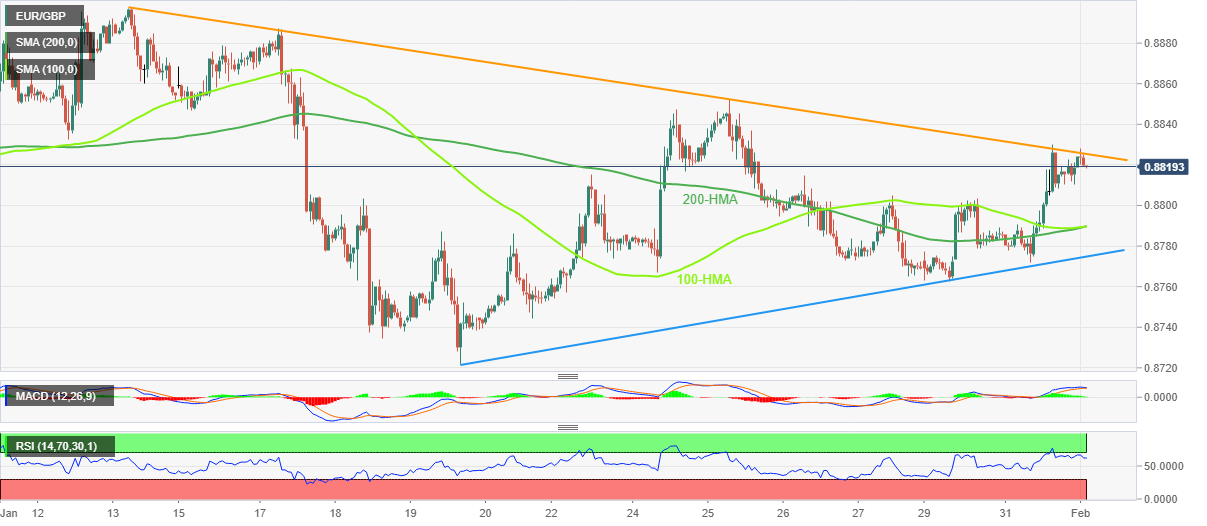
Trend: Limited downside expected
- USD/CAD bears on top below critical resistance.
- The bulls-eye a 50% mean reversion into the Fed.
USD/CAD is still under pressure on the front side of the bearish trendline as a quiet Asian session leaves the day ahead for where the action is bound to lie. The technicals are well entrenched for a breakout to the downside if the market gets what it's looking for from the meeting.
The following illustrates a bearish outlook for the short term to 1.3150 based on the daily and 1-hour charts:
USD/CAD daily charts

Zoomed in ...

With the breakout failure, the bears remain in control.
USD/CAD H1 chart

The bulls could be seeking a move to test the commitments of the bears again following the failed breakout with the 50% mean reversion resistance eyed as the above chart illustrates.
- Global markets portray typical pre-Fed anxiety amid dovish hike expectations.
- Wall Street benchmarks cheered downbeat US data, strong earnings from major players.
- US Treasury bond yields stay depressed as inflation fears recede.
- Multiple PMIs to entertain traders, Fed Chairman Jerome Powell’s speech will be the key.
Market sentiment remains sluggish as traders brace for the Federal Open Market Committee (FOMC) monetary policy meeting on Wednesday. Adding to the mixed concerns are the fears of hawkish comments from Fed Chair Jerome Powell and mixed feelings on inflation, not to forget an absence of major data during the Asian session.
While portraying the mood, S&P 500 Futures print mild gains while consolidating the biggest daily gains in a week whereas the US 10-year and two-year Treasury bond yields remain sluggish at around 3.51% and 4.20% by the press time.
It should be noted that the firmer earnings data from the industry majors like General Motors, Exxon and McDonald’s pushed back recession woes and propelled the Wall Street benchmarks. That said, the Dow Jones Industrial Average (DJIA), S&P 500 and Nasdaq all three reported over 1.0% daily gains the previous day. On the other hand, the US 10-year Treasury bond yields snapped a three-day uptrend while revisiting 3.51% while the two-year counterpart also dropped to 4.20%.
While US data could be held responsible for the market’s previous optimism, the latest concerns that Fed Chair Powell won’t respect doves seem to have portrayed the dicey moves. That said, US Employment Cost Index (ECI) for the fourth quarter (Q4) eased to 1.0% versus 1.1% market forecasts and 1.2% prior readings. Further, the Conference Board (CB) Consumer Confidence eased to 107.10 in January versus 108.3 prior. It should be noted that no major attention could be given to the US Chicago Purchasing Managers’ Index (PMI) for January which rose to 44.3 versus 41 expected and 44.9 previous readings.
On the other hand, JP Morgan’s annual survey marked easing inflation fears and rising recession woes, which in turn probe the risk profile amid the pre-Fed anxiety. Even so, global rating giant Fitch expects the US Consumer Price Index (CPI) to moderate to mid-3.0% range in 2023 and high-2.0% range in 2024.
Elsewhere, a minor increase in China’s private activity gauge, after a notable improvement in the official PMI, joins Nomura’s downbeat Gross Domestic Product (GDP) forecast for the dragon nation to also challenge the sentiment.
To sum up, the pre-Fed caution can keep grinding the markets even as the PMIs from Eurozone, the UK and the US could offer intermediate moves. It should be observed that the hawkish comments from Fed’s Powell can bolster the US Dollar and weigh on risk appetite.
Also read: Federal Reserve Preview: The Good, the Bad and the Ugly, why the US Dollar would rise
- Gold price has failed in recapturing the critical resistance of $1,930.00 as USD Index rebounds.
- The precious metal might continue its upside momentum as the Fed is expected to trim the policy tightening pace.
- Gold price has shown a V-shape recovery after dropping to near the round-level resistance of $1,900.00.
Gold price (XAU/USD) has corrected sharply after failing to recapture the critical resistance of $1,930.00 in the Asian session. The precious metal has witnessed a loss in the upside momentum as the US Dollar Index (DXY) is showing signs of recovery after dropping to near 101.70. The USD Index is gaining traction as investors are getting anxious ahead of the interest rate decision by the Federal Reserve (Fed).
The correction in the Gold price seems mild as Fed chair Jerome Powell is expected to further decelerate the pace of the interest rate hike. Meanwhile, S&P500 futures have eased some gains recorded on Tuesday as investors believe that further interest rate hikes by the Fed will escalate recession fears in the United States. The 10-year US Treasury yields have dropped below 3.52%.
Apart from the Fed’s monetary policy, US Automatic Data Processing (ADP) Employment data and ISM Manufacturing PMI will be of utmost importance. As per the consensus, the US economy has added fresh 170K jobs in January from the former release of 235K. While the Manufacturing PMI is expected to decline to 48.0 against 48.4 released earlier.
For a longer horizon, Reuters noted that higher interest rates by the Fed will limit the Gold price ahead. According to the Reuters poll, Gold price is expected to average $1,852.50 in 2023 and $1,890 in 2024.
Gold technical analysis
Gold price has shown a V-shape recovery after dropping to near the round-level resistance of $1,900.00 on an hourly scale. The precious metal has managed to shift its action above the horizontal resistance, which has become a support now, plotted from January 24 low at $1,914.19.
A bull cross, represented by the 20-and 50-period Exponential Moving Averages (EMAs) at $1,924.06, adds to the upside filters.
However, the Relative Strength Index (RSI) (14) still needs to show a confident bullish range shift for upside momentum.
Gold hourly chart
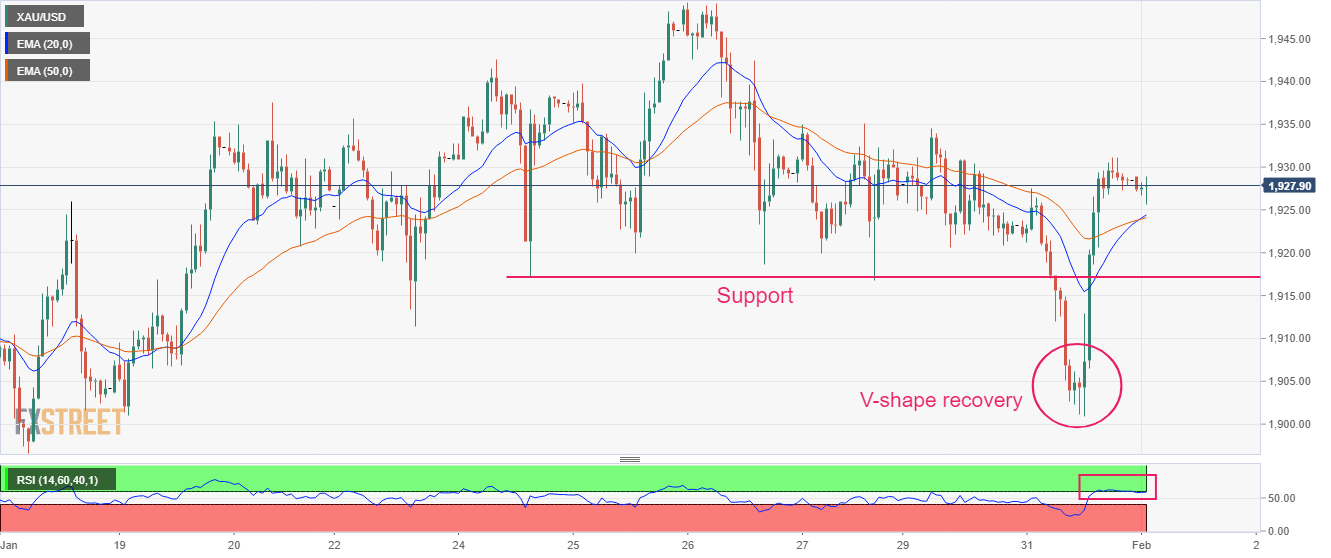
China's Caixin Manufacturing PMI for January rises slightly to 49.2 vs. 49.5 expected and 49.0 previous, showing the positive impact of the country’s covid reopening on the output levels.
Key points
Softer falls in output and new orders.
Supply chain pressures ease.
Confidence around the outlook hits highest since April 2021.
Wang Zhe, Senior Economist at Caixin Insight Group said, “Both manufacturing supply and demand continued to shrink last month, as Covid infections remained high. Output and total new orders shrank for the fifth and sixth straight months, respectively, but the contraction was milder than in December.”
“Due to mounting recession risks overseas, external demand remained weak, with the reading for new export orders also contracting for the sixth consecutive month,” Wang added.
AUD/USD remains unfazed near 0.7050
The downbeat print of the Chinese Manufacturing PMI has little to no impact on the Aussie Dollar, as AUD/USD is trading flat near 0.7050, at the time of writing.
- GBP/USD bears are in control and taking out structures along the way.
- The focus is on the Fed but the technicals remain biased to the downside.
GBP/USD is currently trading at 1.2310 and is around flat for the day ahead of the Federal Reserve and the Bank of England the following day where both events are expected to see the central banks hike their interest rates.
Meanwhile, from a technical standpoint, GBP/USD is on the back foot and has made a series of lower closes over the past few days, topping out from the 1.2440s made mid-January. As it breaks down various lower time frame structures and swing-lows, the bias remains in the hands of the bears for the foreseeable future as the following will illustrate.
GBP/USD daily chart

On the backside of the trend, the daily chart shows that the price is in a phase of probable distribution and there are eyes on a break of various daily structures on the downside with 1.2290 eyed first of all. A break below there opens the risk of a move test 1.2175 and then 12250.
GBP/USD H1 chart
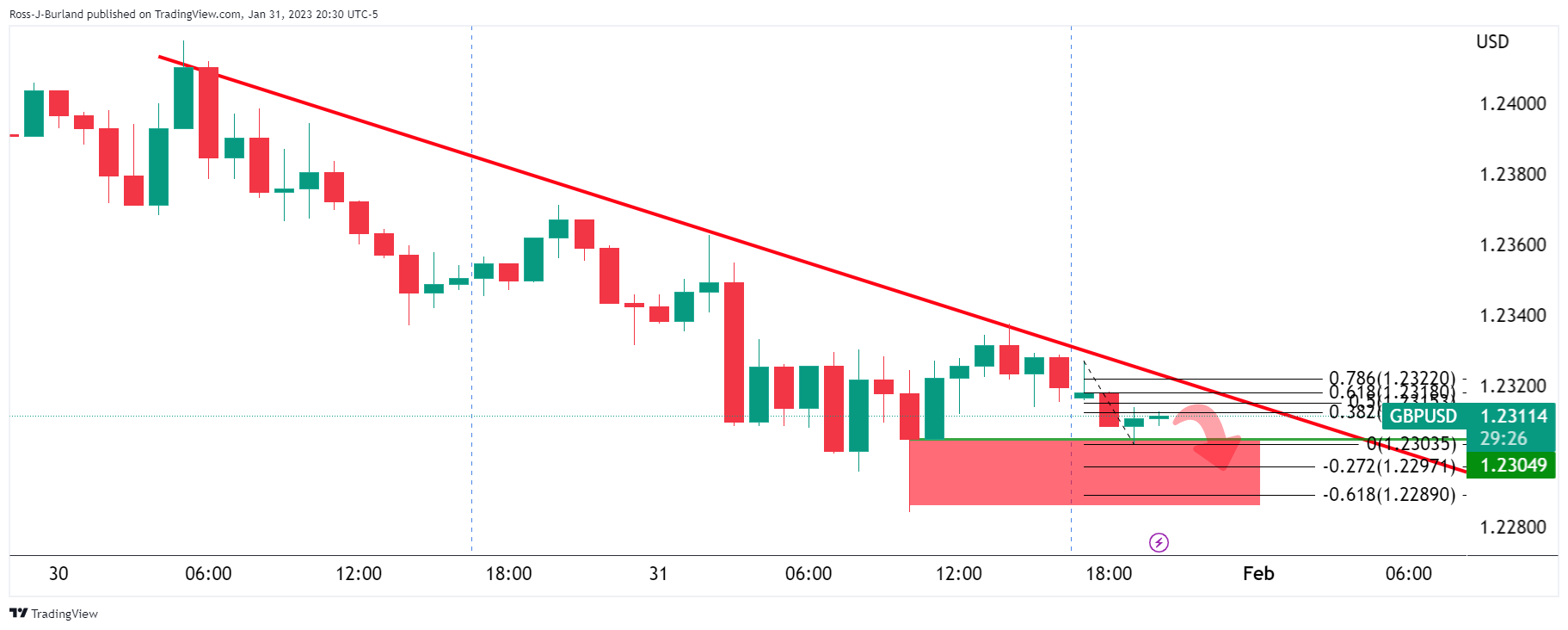
The bears are in control while being on the front side of the hourly trend. the bulls have tried to correct the recent bearish impulse into a 38.2% Fibonacci retracement level so far but a break of 1.2305 will open risks of a continuation towards 1.2280/90.
- GBP/JPY holds lower ground near 100-SMA support, down for the second consecutive day.
- Downbeat MACD signals, RSI (14) add strength to the bearish bias.
- Five-week-old descending resistance line holds the key to buyer’s conviction.
GBP/JPY fades the late Tuesday’s corrective bounce off the 100-bar Simple Moving Average (SMA) as it prints mild losses near the 160.00 psychological magnet during early Wednesday. In doing so, the cross-currency pair keeps the previous week’s retreat from a one-month high.
Not only the failure to defend the bounce off 100-SMA but bearish MACD signals and downbeat RSI (14), not oversold, also keeps GBP/JPY bears hopeful.
However, a clear downside break of the stated SMA level surrounding 159.70 becomes necessary for the GBP/JPY bears.
Following that, the January 19 swing low near 157.60 could act as a buffer during the fall targeting the previous monthly low of 155.36. It should be noted that May 2022 low near 155.60 also challenges the short-term GBP/JPY bears.
Meanwhile, recovery moves may aim for the latest peak surrounding 161.45 before approaching a downward-sloping resistance line from late December 2022, close to 161.65 at the latest.
In a case where the quote rises past 161.65, the 50% Fibonacci retracement of GBP/JPY downbeat between late 2022 and early January 2023, around 162.30, could act as the last defense of the bears.
To sum up, GBP/JPY is likely to remain bearish even if the 100-SMA challenges the immediate downside.
GBP/JPY: Four-hour chart
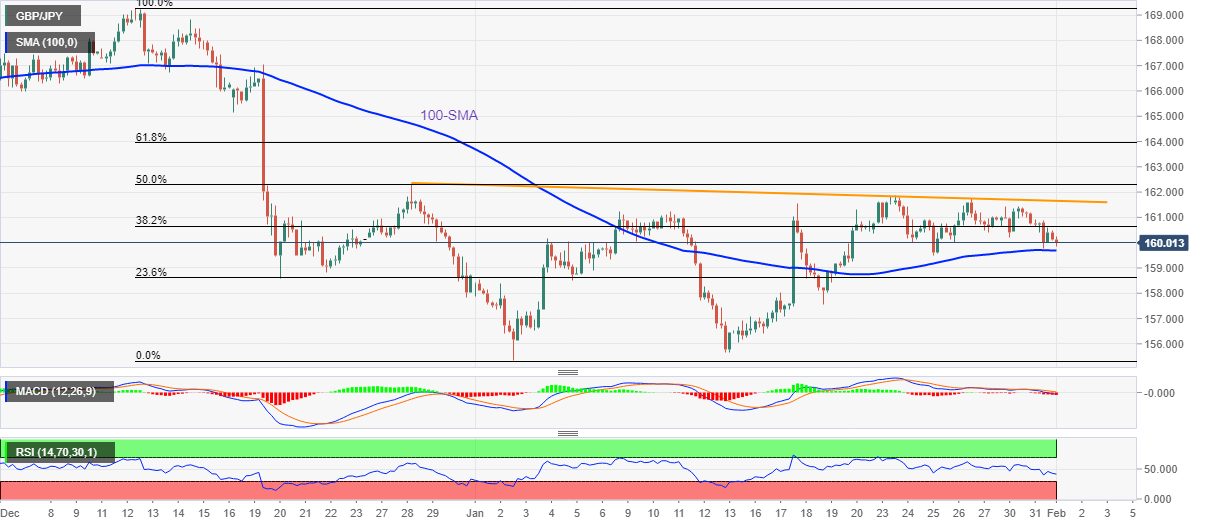
Trend: Further downside expected
- AUD/JPY has dropped firmly amid expectations that the Australian economy has seen inflation peak in Q4 last year.
- The RBA might continue hiking interest rates as the inflation rate is extremely far from the 25 inflation target.
- Japan’s officials are continuously reiterating the need for wage growth for the BoJ and the government.
The AUD/JPY pair has slipped below 91.60 after failing to kiss the crucial resistance of 92.00 in the late New York session. The risk barometer has lost strength and is declining firmly after commentary from the Reserve Bank of Australia’s (RBA) head of economic analysis Marion Kohler.
RBA’s Kohler is of the view that the Australian economy has seen the inflation peak at 7.8% in the fourth quarter of CY2022 and now the price pressures may start declining ahead. Last week, the Australian Bureau of Statistics reported a jump in the inflation rate to 7.8% amid supply chain bottlenecks and rising food prices.
Meanwhile, a decline in monthly Retail Sales (Dec) data released this week supports the view of RBA’s Kohler of inflation softening ahead. The economic data contracted by 3.9% from an expansion of 1.7% released in November while the street was expecting a contraction of 0.3%. A contraction in retail demand is a critical indicator for inflation projection as lower consumer spending calls for a decline in the prices of goods and services by producers at factory gates to maintain the demand-supply mechanism.
However, RBA Governor Philip Lowe might continue hiking interest rates further as the road to recovery is far from over. The RBA is expected to continue the 25 basis points (bps) interest rate hike spell to tame stubborn inflation.
On the Japanese Yen front, Japan's Finance Minister Shunichi Suzuki reiterated on Tuesday that “wage increases are important to both the government and the Bank of Japan (BoJ).
As global markets keenly await the US Federal Reserve (Fed) monetary policy decision on Wednesday, JP Morgan released details of its latest survey highlighting easy inflation and recession woes.
“Most traders believe global inflation has peaked, while the potential recession has emerged as the main risk to markets this year,” said JP Morgan’s annual survey of institutional and professional trading clients.
It’s worth noting that 30% of respondents marked the global downturn as their top concern in the latest survey, up from the previous 5.0%.
Additional findings
44% of the 835 respondents predicted inflation will decrease in 2023.
A further 37% forecast that price rises would level off.
Also read: US Dollar Index probes DXY bears above 102.00 as Fed interest rate hike looms
In recent trade today, the People’s Bank of China (PBOC) set the yuan at 6.7492 vs. the last close of 6.7531.
About the fix
China maintains strict control of the yuan’s rate on the mainland.
The onshore yuan (CNY) differs from the offshore one (CNH) in trading restrictions, this last one is not as tightly controlled.
Each morning, the People’s Bank of China (PBOC) sets a so-called daily midpoint fix, based on the yuan’s previous day's closing level and quotations taken from the inter-bank dealer.
- AUD/USD fades the previous day’s rebound from one-week low, sidelined of late.
- RBA’s Kohler conveys dovish bias by signalling peak of Aussie inflation in Q4 2022.
- Downbeat US data, yields favored Aussie pair buyers but cautious mood ahead of Fed probe recovery moves.
- As 0.25% rate hike is already given, Fed Chairman Jerome Powell’s press conference will be crucial to watch.
AUD/USD pares the previous day’s recovery from the weekly bottom as it eases to 0.7050 during early Wednesday. The Aussie pair’s latest weakness could be linked to the cautious mood ahead of the Federal Reserve’s (Fed) key monetary policy meeting and downbeat comments from the Reserve Bank of Australia (RBA) policymaker.
Recently, RBA’s Head of the Economic Analysis Department Marion Kohler mentioned that the bank believes inflation peaked in Q4 of 2022. Earlier in the day, Australia’s S&P Global Manufacturing PMI rose to 50.0 for January versus 49.8 market forecasts and prior.
On the other hand, the S&P 500 Futures print mild losses by the press time while the US Treasury bond yields also struggle for clear directions as market sentiment dwindles ahead of the Fed’s verdict, amid dovish hike expectations.
It’s worth noting that the US Dollar Index (DXY) printed the first daily loss in four on Tuesday amid downbeat US data and Treasury bond yields, staying defensive near 102.00 by the press time.
That said, the US Employment Cost Index (ECI) for the fourth quarter (Q4) eased to 1.0% versus 1.1% market forecasts and 1.2% prior readings. Further, the Conference Board (CB) Consumer Confidence eased to 107.10 in January versus 108.3 prior. It should be noted that no major attention could be given to the US Chicago Purchasing Managers’ Index (PMI) for January which rose to 44.3 versus 41 expected and 44.9 previous readings.
In addition to the mostly downbeat US data, firmer earnings data from the industry majors like General Motors, Exxon and McDonalds pushed back recession woes and propelled the Wall Street benchmarks, which in turn weighed on the US Treasury bond yields and the DXY. That said, the Dow Jones Industrial Average (DJIA), S&P 500 and Nasdaq all three reported over 1.0% daily gains the previous day.
Amid these plays, the US 10-year Treasury bond yields snapped a three-day uptrend while revisiting 3.51% while the two-year counterpart also dropped to 4.20%, pressured near the same levels by the press time.
Looking forward, AUD/USD traders should pay attention to China Caixin Manufacturing PMI for immediate directions but major attention will be given to the Fed’s ability to defy dovish expectations and the DXY bears readiness to retake control.
Technical analysis
Tuesday’s Dragonfly Doji candlestick and the 10-DMA, around 0.7045 by the press time, challenge AUD/USD sellers.
- NZD/USD has dropped firmly after sensing deep selling interest while testing the consolidation breakdown.
- Investors’ risk-taking capacity is dropping ahead of the interest rate decision by the Fed.
- The 20-EMA has acted as a major barricade for the New Zealand Dollar.
The NZD/USD pair has resumed its downside journey after a pullback move to near 0.6440 in the Asian session. The kiwi asset is unable to keep up its feet amid the release of lower-than-anticipated New Zealand Employment data. The major has shifted into a negative trajectory as the strength of the cheerful market mood is fading away.
S&P500 futures are facing heat in the Asian session despite a bullish Tuesday ahead of the interest rate decision by the Federal Reserve (Fed), and United States ADP Employment and ISM Manufacturing PMI data. The US Dollar Index (DXY) is looking to build a cushion around 101.70 after a declining move.
NZD/USD has sensed selling interest after testing the strength of the consolidation breakdown in the 0.6450-0.6470 range on a four-hour scale. Earlier, the Kiwi asset shifted into a negative trajectory after delivering a downside break of the Rising Wedge chart pattern, which indicates a bearish reversal after a loss in the upside momentum.
The 20-period Exponential Moving Average (EMA) at 0.6463 has acted as a major barricade for the New Zealand Dollar.
In addition to that, the Relative Strength Index (RSI) (14) has slipped into the bearish range of 20.00-40.00, which conveys an activation of the downside momentum.
For the downside move, a breakdown below January 31 low at 0.6412 will drag the Kiwi asset toward January 17 low at 0.6366 followed by January 12 low around 0.6300.
On the flip side, the asset needs to surpass Wednesday’s high at 0.6530 for a resumption in the upside, which will drive the asset toward June 3 high at 0.6576. A breach of the latter will expose the asset to the round-level resistance at 0.6600.
NZD/USD four-hour chart
-638108091746253955.png)
- Silver price reverses the previous day’s corrective bounce off weekly low.
- Sluggish MACD signals, multiple failures to cross the two-week-old descending trend line favor bears.
- XAG/USD buyers need to portray successful trading beyond $24.00.
Silver price (XAG/USD) remains sidelined near the mid-$23.00s amid early Wednesday’s sluggish Asian session.
In doing so, the bright metal struggles to defend the previous day’s rebound from $23.00, the first positive day in four, while retreating from the 100-bar Simple Moving Average (SMA), around $23.70 by the press time.
Also keeping the XAG/USD bears hopeful are the sluggish MACD signals that challenge Tuesday’s corrective bounce.
It’s worth noting that the metal’s sustained run-up beyond the $23.70 hurdle also may not convince the Silver buyers as a downward-sloping resistance line from January 16, near $23.85 at the latest, challenges the metal’s advances.
Additionally, acting as an upside filter is the $24.0 round figure, a break of which could quickly propel the XAG/USD price towards the previous monthly peak near $24.55.
On the flip side, Silver’s pullback moves again highlight the $23.00 round figure ahead of the previous weekly low near $22.75.
In a case where XAG/USD bears keep the reins past $22.75, December 2022 bottom surrounding $22.00 will be in focus.
Overall, Silver price remains on the buyer’s radar despite the latest failures to cross short-term key hurdles.
Silver price: Four-hour chart
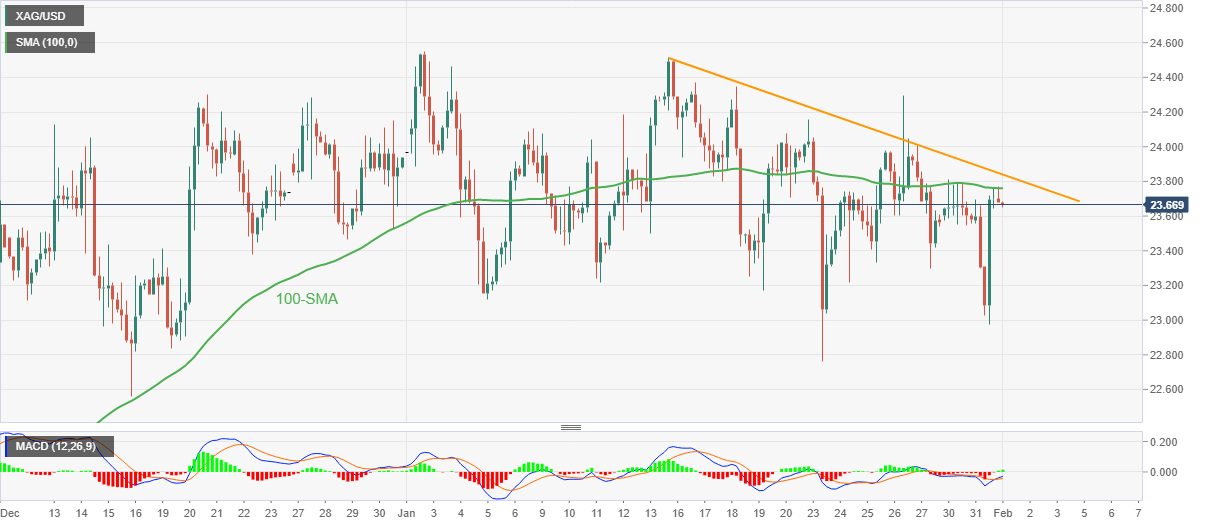
Trend: Slow recovery expected
Reserve Bank of Australia's head of economic analysis Marion Kohler said they believe that the peak of inflation was in the fourth quarter.
Opening statement to the Senate Select Committee on the cost of living:
Good morning chair and members of the Committee.
Thank you for holding this hearing. The Reserve Bank welcomes the opportunity to contribute to these discussions about the cost-of-living pressures that households in Australia are currently facing. Cost of living is an important issue for all Australians. A rising cost of living puts pressure on household budgets across the country. Many people are understandably concerned about how they and others will manage through a period when the cost of living has increased considerably.
The cost-of-living pressures currently being faced by all Australians are a result of a substantial rise in the rate of inflation over the past year or so. Annual inflation as measured by the Consumer Price Index (CPI) has increased from a little below 2 per cent in the years immediately prior to the pandemic to around 8 per cent at the end of 2022. Prices have risen significantly for many of the goods and services that people buy. Today, the higher cost of living is front of mind for many more people than was the case in the years leading up to the pandemic.
Most advanced countries have experienced a large increase in inflation over the past year or so. A big driver of higher prices was unpredictable shocks to supply that affected many countries. Most notable are the pandemic disruptions to global supply chains and Russia's invasion of Ukraine. In Australia, we also had flooding on the east coast that affected supply here. But strong growth in domestic demand has also played a role in many countries.
Different groups in society have different patterns of spending, so their experience of cost of living can vary from the national average. Lower income households typically have the most constrained budgets. These households, including those on the age pension and other welfare payments, tend to spend more of their income on essential items such as food, utilities and rent. Higher income households tend to spend more on items like owner-occupied housing and so-called discretionary items such as recreation and consumer durables.
Despite these differences, in Australia most groups in society have seen their cost of living increase by roughly the same extent over the most recent period. This is because the increase in inflation so far has been quite broadly based. This has not been the case in some other countries, particularly in Europe. There, lower income households have been hit relatively harder by higher energy prices than higher income households have been.
It is clear that the cost of living in Australia has increased significantly. But that is not the full picture. What matters also is whether people's means to pay these costs - their incomes - have kept pace. Over the past year or so, consumer prices have grown faster than households' disposable incomes, meaning that real incomes have declined overall.
The experience of individual households varies widely. Hourly wages have picked up, but not by as much as inflation, and so some workers who have remained in the same job and with the same hours will have seen their real incomes decline significantly. Still, many households have been able to benefit from the strong labour market. Some now have a job who previously didn't, while others have been able to pick up more hours or move to a better paying job. The large increase in the minimum and award wages in the middle of last year has also helped many households. And most welfare payments are indexed to inflation, which should help support the incomes of many lower-income households.
While those relying on interest income - such as self-funded retirees - have seen their incomes boosted by higher interest rates over the past year, those with mortgages will be feeling the effects of the rise in interest rates. We understand that some people are finding the rise in interest rates difficult to manage and others will have to cut back on discretionary spending. However, higher interest rates are necessary to ensure that the current period of higher inflation and cost of living pressures does not persist too long. As the Governor has emphasised, the Reserve Bank Board is focused on returning inflation to target and establishing a more sustainable balance of demand and supply in the Australian economy.
We are currently revising our forecasts and will publish these at the end of next week, so we are not in a position to preview them yet. What we can say is that we think the peak in inflation was at the end of 2022 - at around 8 per cent - and that inflation will begin to ease over the course of this year.
Thank you. My colleague and I are here to answer your questions.
AUD/USD update
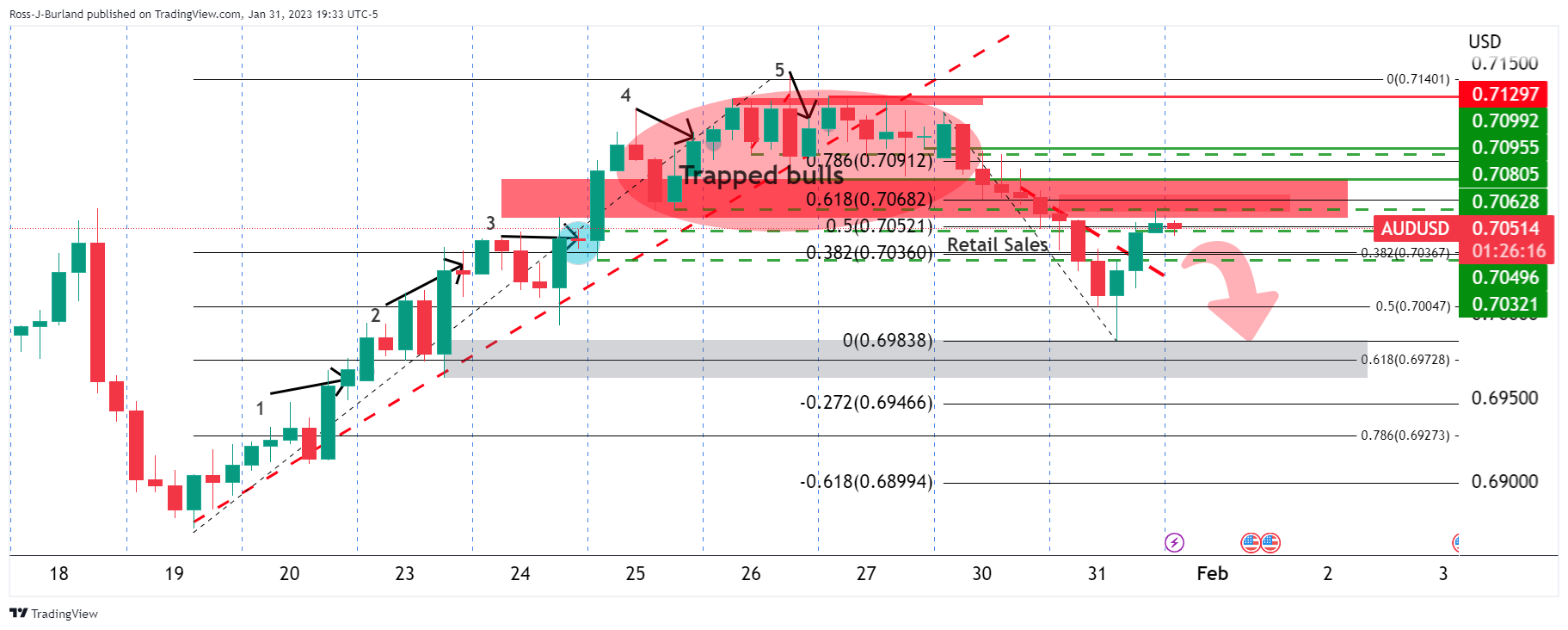
The price is breaking down below an area where bulls were rapped up high chasing the breakout of 0.7050 and 0.7100 following five days of rise. The Retail Sales miss sent the pair lower and back below 0.7050. The correction is firm but has decelerated at 0.7050 in a 50% mean reversion of the bearish leg and could now be starting to move lower again for a downside extension towards the prior lows near 0.6980. A Break there opens risk to 0.6950 in the first instance.
| Index | Change, points | Closed | Change, % |
|---|---|---|---|
| NIKKEI 225 | -106.29 | 27327.11 | -0.39 |
| Hang Seng | -227.4 | 21842.33 | -1.03 |
| KOSPI | -25.39 | 2425.08 | -1.04 |
| ASX 200 | -5 | 7476.7 | -0.07 |
| FTSE 100 | -13.2 | 7771.7 | -0.17 |
| DAX | 2.19 | 15128.27 | 0.01 |
| CAC 40 | 0.41 | 7082.42 | 0.01 |
| Dow Jones | 368.95 | 34086.04 | 1.09 |
| S&P 500 | 58.83 | 4076.6 | 1.46 |
| NASDAQ Composite | 190.74 | 11584.55 | 1.67 |
- USD/JPY picks up bids to pare recent losses but stays indecisive on a daily basis.
- Downbeat US data, yields joined BoJ loans, fears of government intervention to favor Yen pair sellers.
- 10-year Japan Government Bond (JGB) yields keeps pushing BoJ to defend YCC policy.
- Fed Chair Powell’s press conference will be crucial as dovish hike already priced in.
USD/JPY consolidates recent losses around 130.20, posting minor gains as market players appear cautious ahead of the key Federal Reserve (Fed) verdict. Also challenging the sentiment, as well as the Yen pair, could be the latest moves of the Japan Government Bond (JGB) yields.
The benchmark 10-year JGB yields keeps poking the Bank of Japan’s (BoJ) 0.50% limit during the seven-day uptrend. The same has recently pushed the Japanese central bank to intervene multiple times. On the same line were fears of government meddling which were raised by Hirohide Yamaguchi, one of the top candidates to become the next BoJ Governor.
On the other hand, the US 10-year Treasury bond yields snapped a three-day uptrend while revisiting 3.51% while the two-year counterpart also dropped to 4.20%, near the same levels by the press time.
It should be noted that downbeat US Treasury bond yields joined and firmer equity earnings and softer US data to renew the US Dollar weakness and strengthened the USD/JPY pullback.
That said, the US Dollar Index (DXY) printed the first daily loss in four on Tuesday, staying defensive near 102.00 by the press time.
Talking about the data, US Employment Cost Index (ECI) for the fourth quarter (Q4) eased to 1.0% versus 1.1% market forecasts and 1.2% prior readings. Further, the Conference Board (CB) Consumer Confidence eased to 107.10 in January versus 108.3 prior. It should be noted that no major attention could be given to the US Chicago Purchasing Managers’ Index (PMI) for January which rose to 44.3 versus 41 expected and 44.9 previous readings.
Elsewhere, earnings data from the industry majors like General Motors, Exxon and McDonalds pushed back recession woes and propelled the Wall Street benchmarks, which in turn weigh on the US Treasury bond yields and the DXY. That said, the Dow Jones Industrial Average (DJIA), S&P 500 and Nasdaq all three reported over 1.0% daily gains the previous day.
Looking ahead, multiple PMIs from China, Eurozone and the US may entertain the USD/JPY traders, as well as the JGB moves. However, major attention will be given to the Federal Reserve (Fed) meeting as the 0.25% rate hike is already priced-in while the policy pivot talks challenge the US Dollar bulls.
Also read: Federal Reserve Preview: The Good, the Bad and the Ugly, why the US Dollar would rise
Technical analysis
A two-week-old symmetrical triangle restricts USD/JPY moves between 129.60 and 130.50.
- EUR/USD bulls remain in play above 1.0850 on the front side of the daily trendline support.
- 1.0900 comes in at the target with 1.0920 above there as a potential liquidity zone.
EUR/USD is at an important juncture on the charts ahead of the Federal Reserve event whereby there are prospects of a significant correction if the market finds itself wrong on the Fed. However, in the meanwhile, a move to test 1.0920 could be on the cards.
EUR/USD daily charts
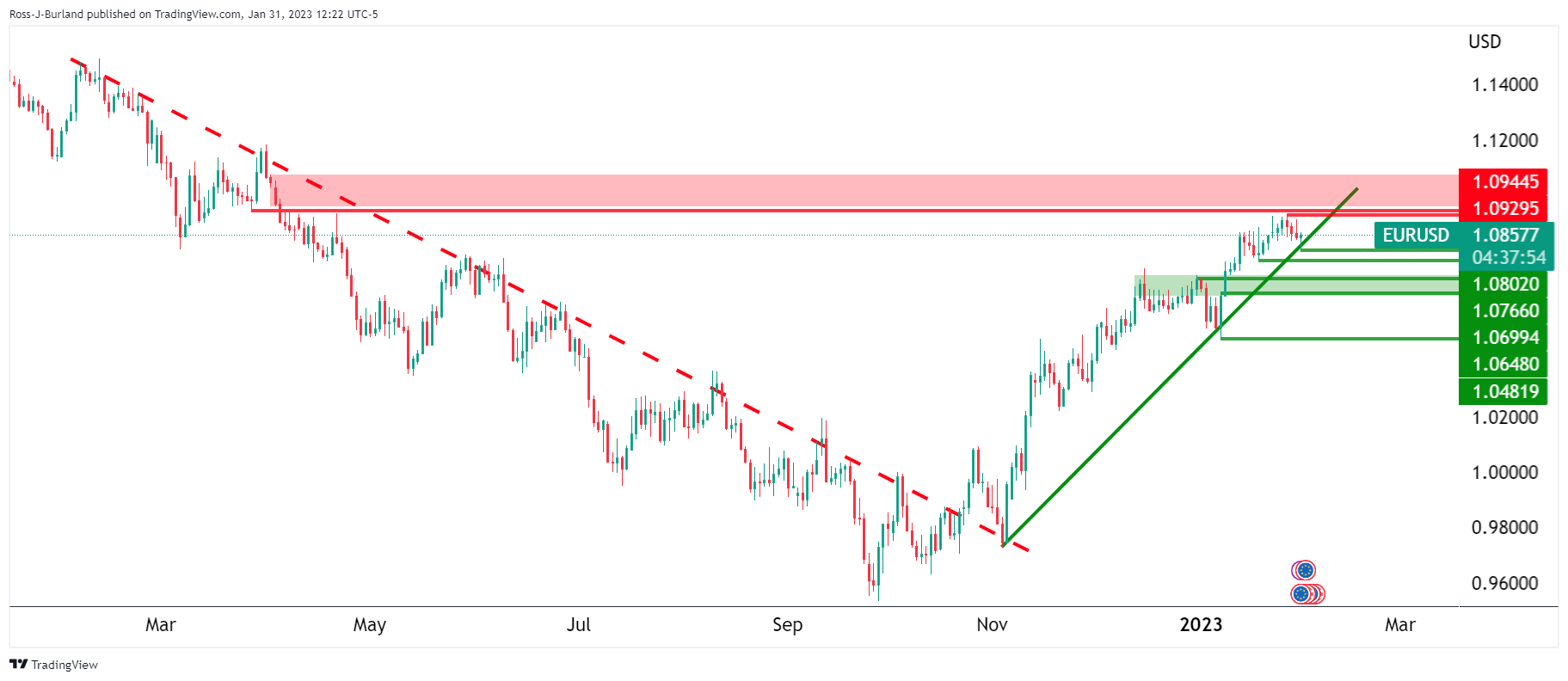

A break of the bull cycle's trendline support and a hawkish outcome at the Fed would see the price plummet over time for a test all the way down to 1.0650/00.
EUR/USD H4 chart

The price has broken the structure and this leaves the bias to the upside for the sessions ahead of the Federal Reserve. The support comes in near a 38.2% Fibonacci retracement of the prior bullish 4-hour impulse where a correction would be expected to decelerate. This comes in at 1.0850. On the upside, 1.0900 comes in at the target with 1.0920 above there as a potential liquidity zone.
| Pare | Closed | Change, % |
|---|---|---|
| AUDUSD | 0.70546 | -0.04 |
| EURJPY | 141.341 | -0.08 |
| EURUSD | 1.08642 | 0.14 |
| GBPJPY | 160.266 | -0.46 |
| GBPUSD | 1.23194 | -0.2 |
| NZDUSD | 0.64434 | -0.32 |
| USDCAD | 1.33022 | -0.59 |
| USDCHF | 0.91607 | -0.88 |
| USDJPY | 130.093 | -0.26 |
- EUR/GBP has managed to sustain above 0.8800 despite the expectations of a slowdown in the Eurozone HICP.
- Softening energy prices have trimmed inflation projections for Eurozone and the UK.
- The ECB and the BoE are expected to announce an interest rate hike of 50 bps.
The EUR/GBP pair has recovered sharply after a minor correction to near 0.8800 in the Asian session. The cross has scaled to near 0.8822 and is expected to refresh a three-day high above 0.8830 ahead of the release of the preliminary Eurozone Harmonized Index of Consumer Prices (HICP).
Analysts at TD Securities have come out with bold softening estimates for the headline Eurozone HICP. Analysts expect “New energy subsidies likely pulled down German headline HICP for the third consecutive month. Combined with further household support in the Netherlands and the impact of lower wholesale energy prices, this should push Eurozone headline inflation down to 8.4% YoY. While the core HICP that excludes oil and food prices is seen as steady.
This indicates that the major catalyst, which is promising a deceleration in the price index pressures is the softened energy prices.
A decline in the Eurozone HICP might not impact the interest rate decision by the European Central Bank (ECB) ahead. Considering the fact that the inflationary pressures are multi-times higher than the 2% inflation target, ECB President Christine Lagarde would stand to the expectations of a 50 basis point (bps) interest rate hike on Thursday.
On the United Kingdom front, UK public's inflation expectations cooled off for the second straight month in January, a monthly survey conducted by Citi and YouGov. This seems to be the impact of declining energy prices, which remained a major steroid for UK inflation prior. However, Bank of England (BoE) Governor Andrew Bailey might continue hiking interest rates by 50 bps further as the road to 2% inflation is far from over. A poll from Bloomberg showed that the BoE will reach the terminal rate of 4.50% by the summer.
- US Dollar steadies after snapping three-day winning streak.
- Market’s anxiety probes DXY bears as US stock futures fail to trace Wall Street, yields stabilize.
- Downbeat US data, yields weighed on the USD the previous day.
- Fed Chairman Jerome Powell has a tough task of defending US Dollar bulls amid dovish hike expectations.
US Dollar Index (DXY) portrays the typical pre-Fed anxiety by making rounds to 102.10 during early Wednesday. In doing so, the greenback’s gauge versus the six major currencies cites the market’s fears of a hawkish surprise from Fed Chairman Jerome Powell while battling the previous day’s downbeat US data and yields.
That said, the DXY dropped the most in a week while snapping a three-day uptrend on Tuesday as US employment cost numbers back the concerns surrounding easy inflation. The same joined the upbeat equity earnings to propel equities and weighed on the US Treasury bond yields, which in turn exerted downside pressure on the US Dollar Index.
US Employment Cost Index (ECI) for the fourth quarter (Q4) gained major attention as it eased to 1.0% versus 1.1% market forecasts and 1.2% prior readings. Further, the Conference Board (CB) Consumer Confidence eased to 107.10 in January versus 108.3 prior. It should be noted that no major attention could be given to the US Chicago Purchasing Managers’ Index (PMI) for January which rose to 44.3 versus 41 expected and 44.9 previous readings.
Elsewhere, earnings data from the industry majors like General Motors, Exxon and McDonalds pushed back recession woes and propelled the Wall Street benchmarks, which in turn weigh on the US Treasury bond yields and the DXY. That said, the Dow Jones Industrial Average (DJIA), S&P 500 and Nasdaq all three reported over 1.0% daily gains on Tuesday. The same weighed on the benchmark 10-year Treasury bond yields which snapped a three-day uptrend while revisiting 3.51% while the two-year counterpart also dropped to 4.20%, near the same levels by the press time.
Even so, the S&P 500 Futures print mild losses by the press time and probe the DXY bears amid the pre-Fed anxiety. Also challenging the US Dollar bears are the steady yields.
Moving on, a slew of US activity data for January may entertain the US Dollar Index traders but major attention will be on how Fed Chairman Jerome Powell could defend his hawkish bias as the 0.25% rate hike is already priced-in. In case of a hawkish surprise, the DXY could portray the much-awaited recovery.
Also read: Federal Reserve Preview: The Good, the Bad and the Ugly, why the US Dollar would rise
Technical analysis
A retreat from 21-day Exponential Moving Average (EMA), currently around 102.60, keeps DXY bears hopeful of revisiting the previous monthly low of 101.50.
© 2000-2025. Bản quyền Teletrade.
Trang web này được quản lý bởi Teletrade D.J. LLC 2351 LLC 2022 (Euro House, Richmond Hill Road, Kingstown, VC0100, St. Vincent and the Grenadines).
Thông tin trên trang web không phải là cơ sở để đưa ra quyết định đầu tư và chỉ được cung cấp cho mục đích làm quen.
Giao dịch trên thị trường tài chính (đặc biệt là giao dịch sử dụng các công cụ biên) mở ra những cơ hội lớn và tạo điều kiện cho các nhà đầu tư sẵn sàng mạo hiểm để thu lợi nhuận, tuy nhiên nó mang trong mình nguy cơ rủi ro khá cao. Chính vì vậy trước khi tiến hành giao dịch cần phải xem xét mọi mặt vấn đề chấp nhận tiến hành giao dịch cụ thể xét theo quan điểm của nguồn lực tài chính sẵn có và mức độ am hiểu thị trường tài chính.
Sử dụng thông tin: sử dụng toàn bộ hay riêng biệt các dữ liệu trên trang web của công ty TeleTrade như một nguồn cung cấp thông tin nhất định. Việc sử dụng tư liệu từ trang web cần kèm theo liên kết đến trang teletrade.vn. Việc tự động thu thập số liệu cũng như thông tin từ trang web TeleTrade đều không được phép.
Xin vui lòng liên hệ với pr@teletrade.global nếu có câu hỏi.
